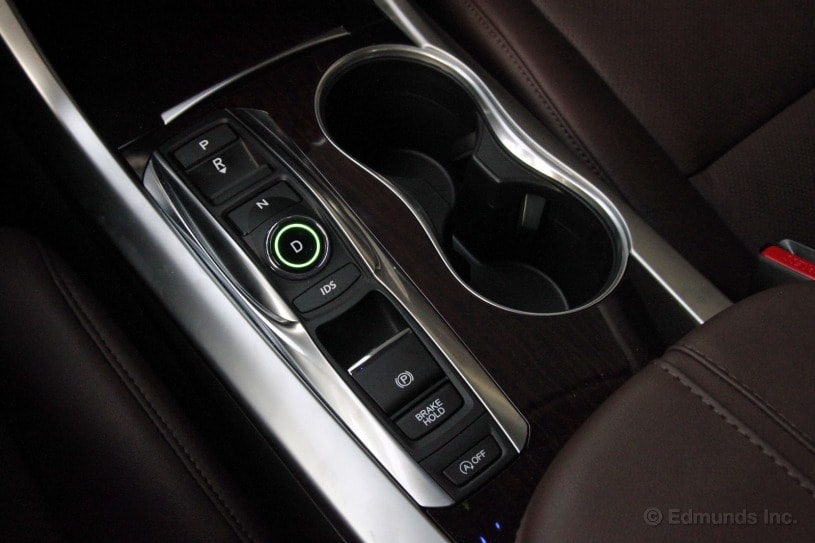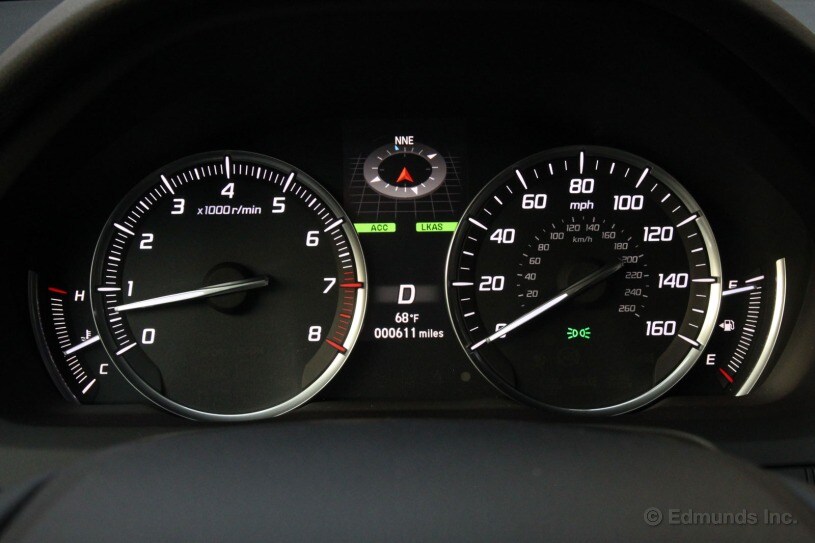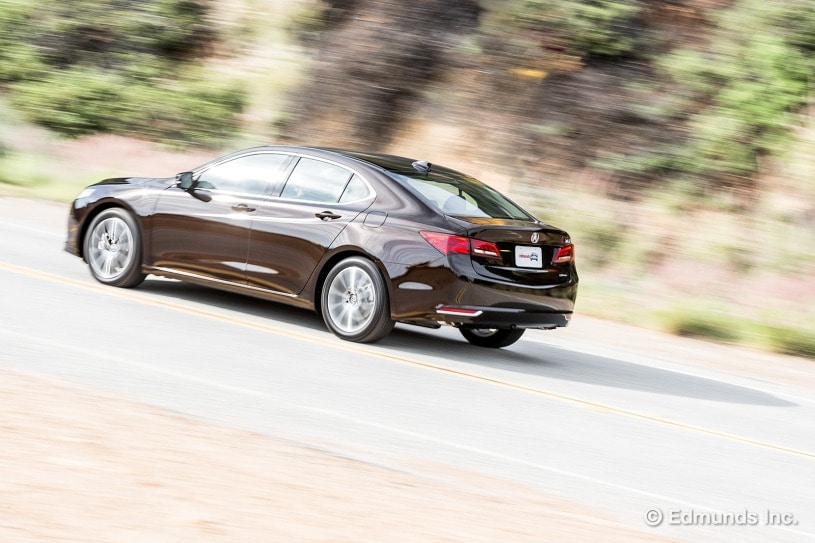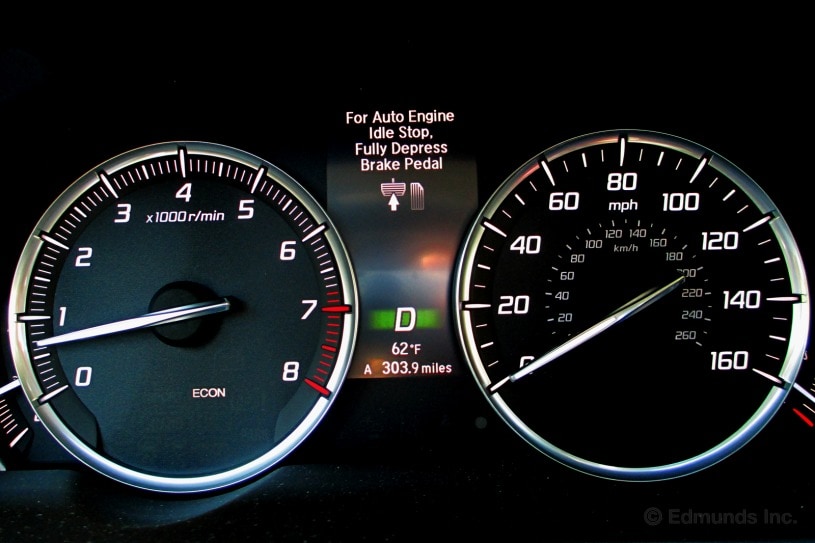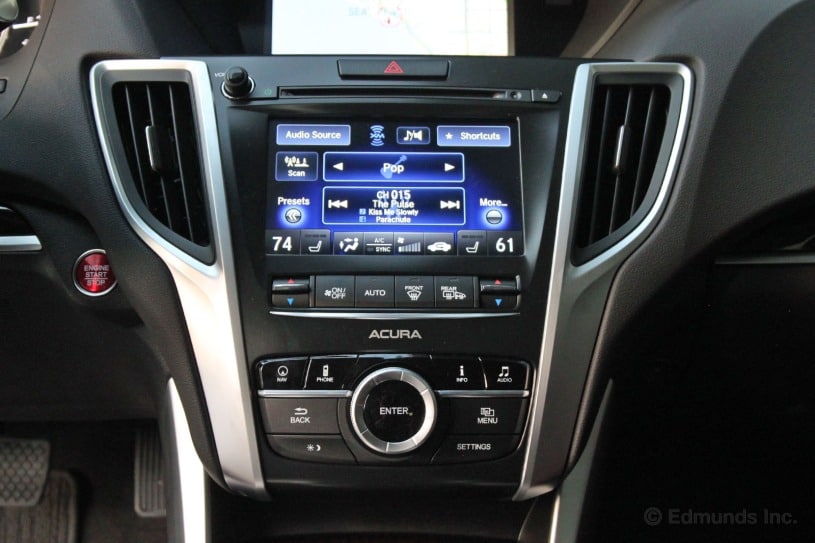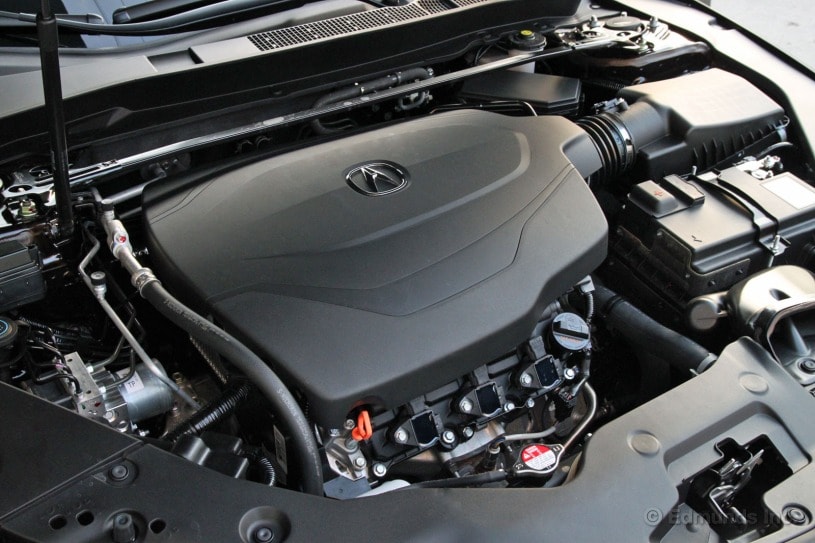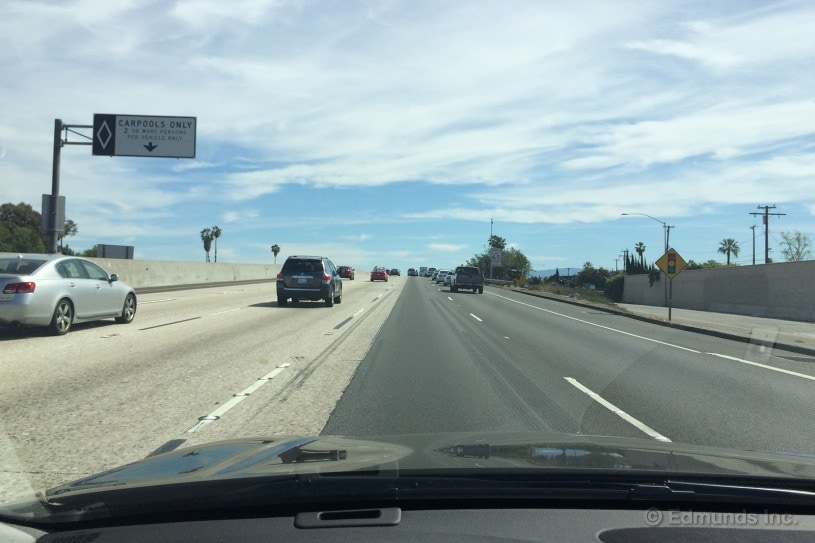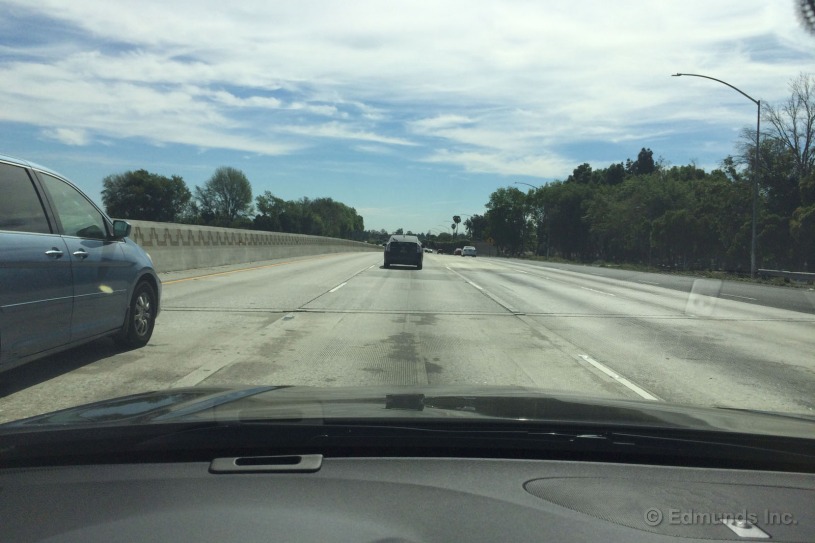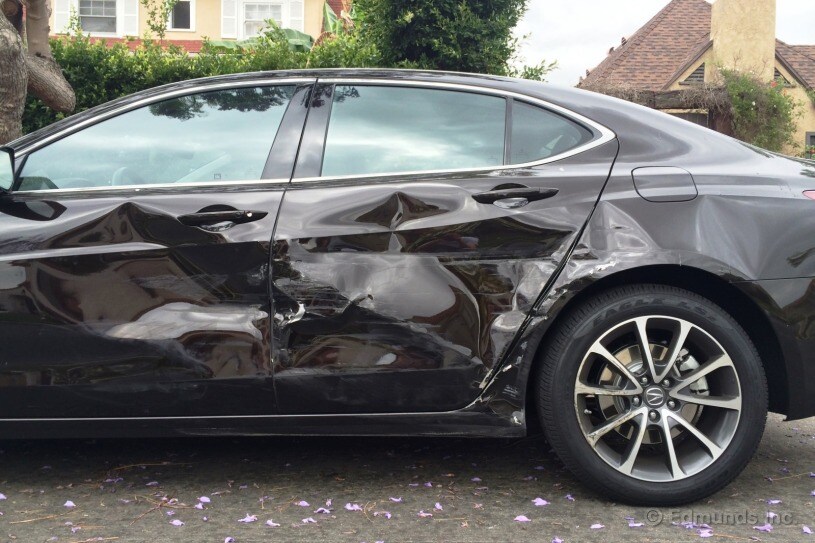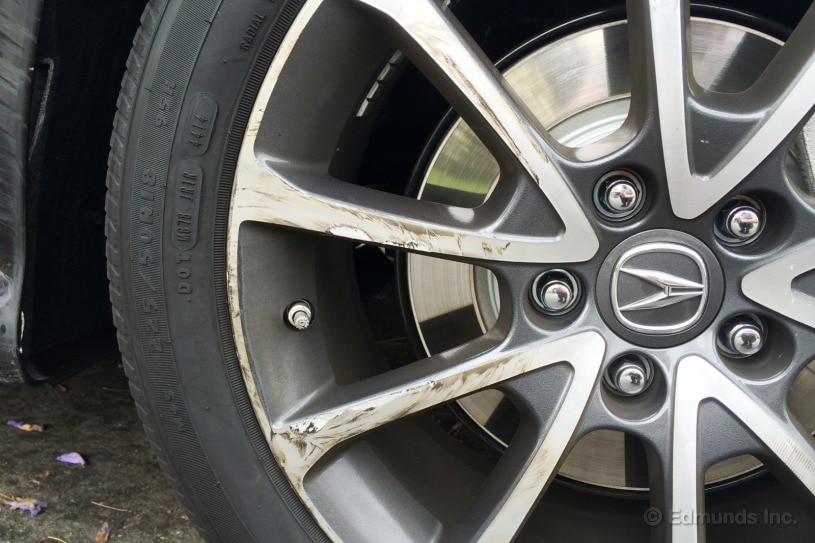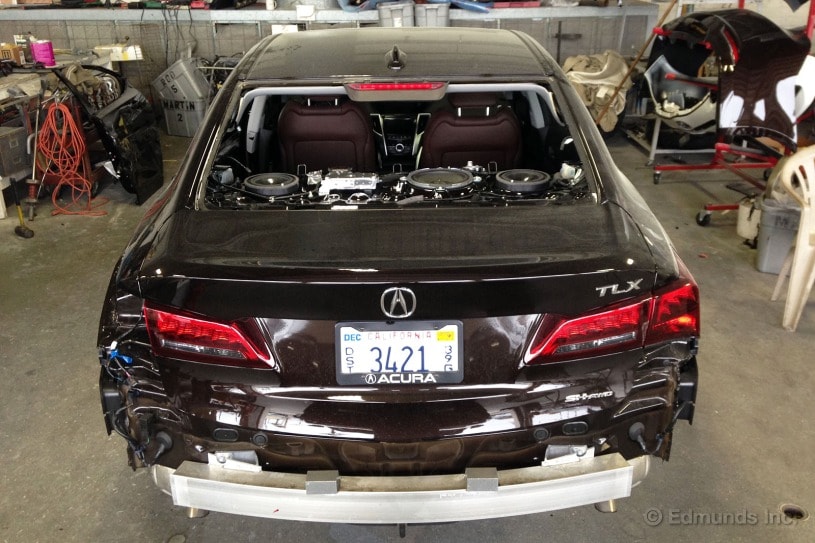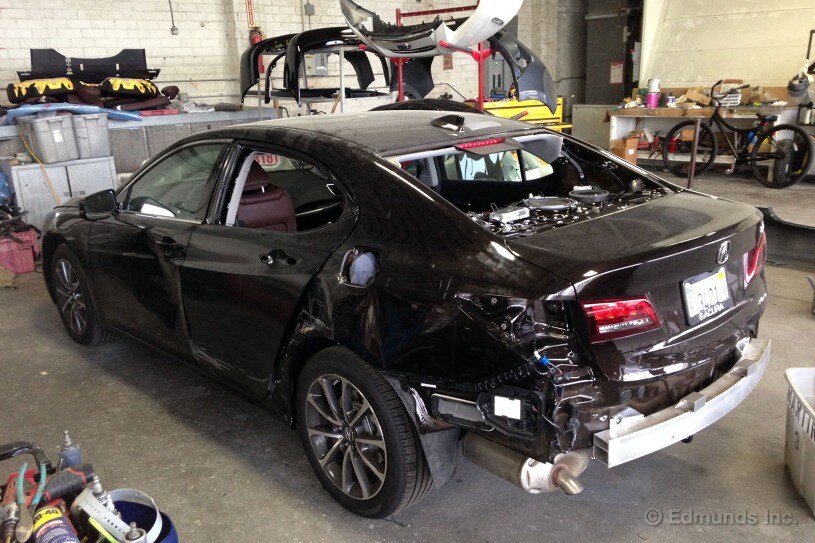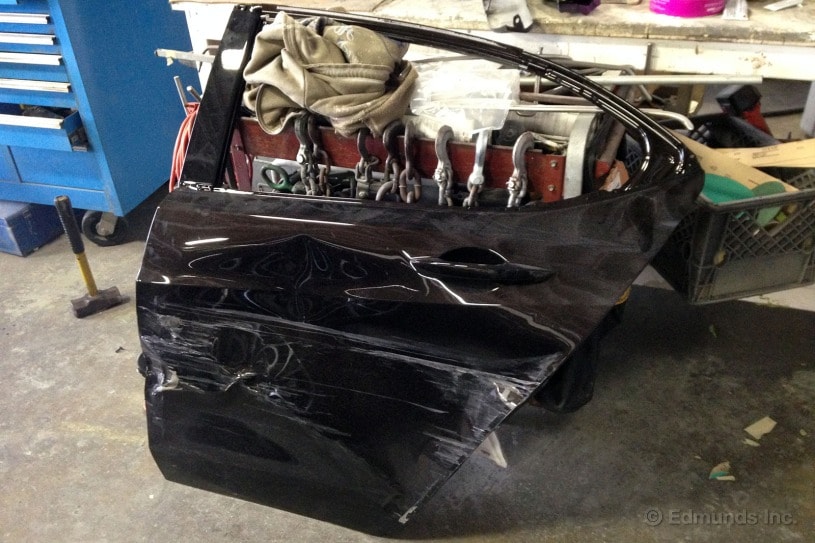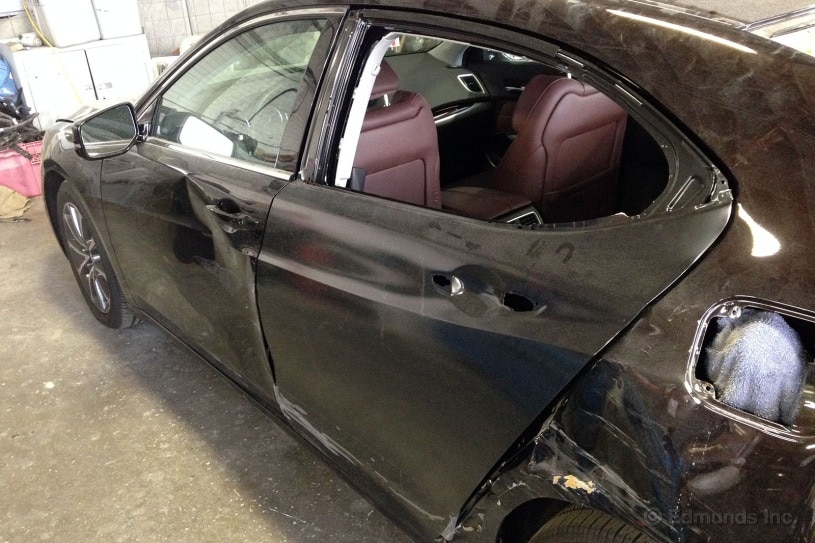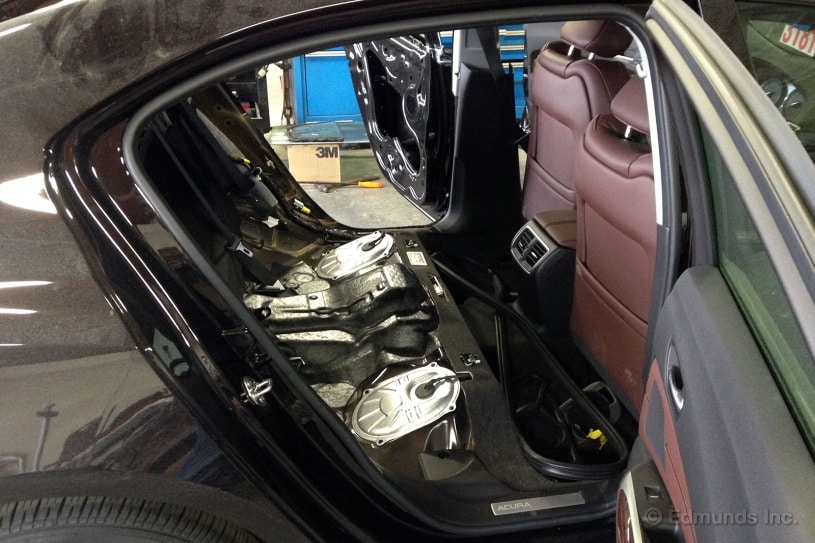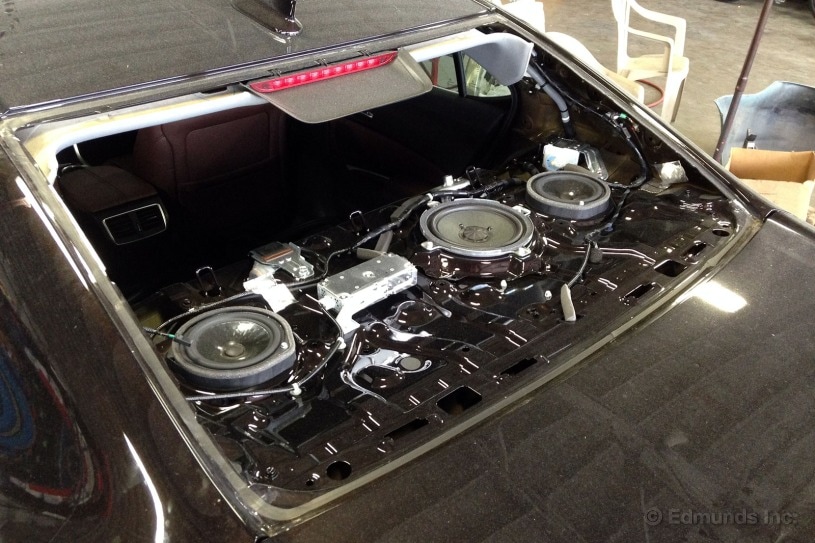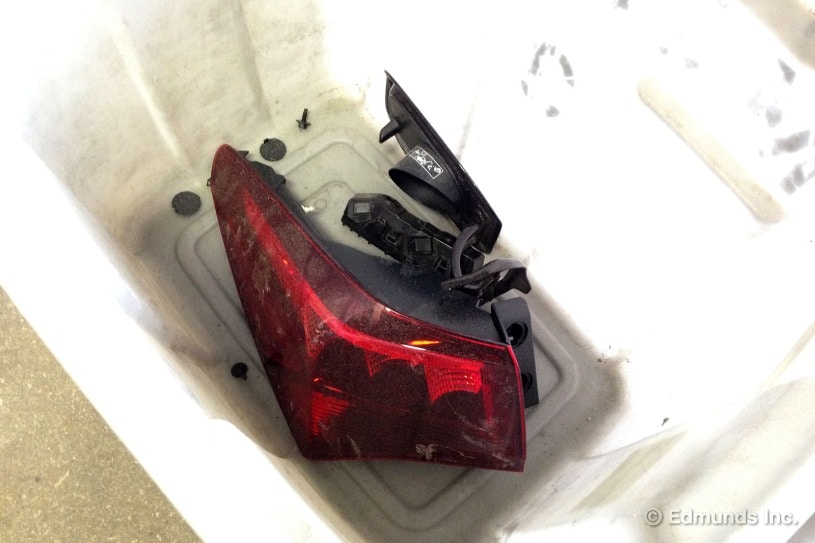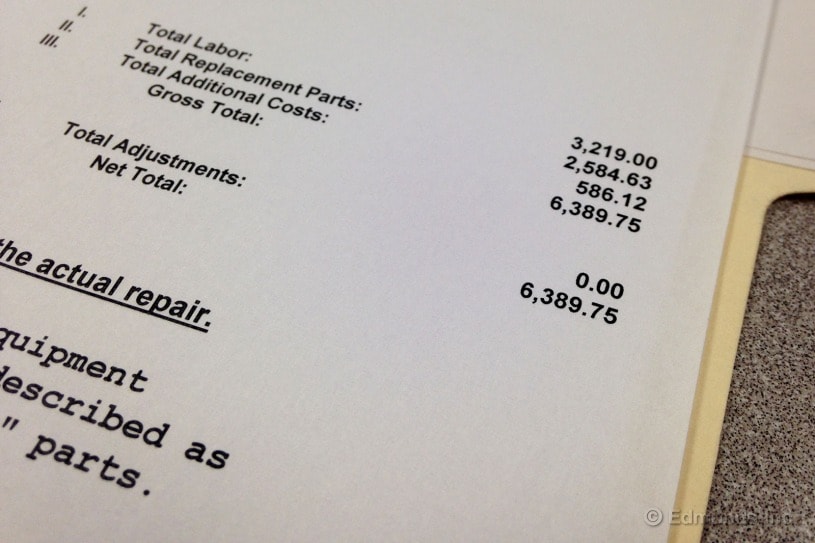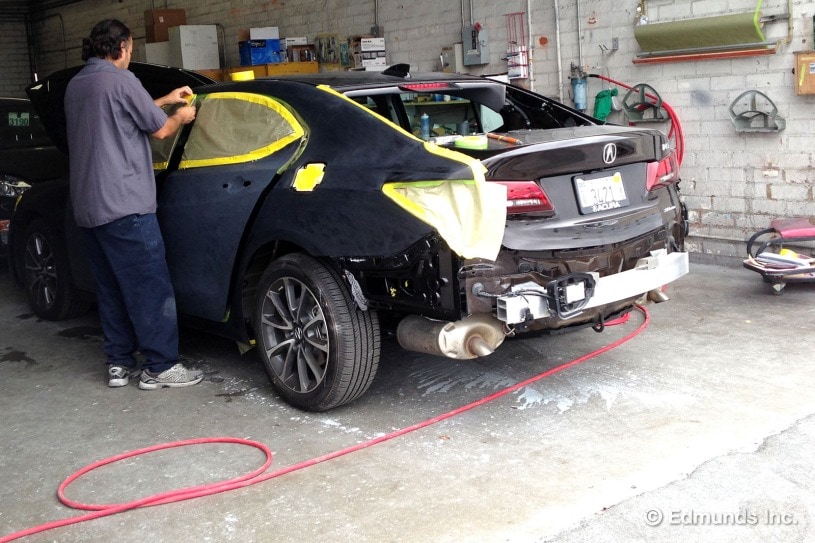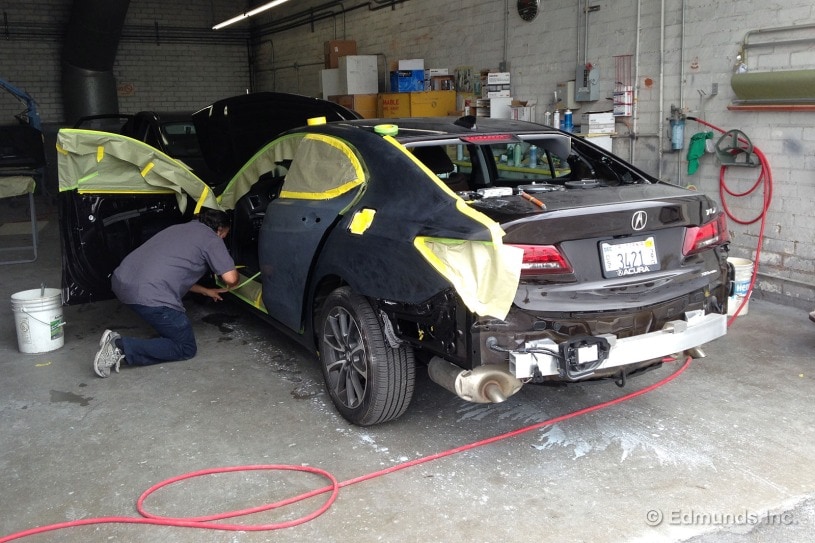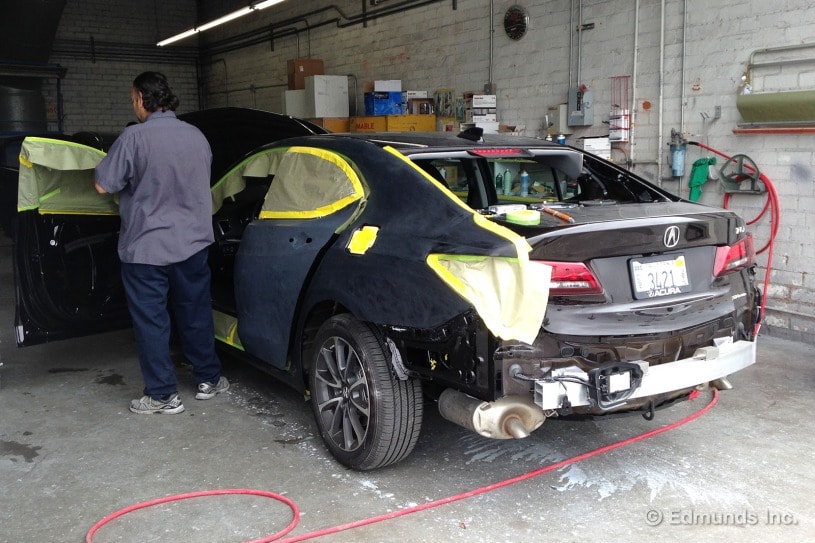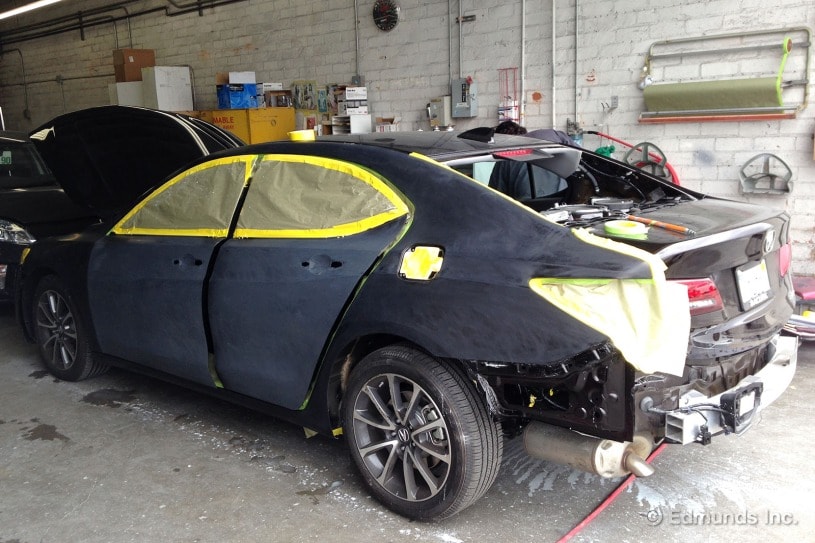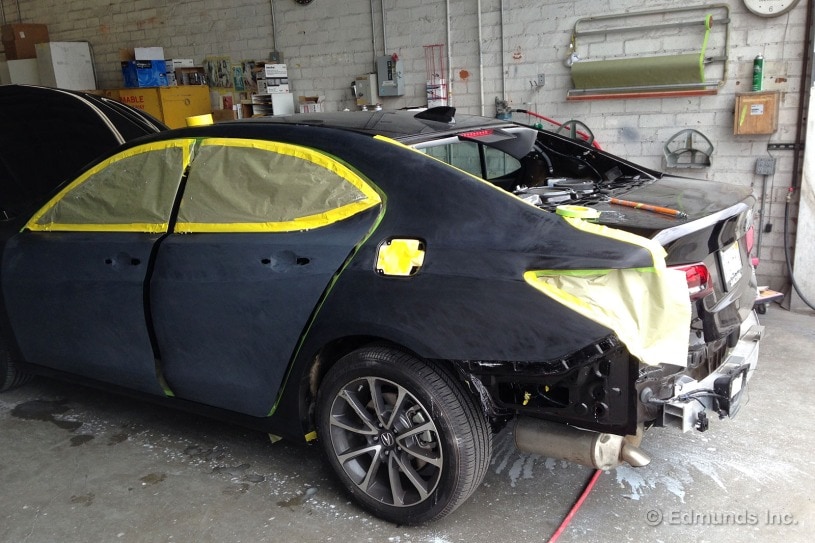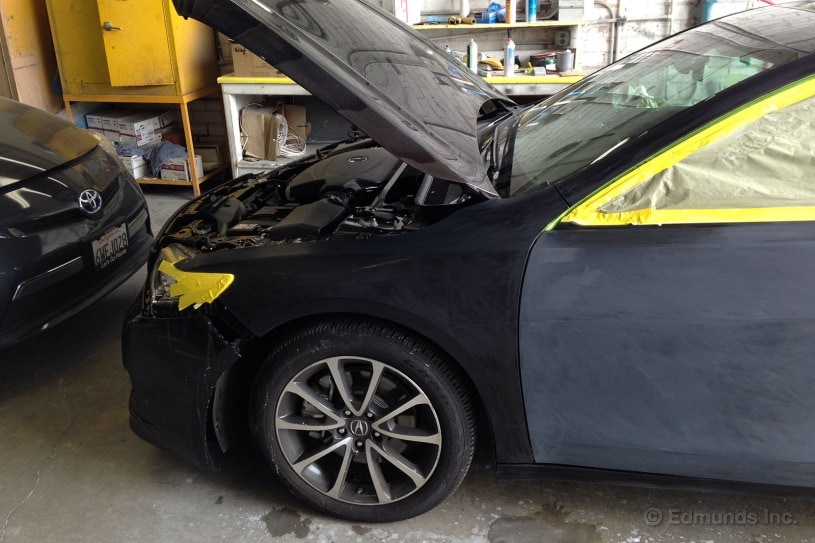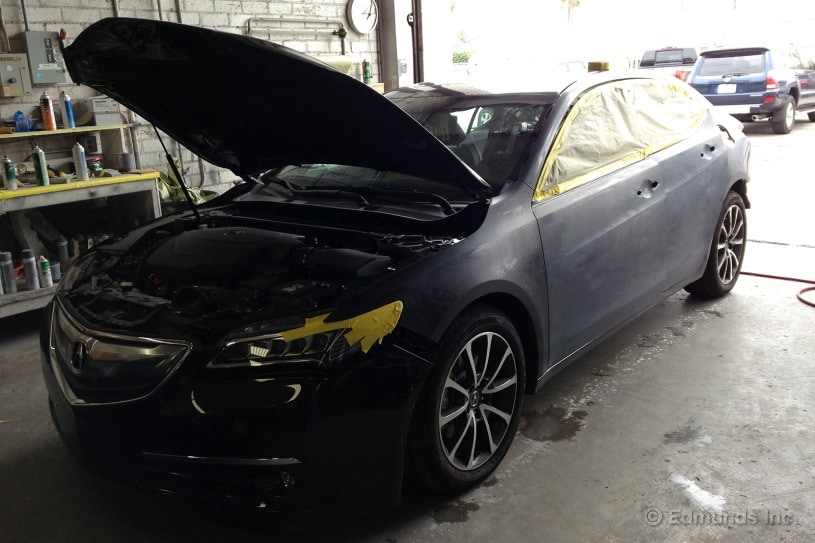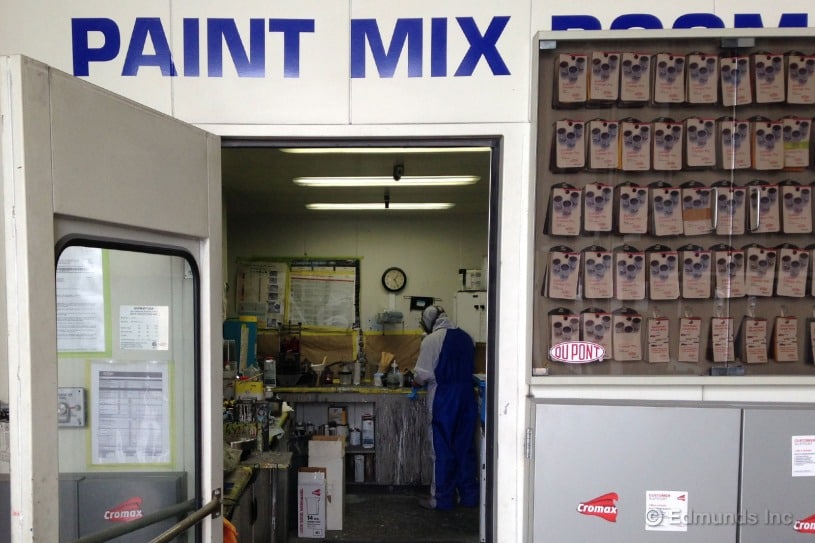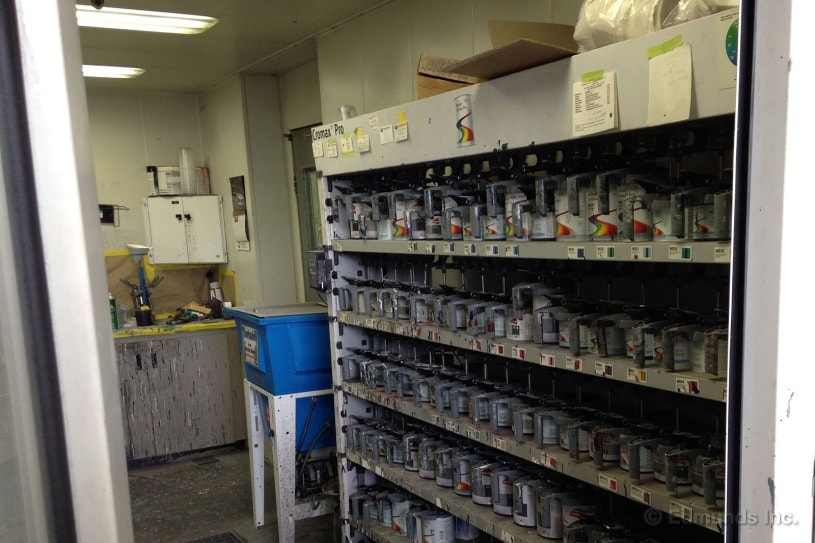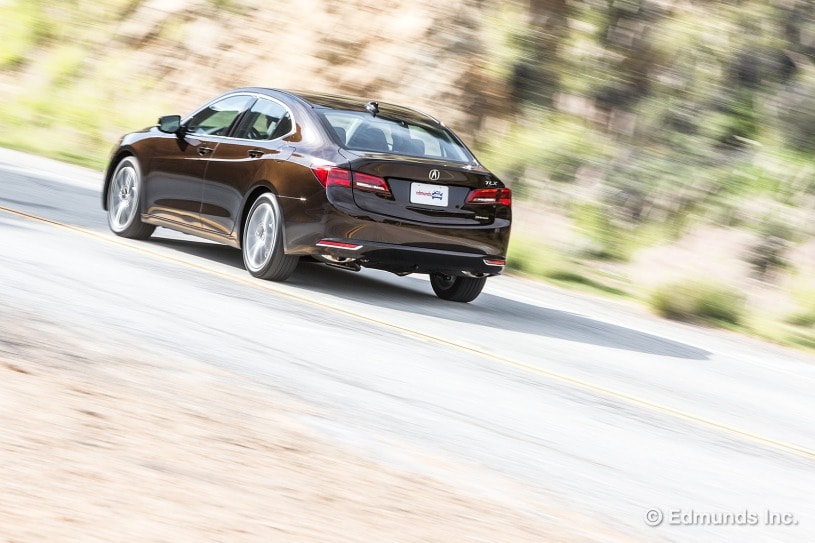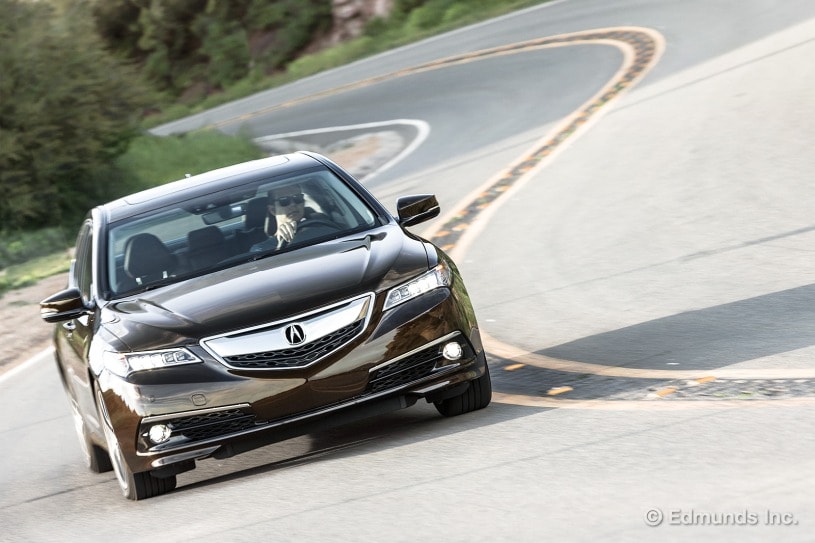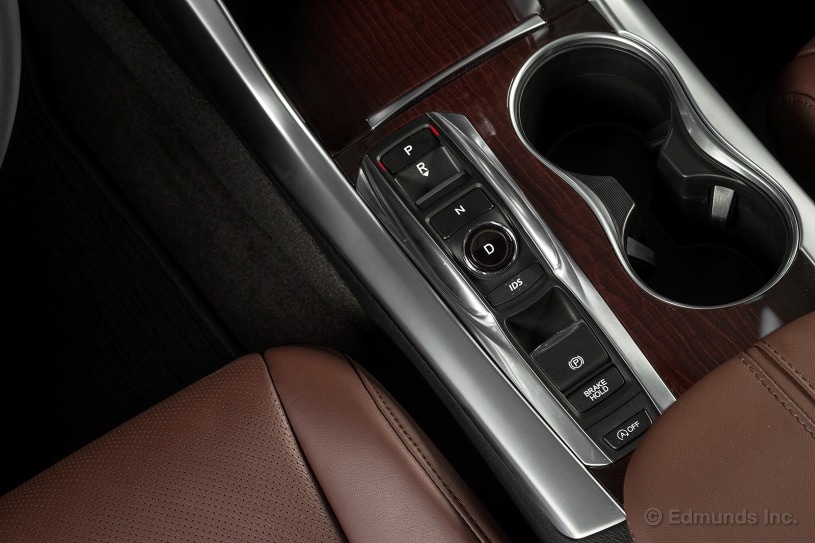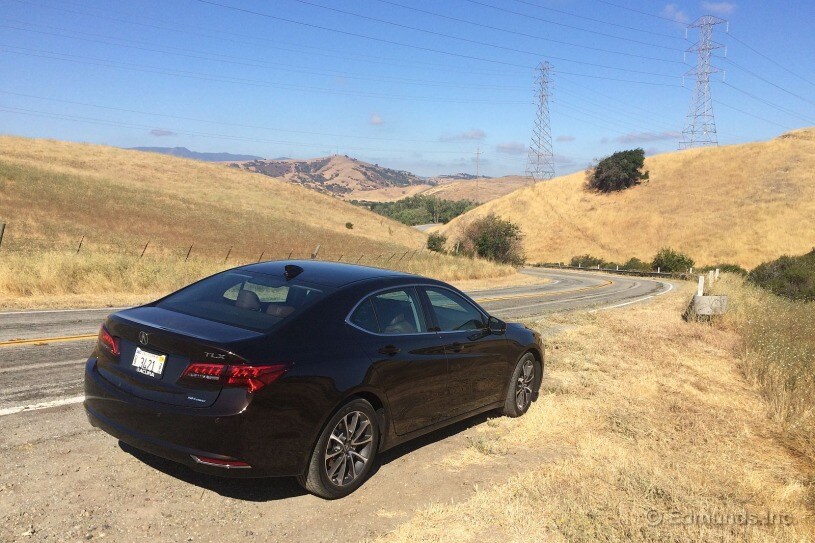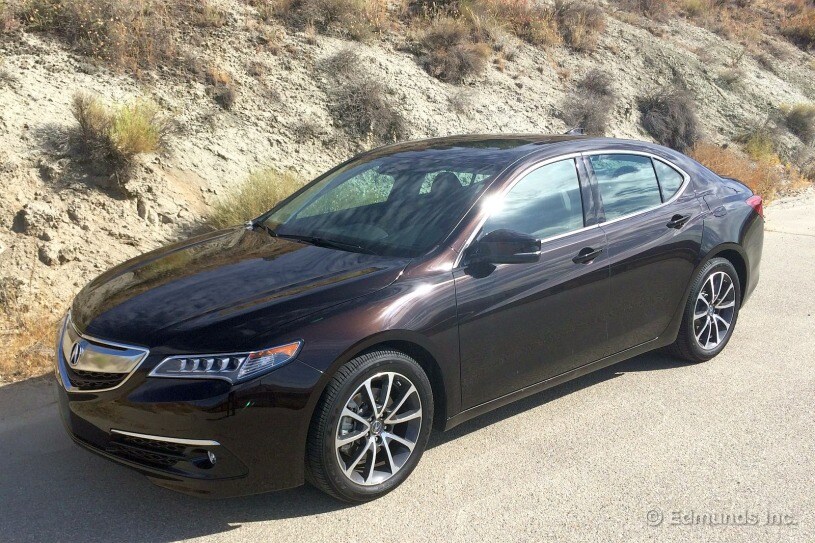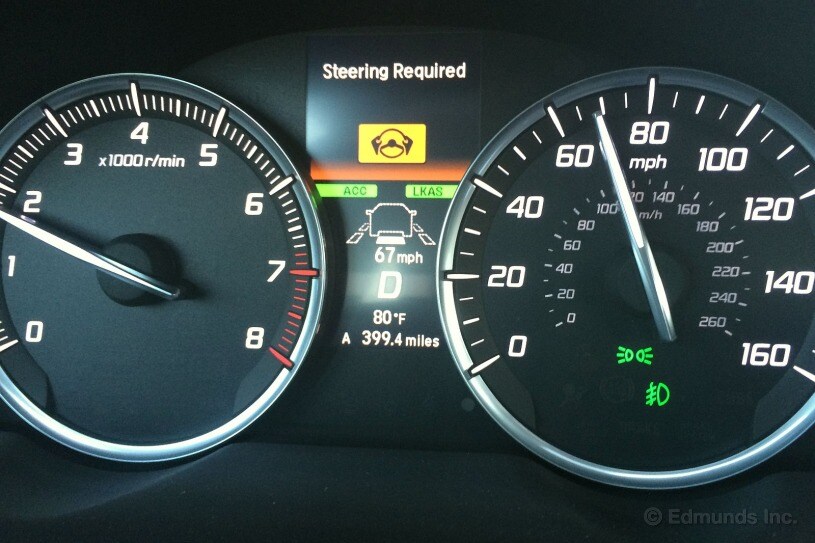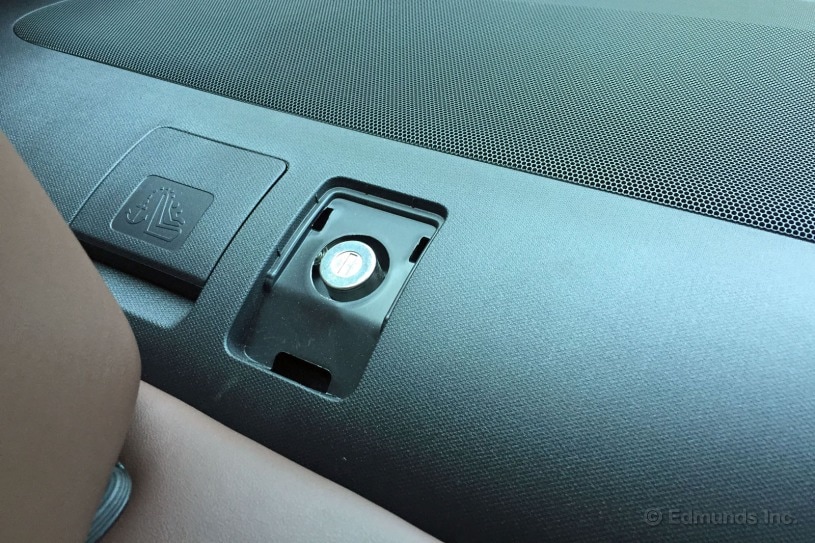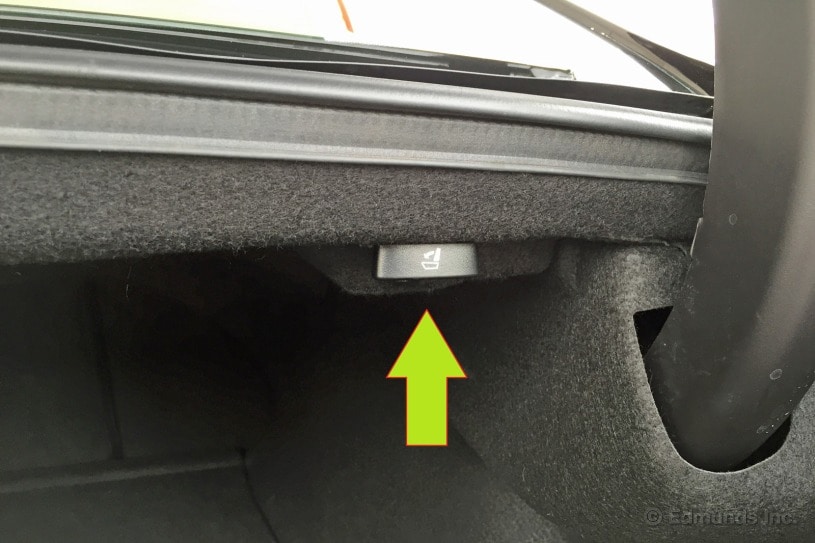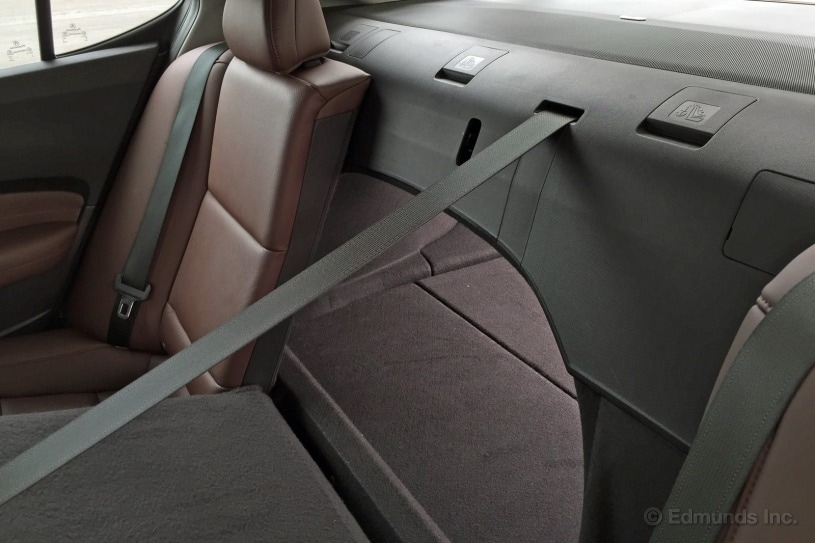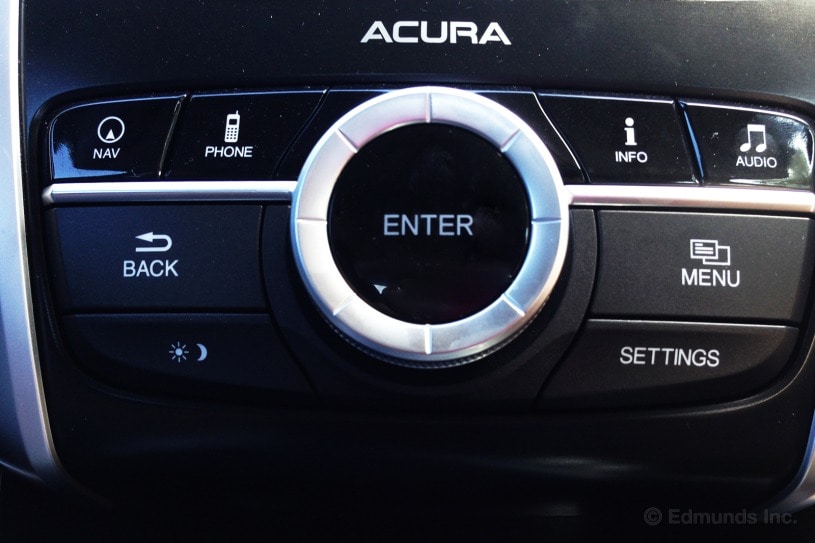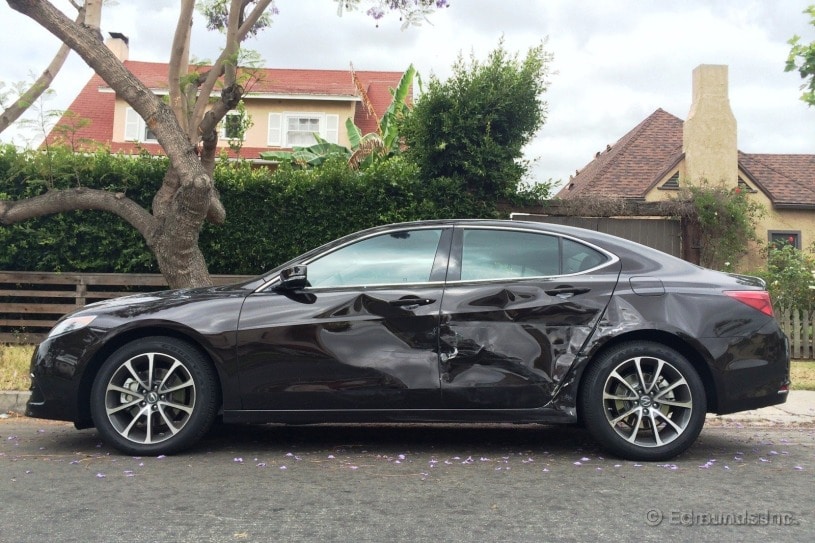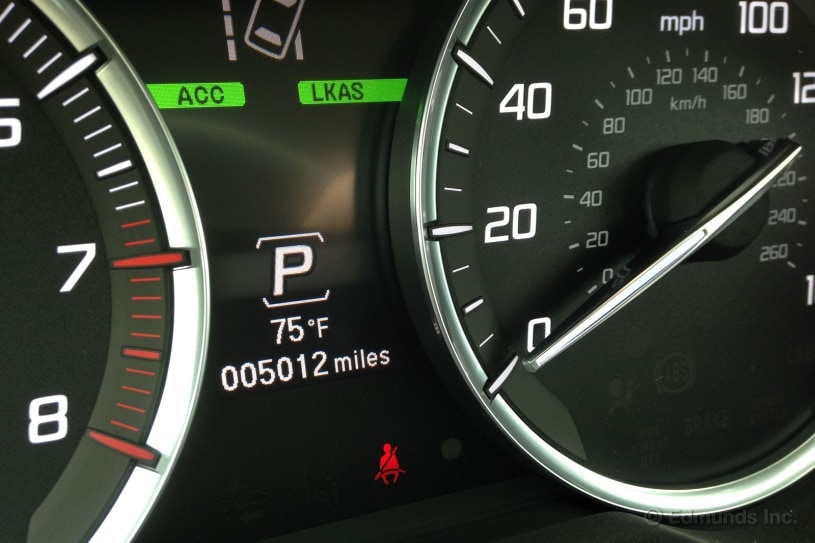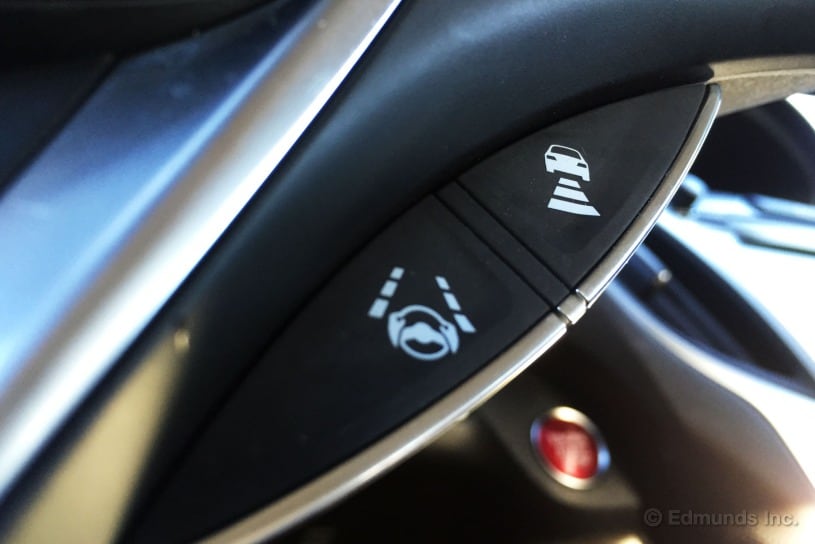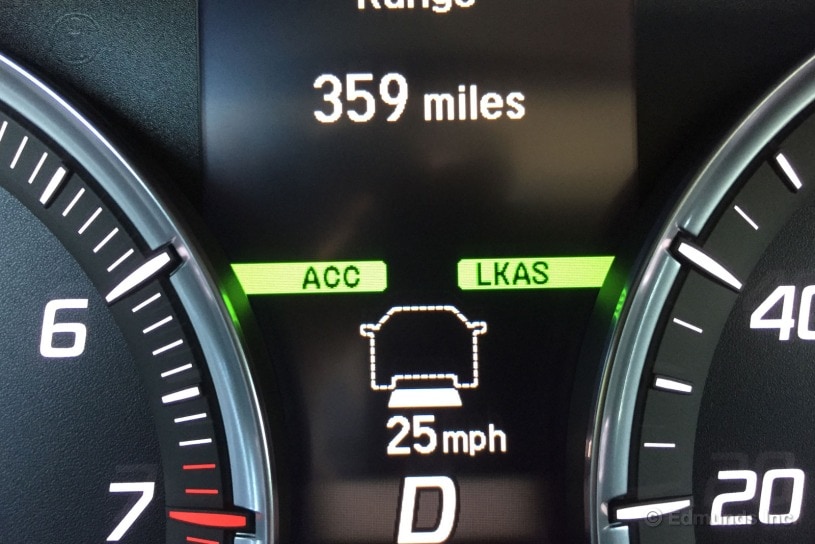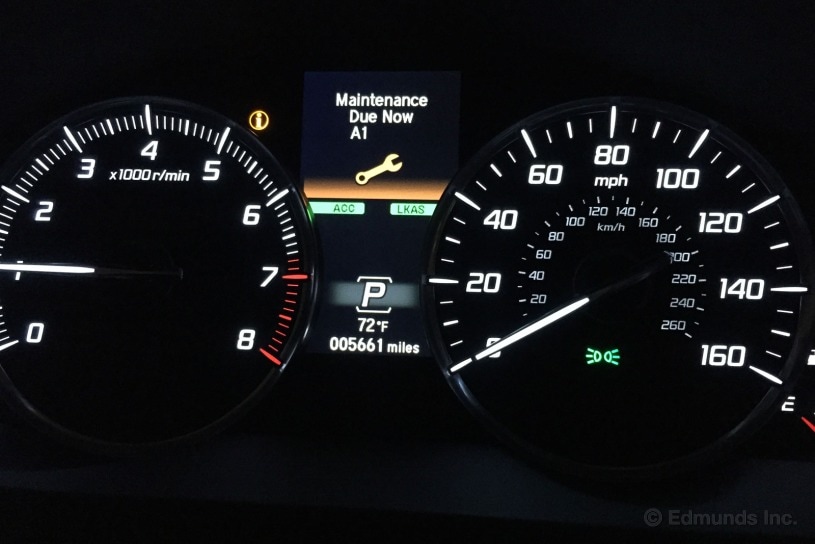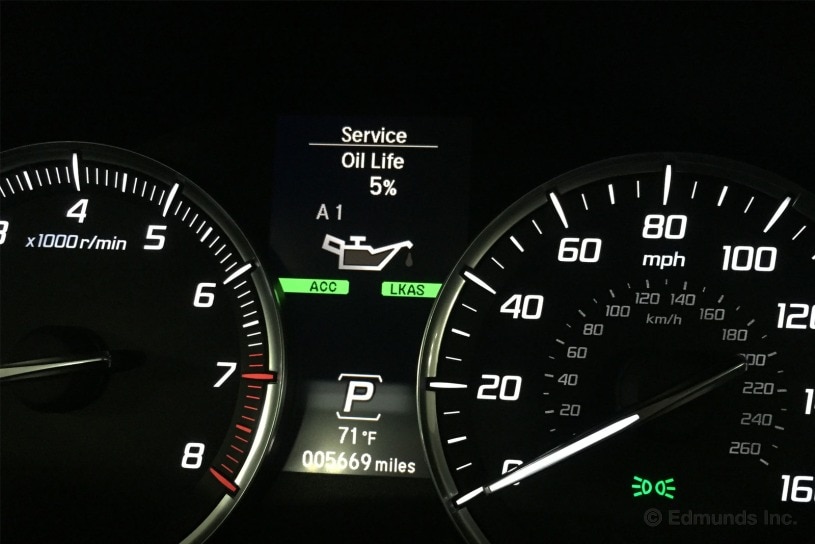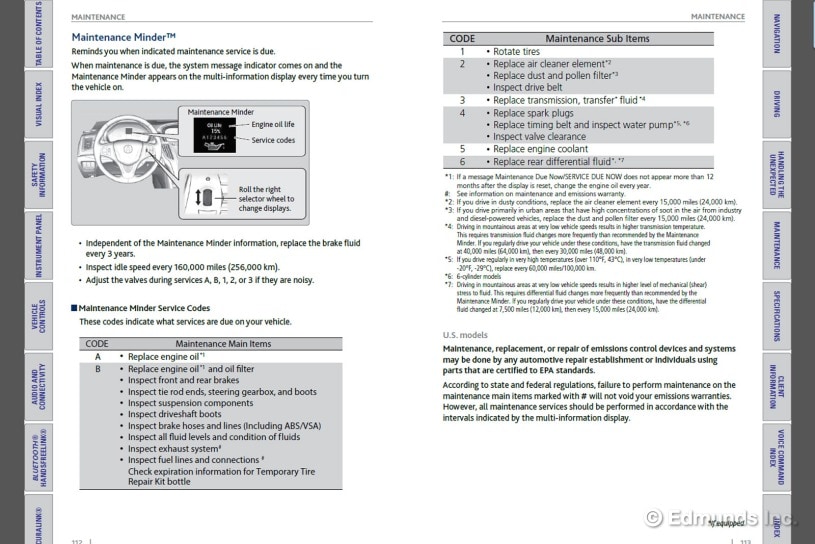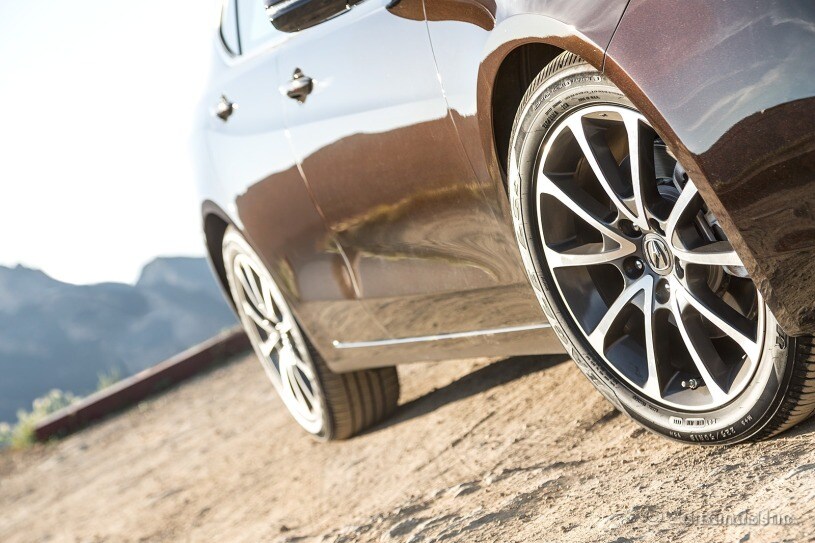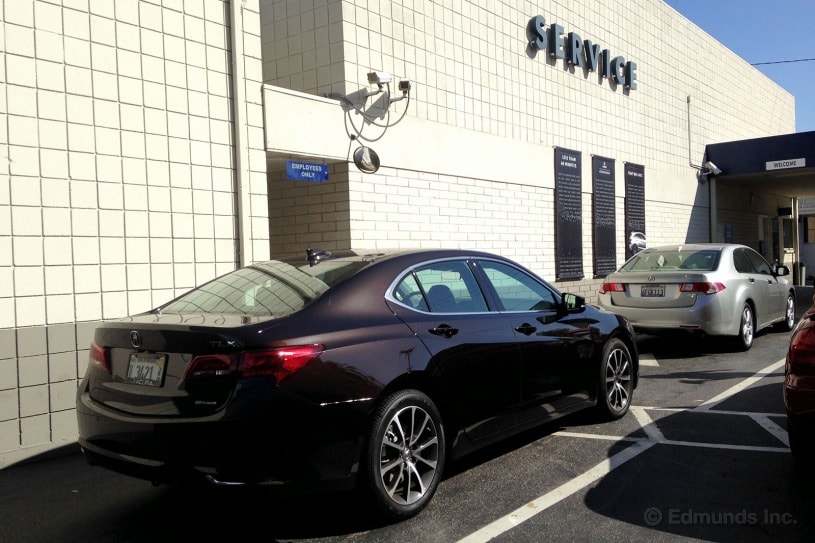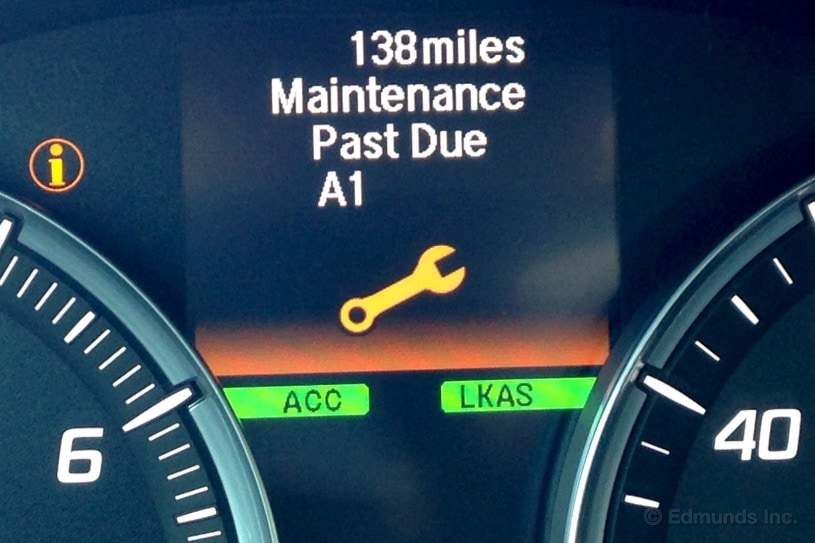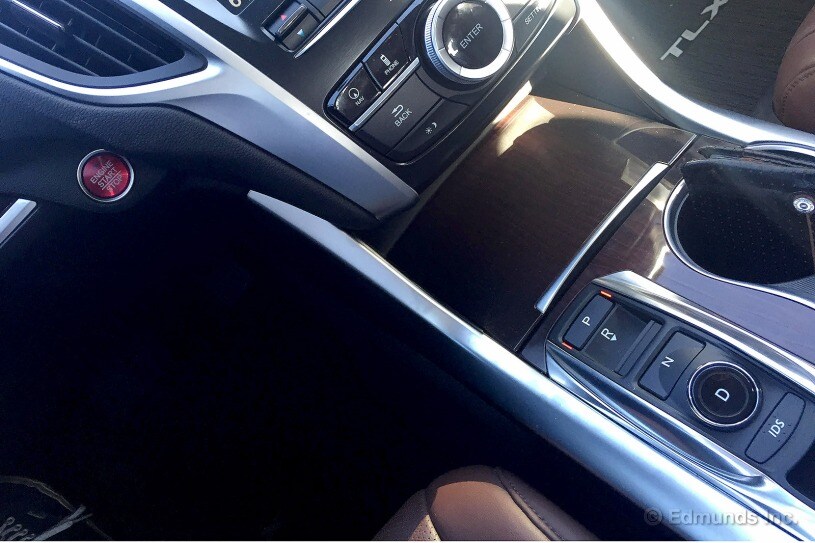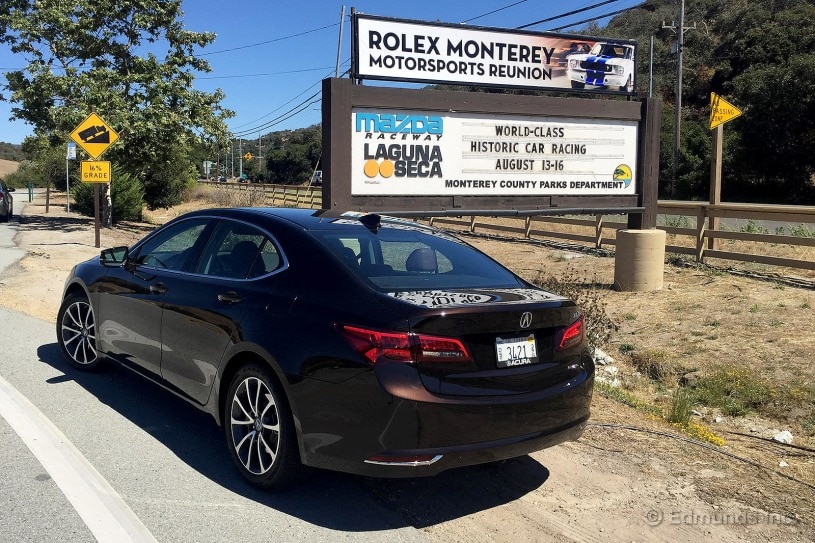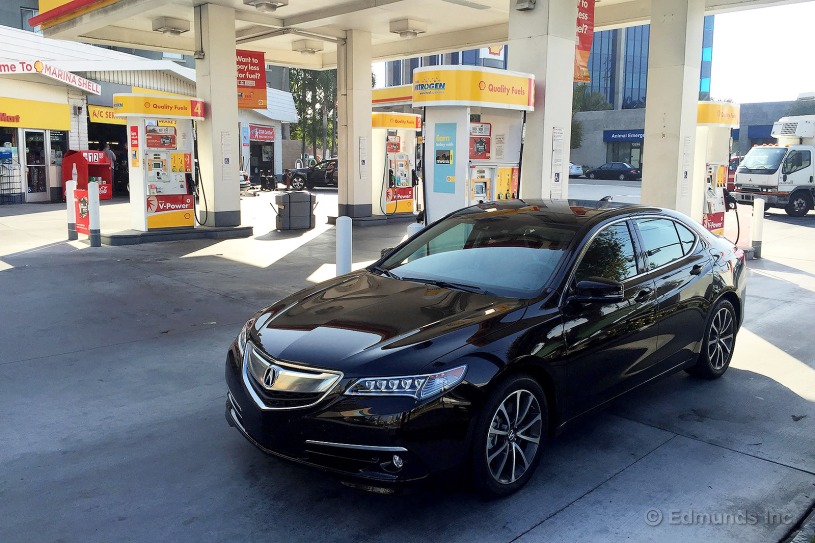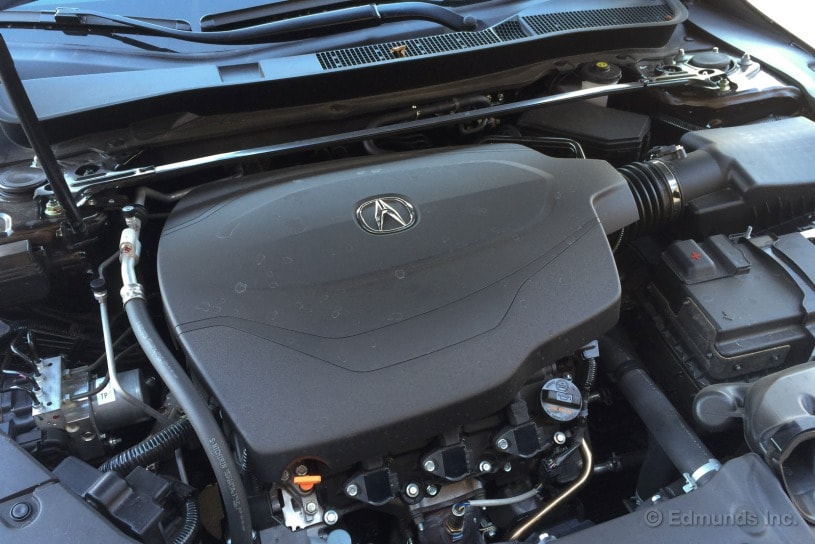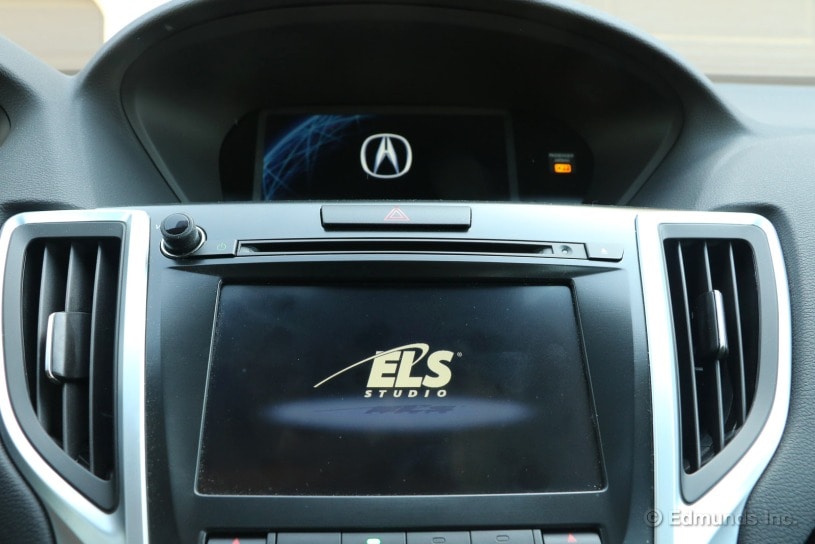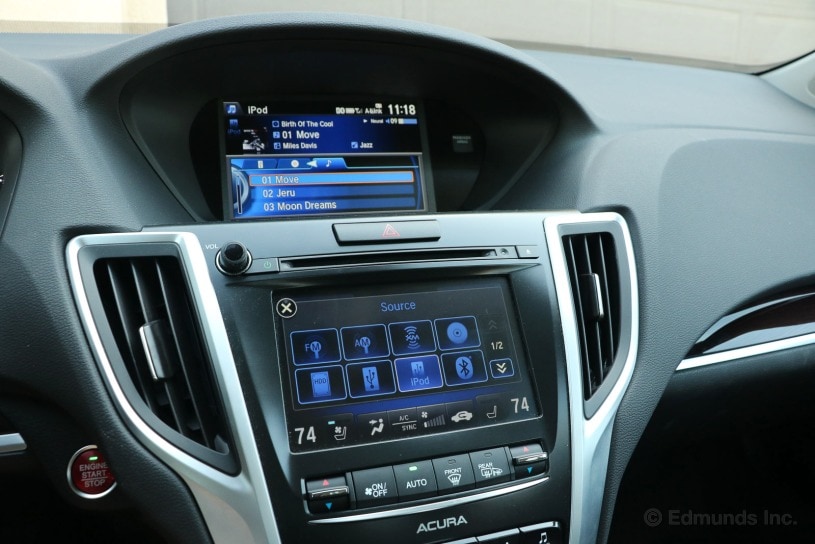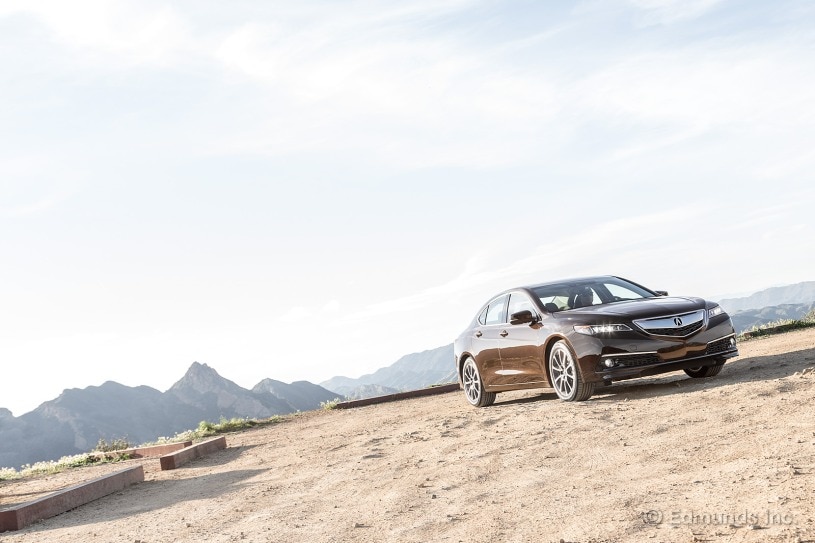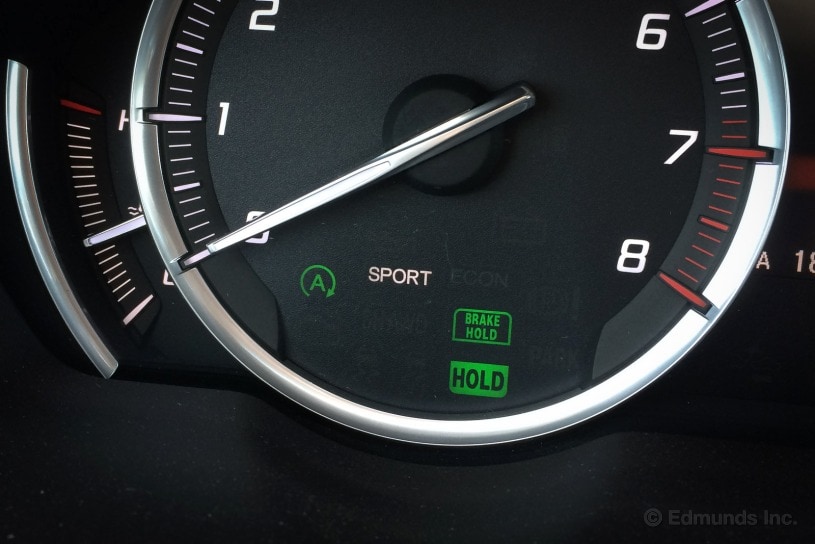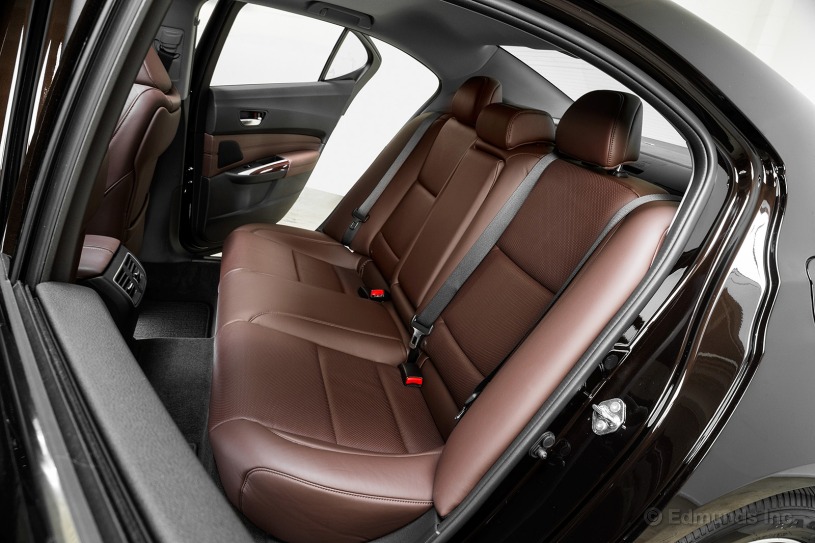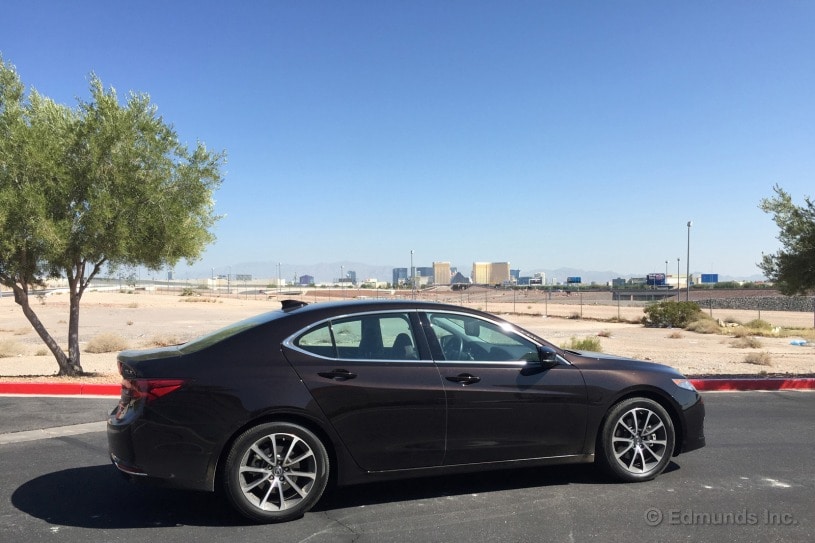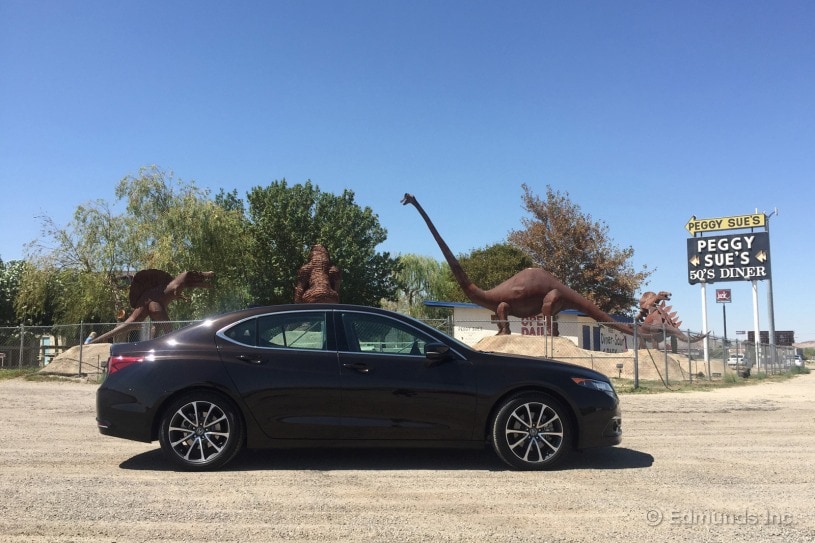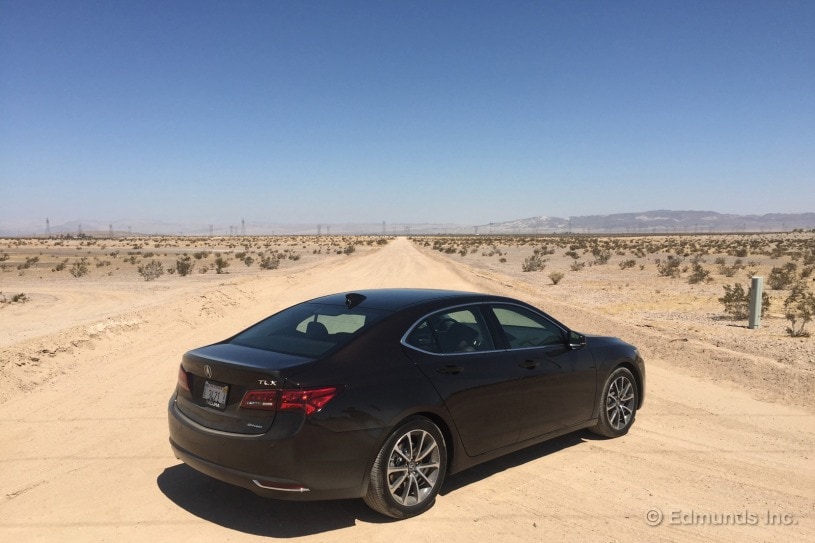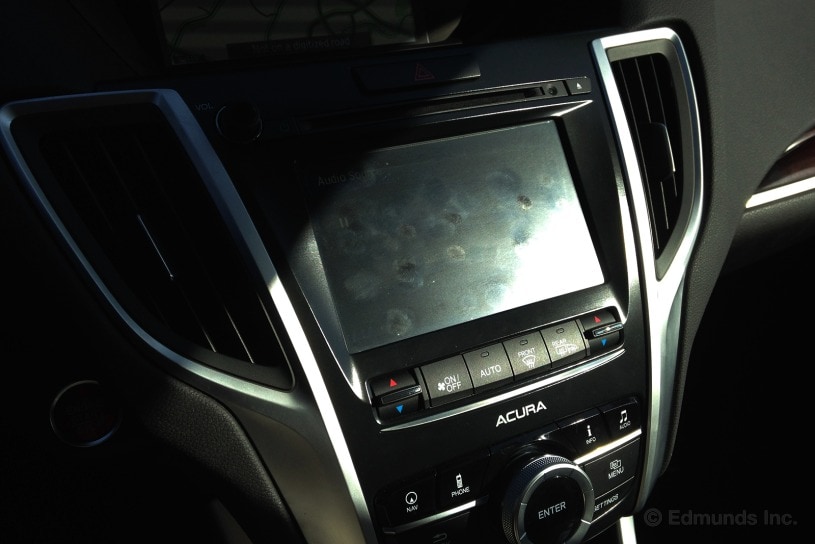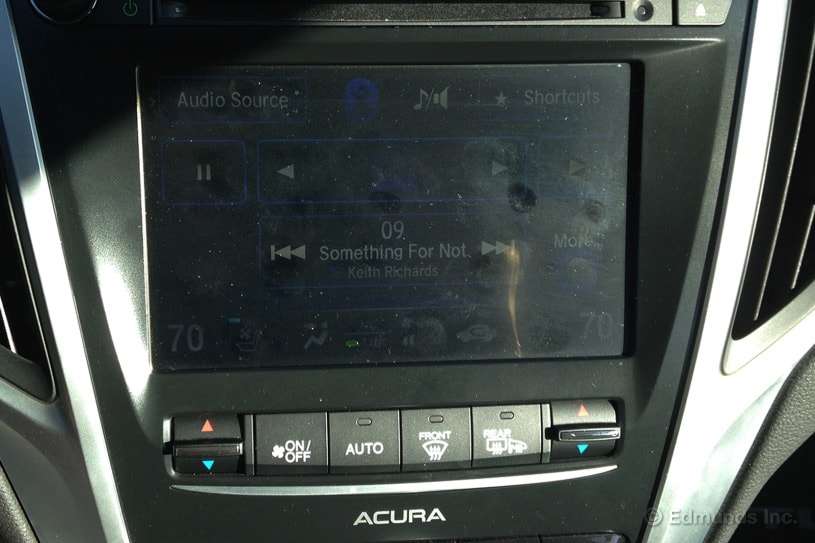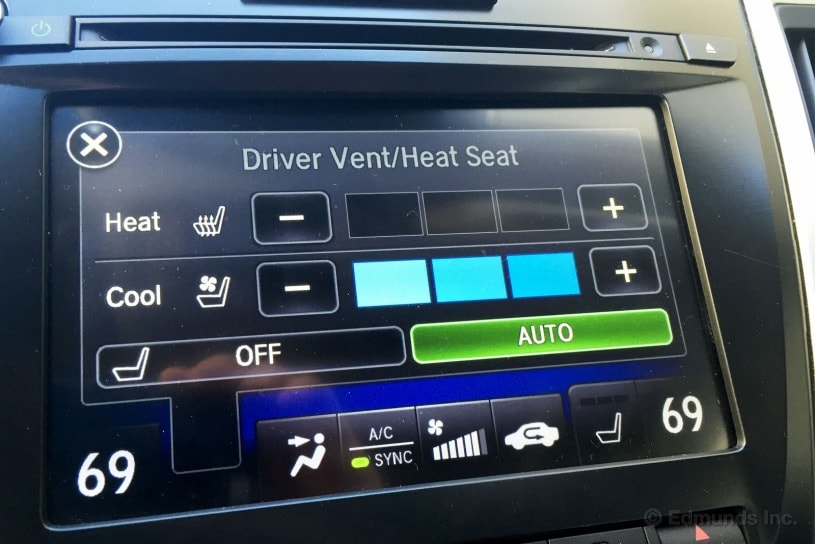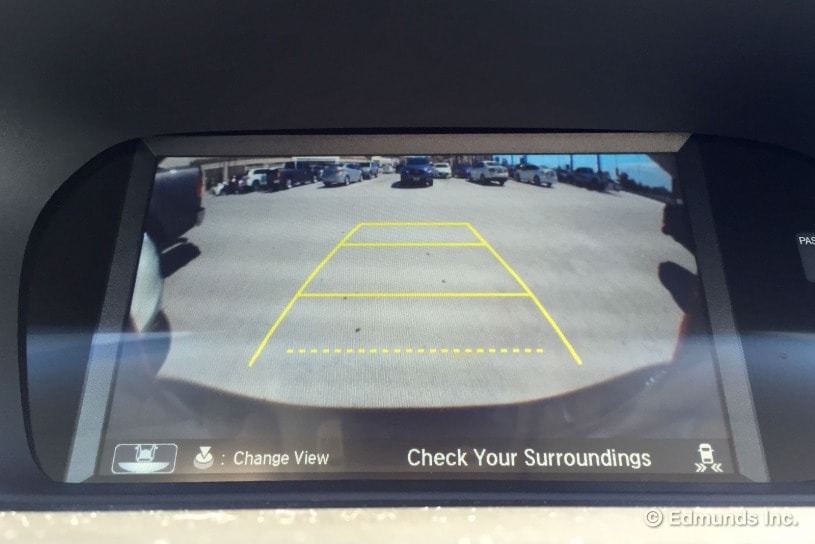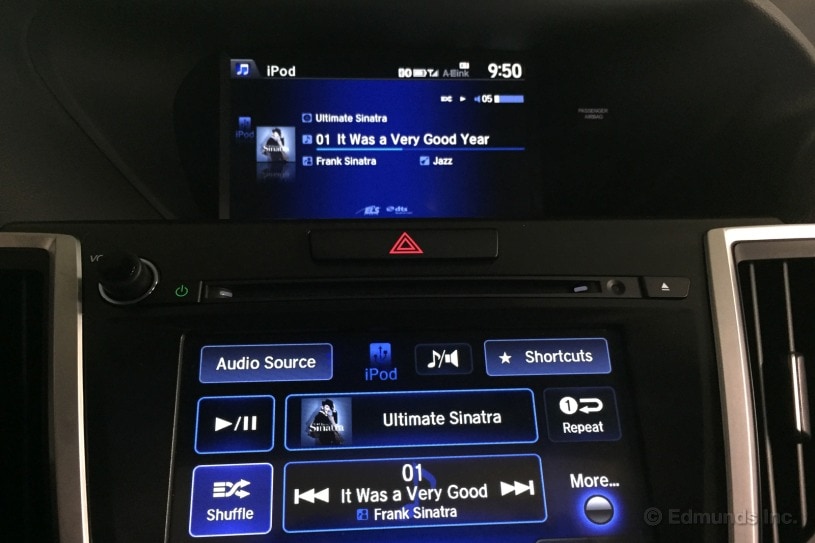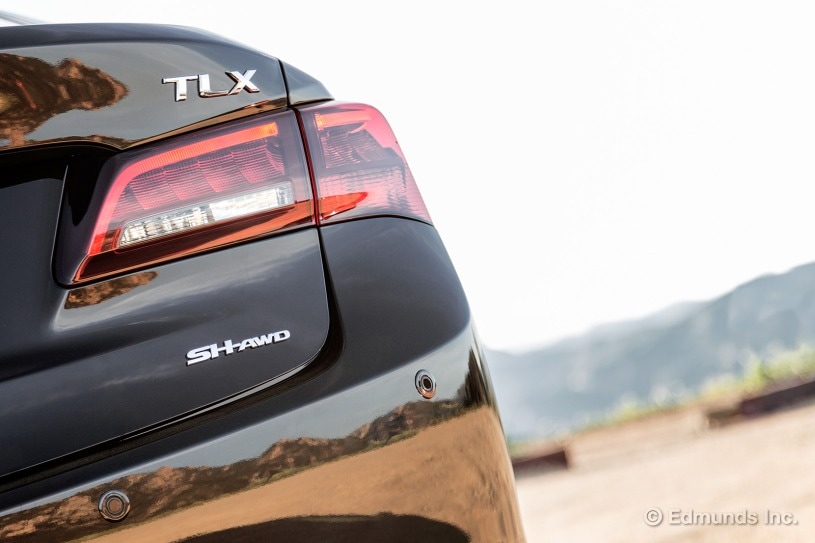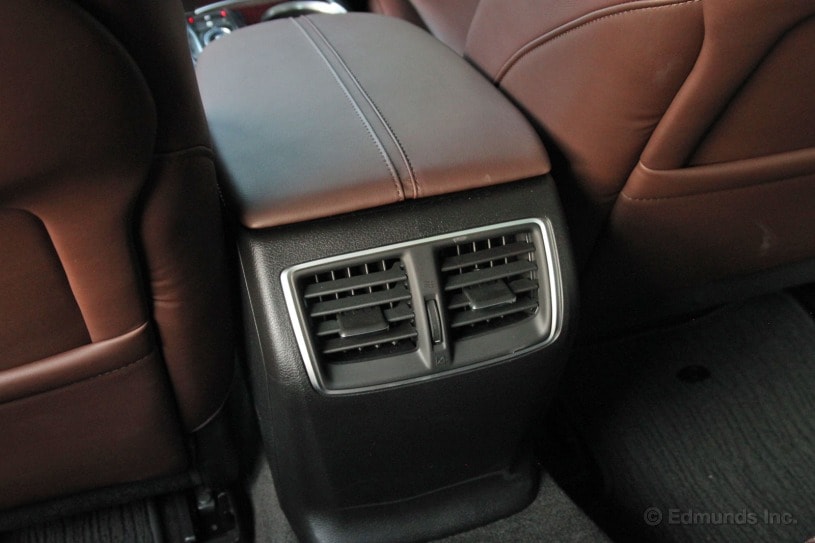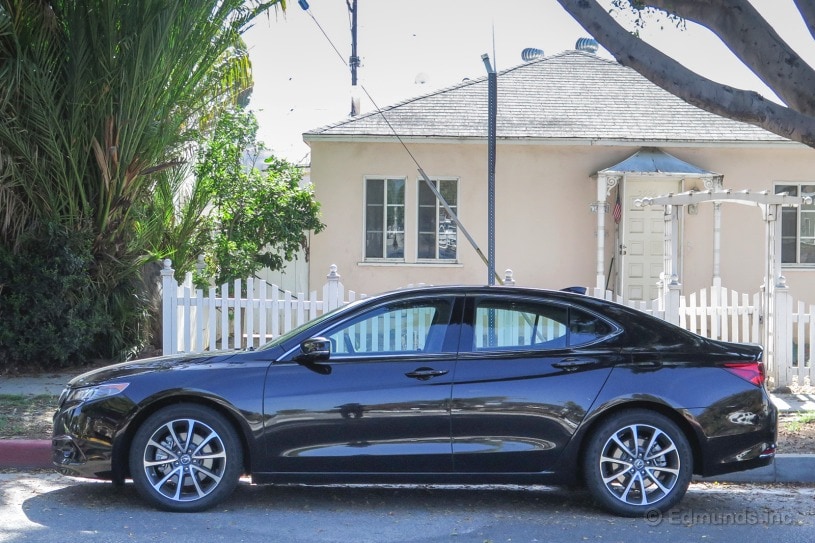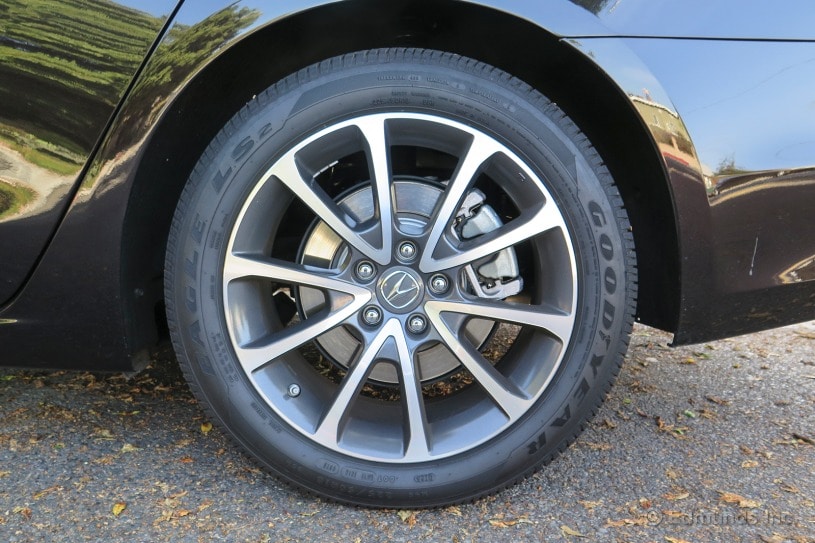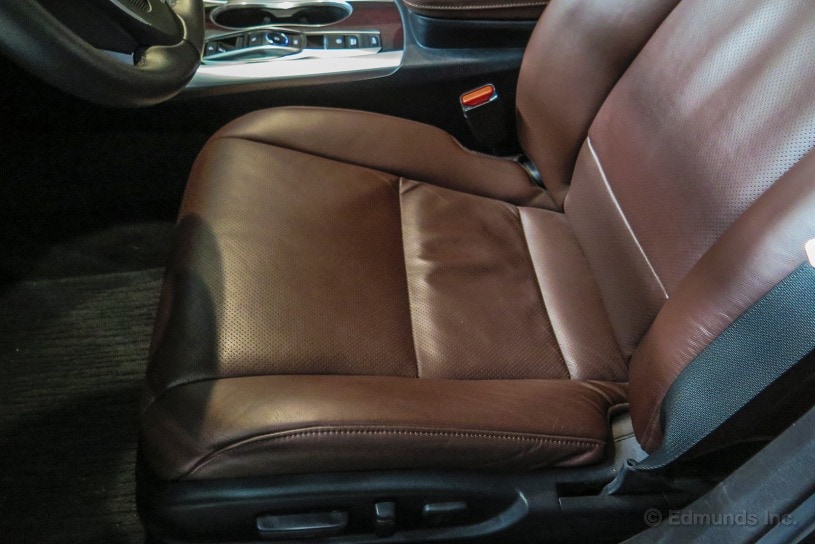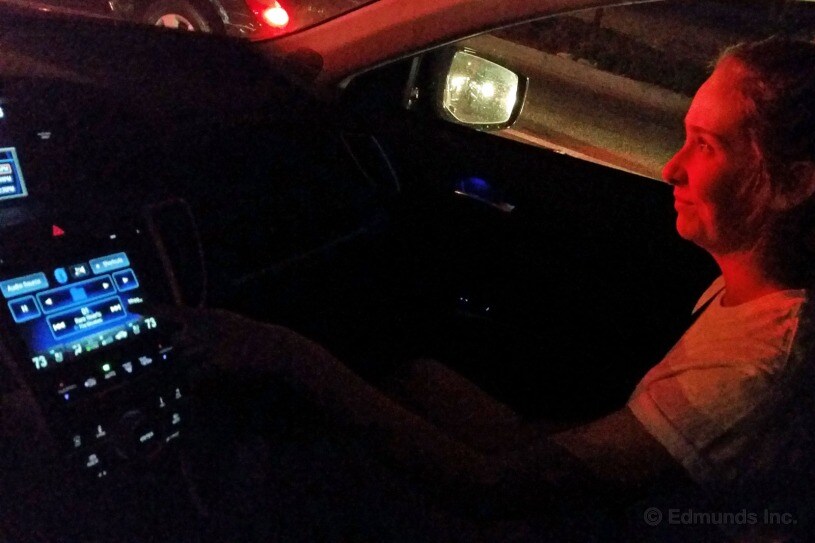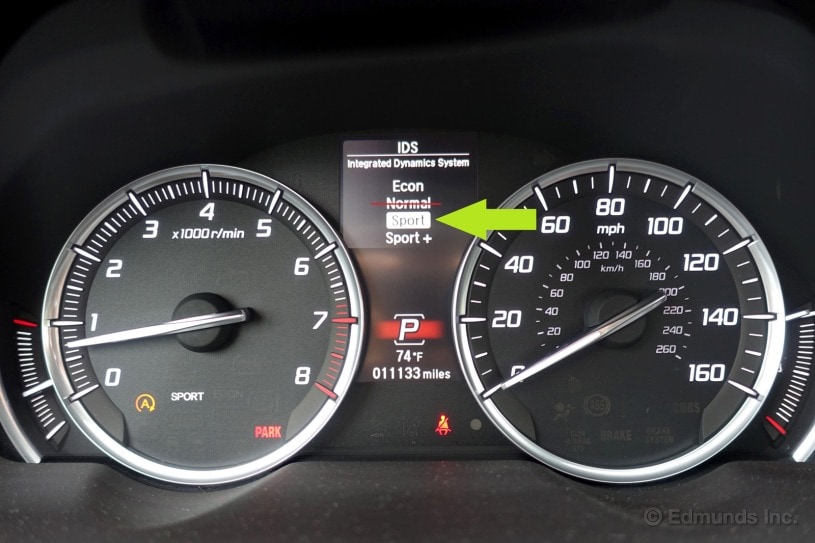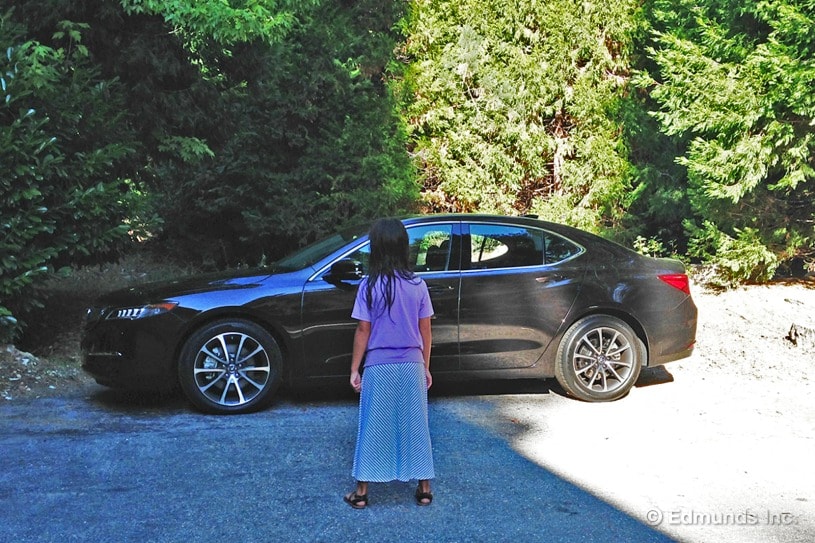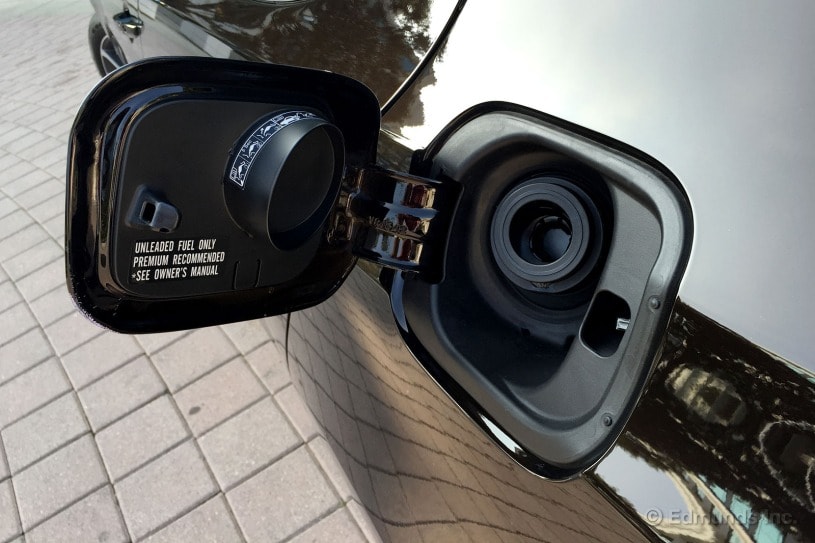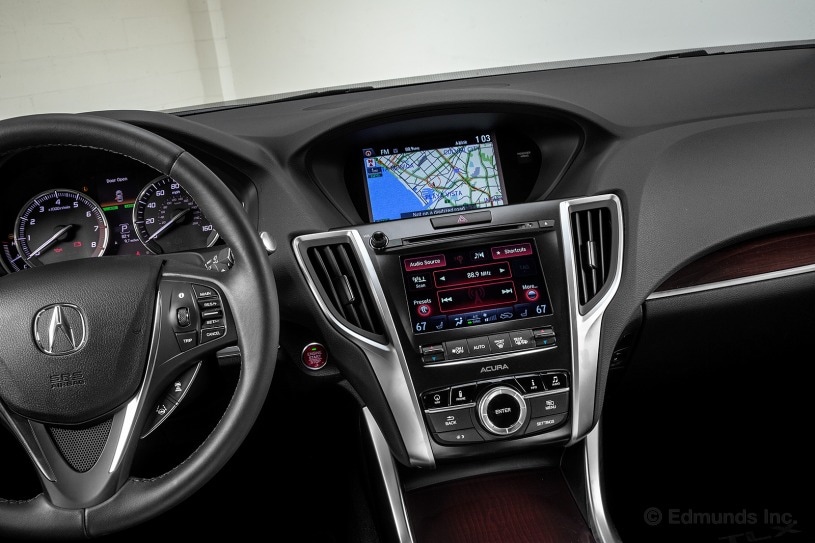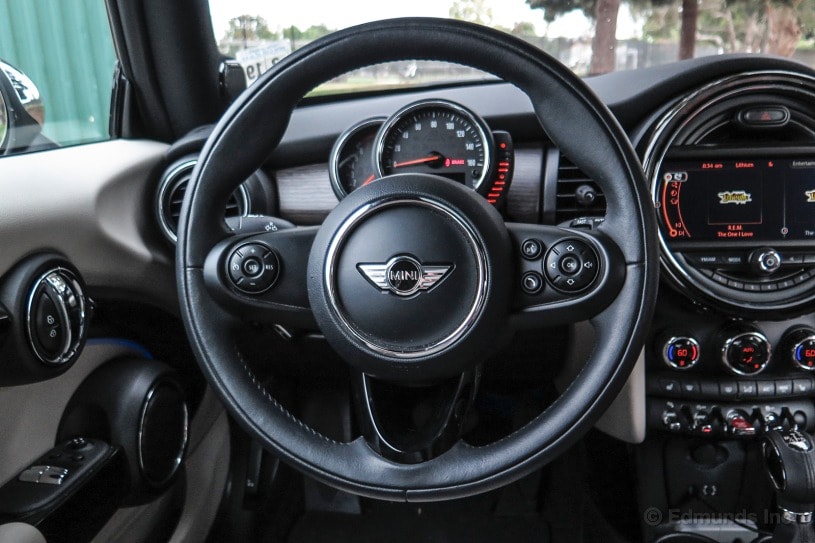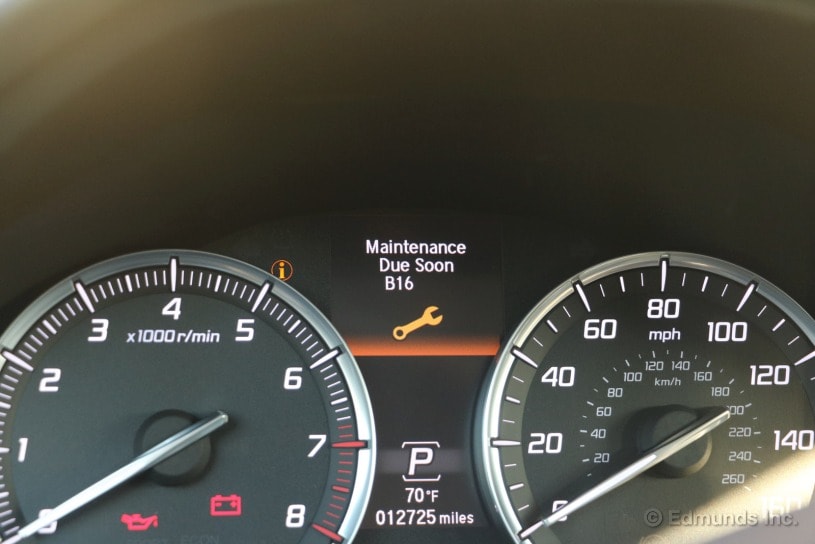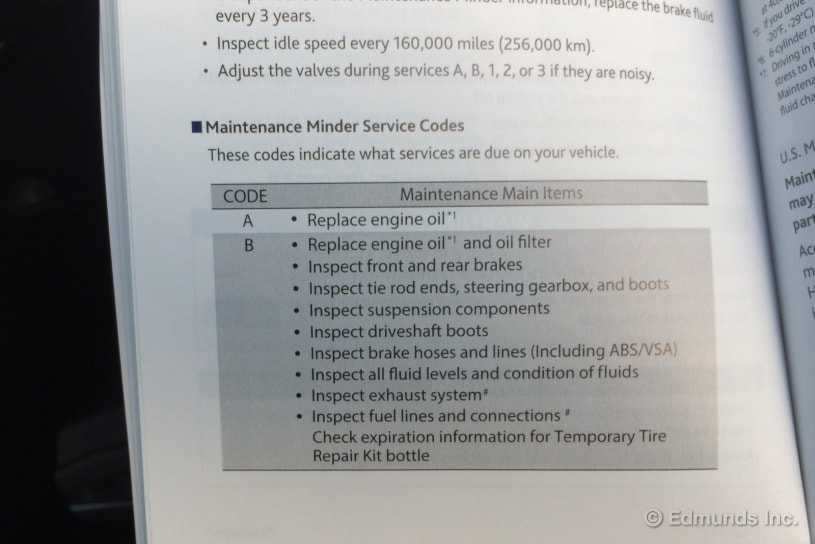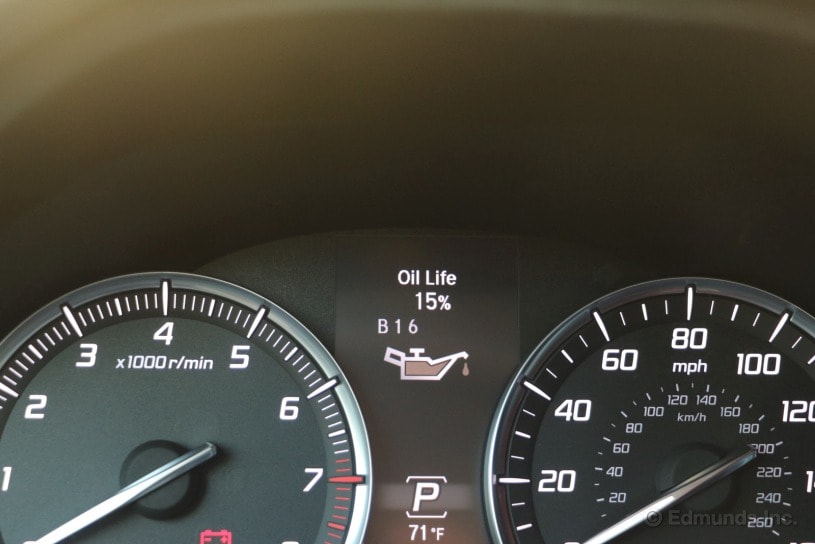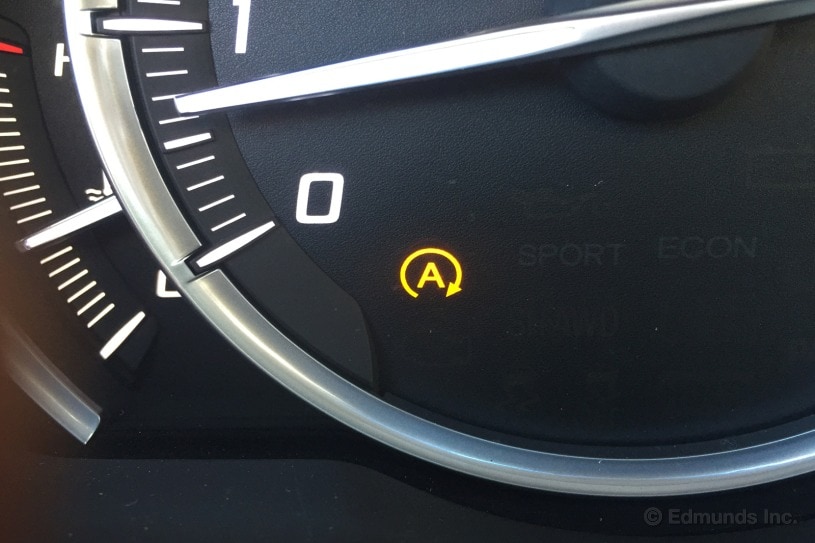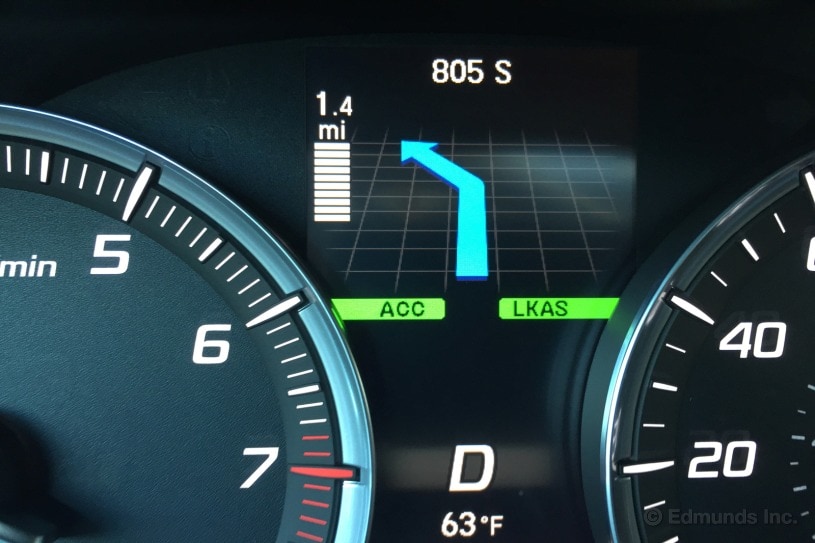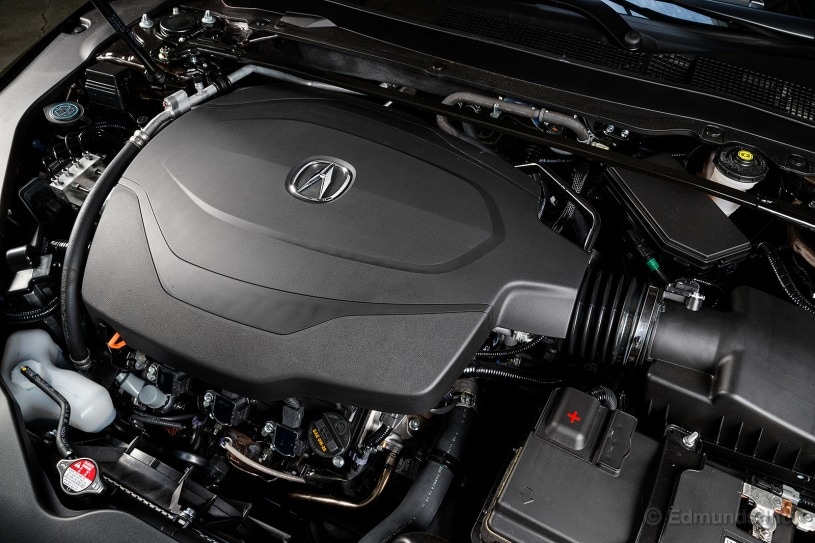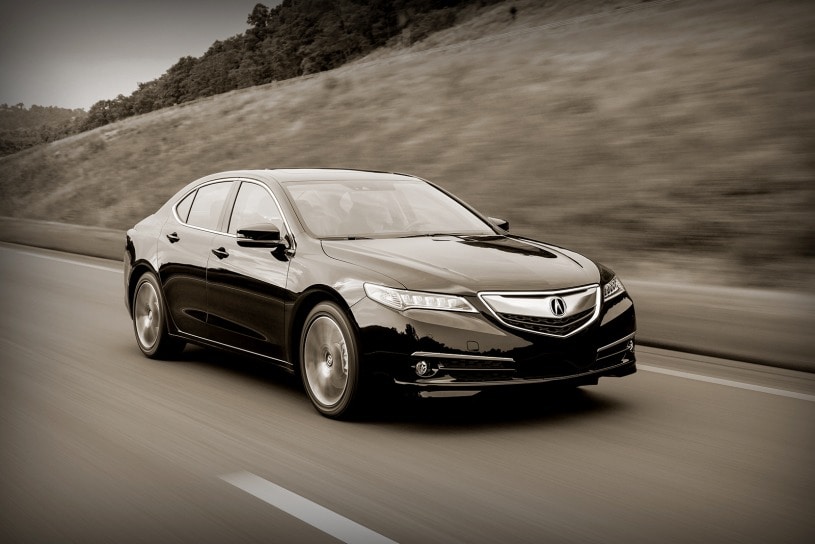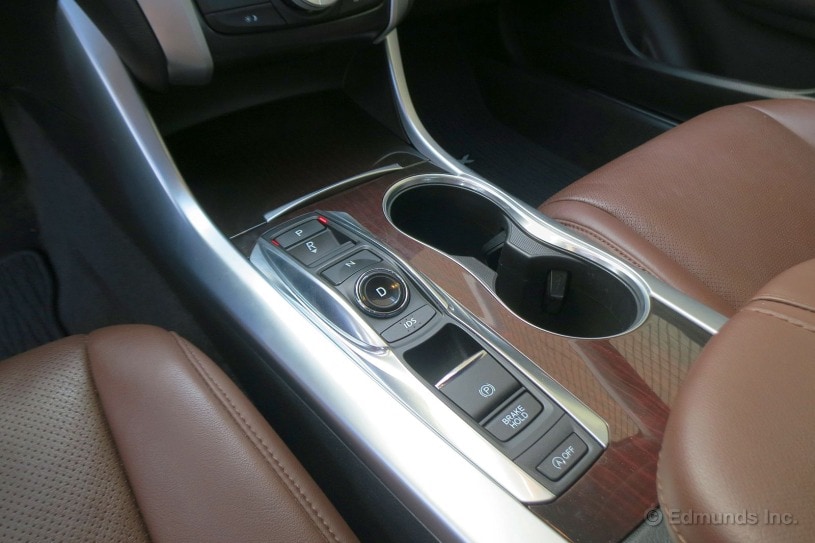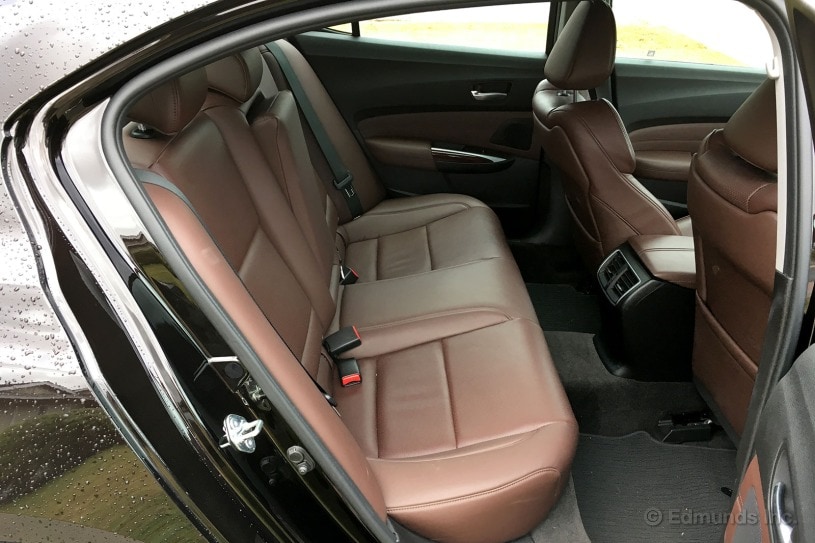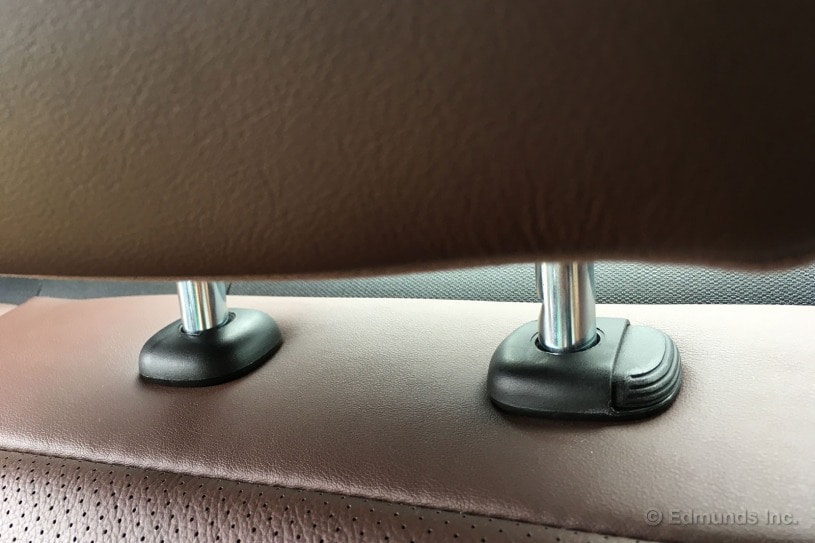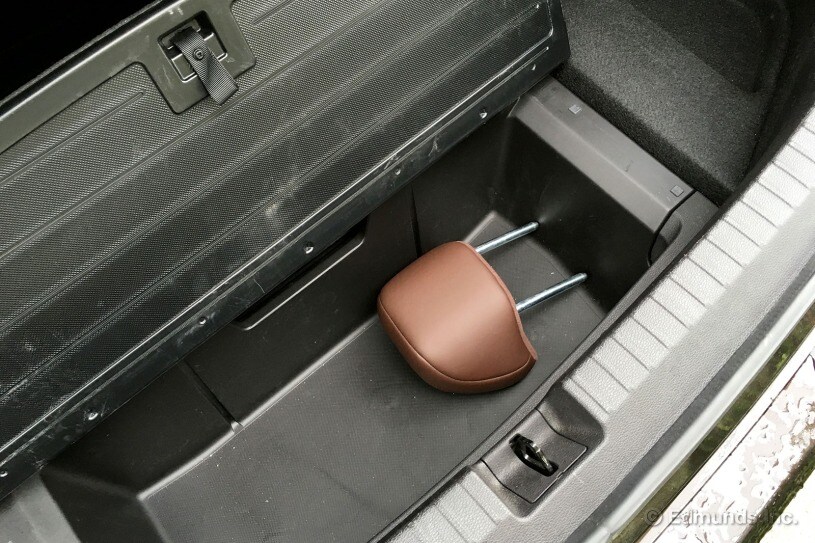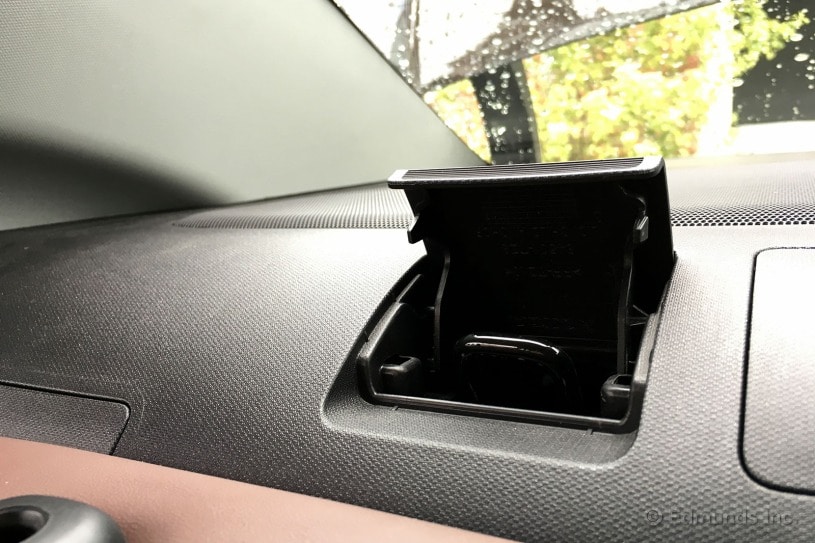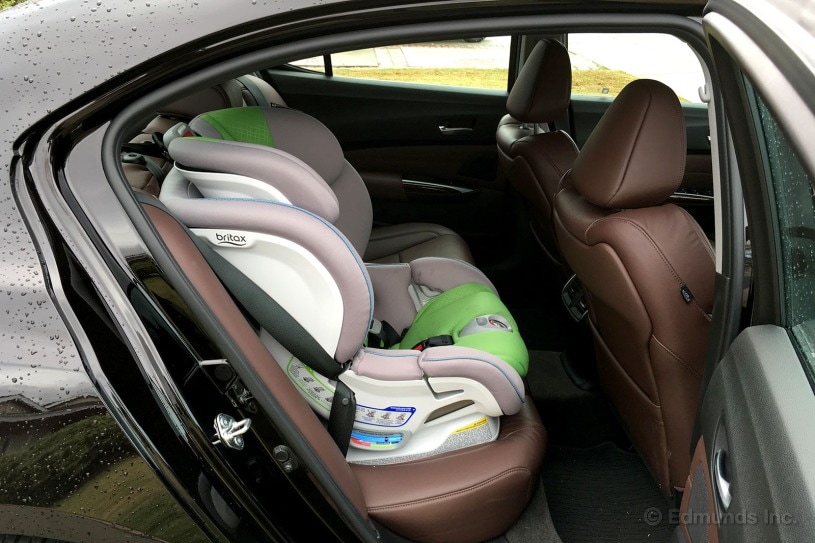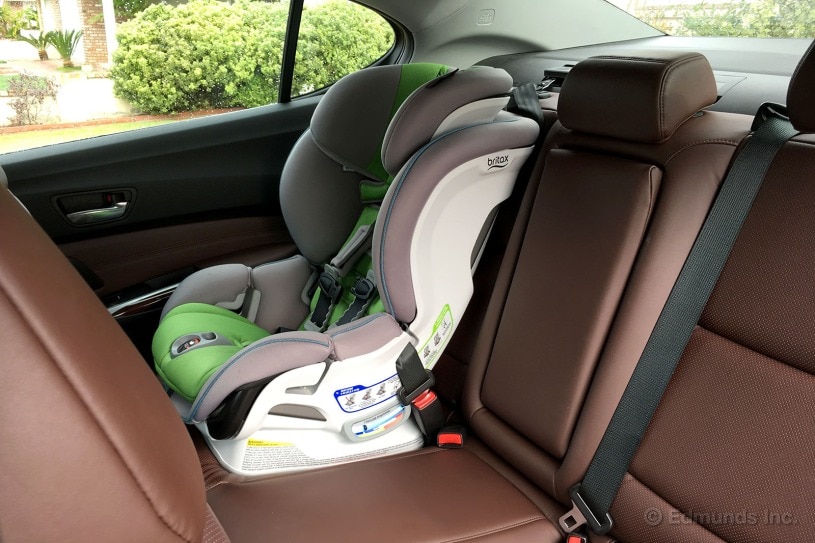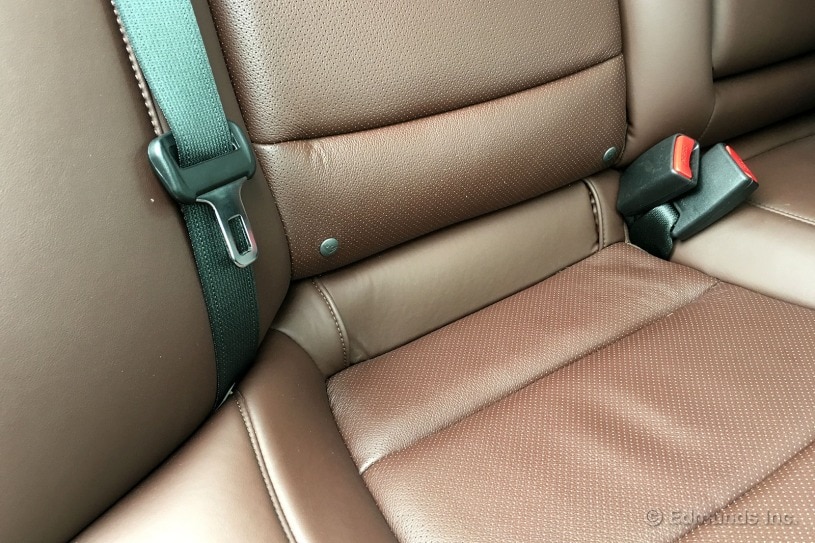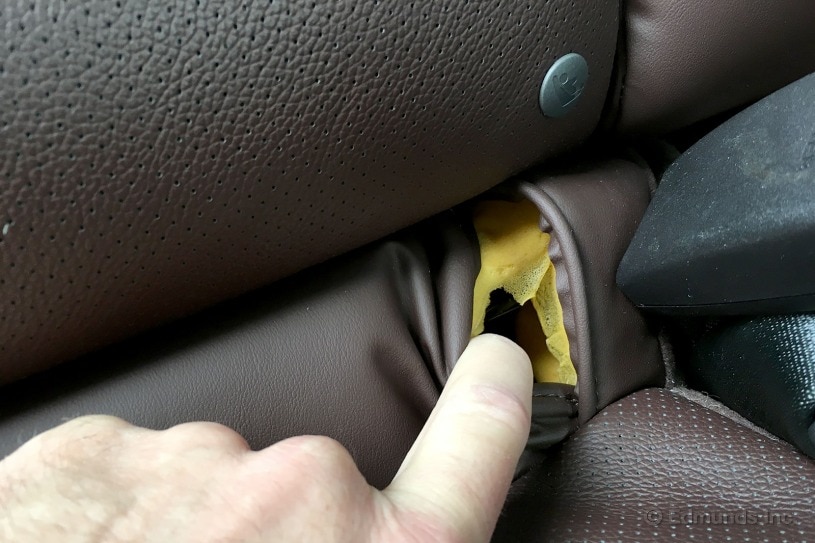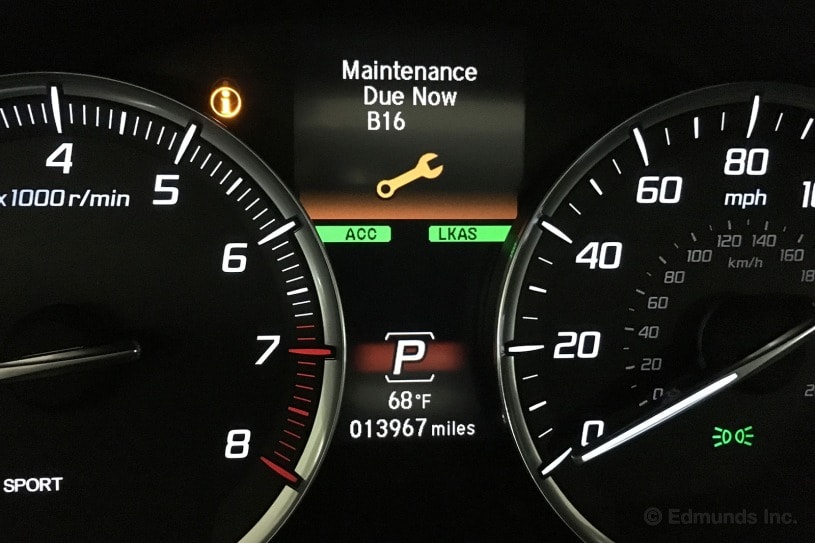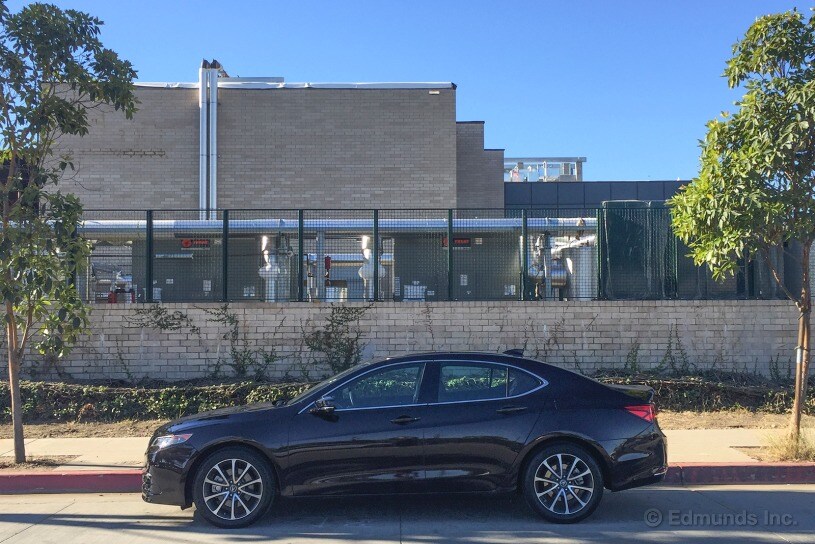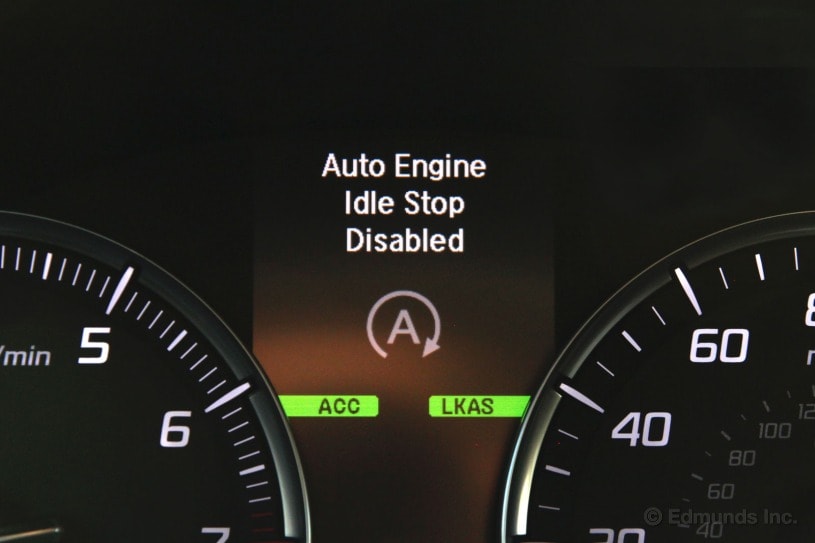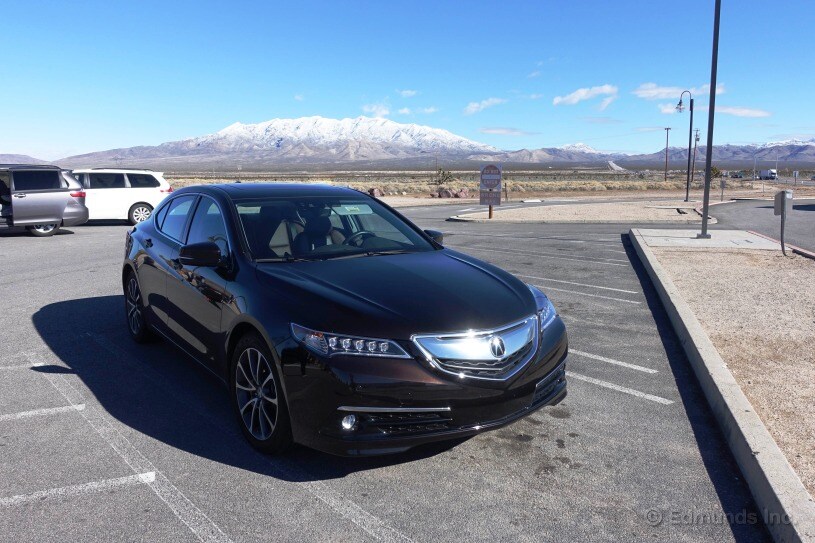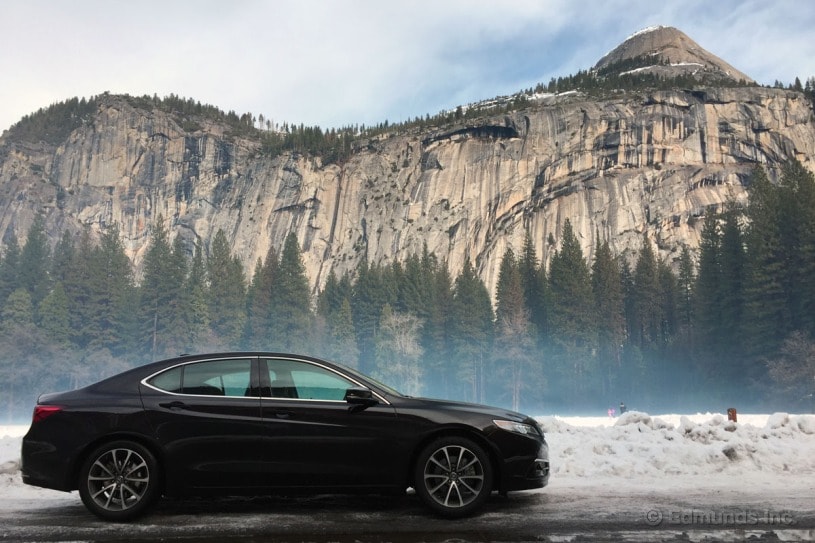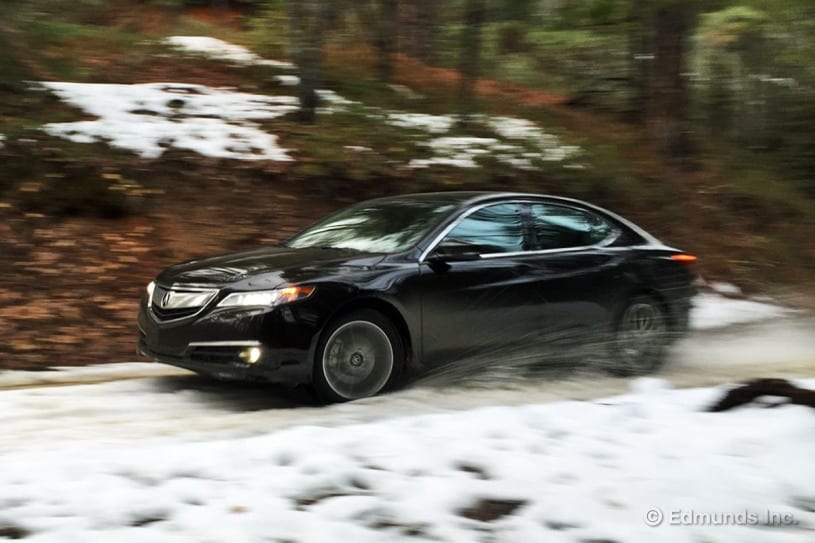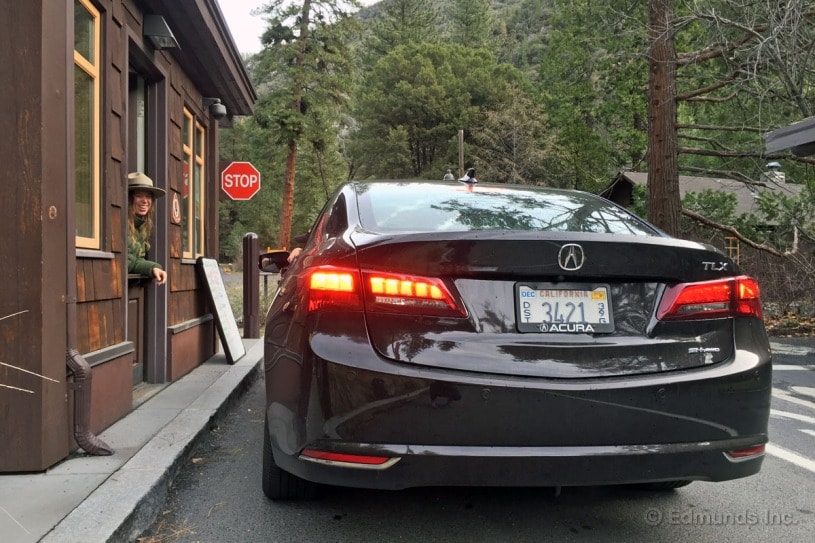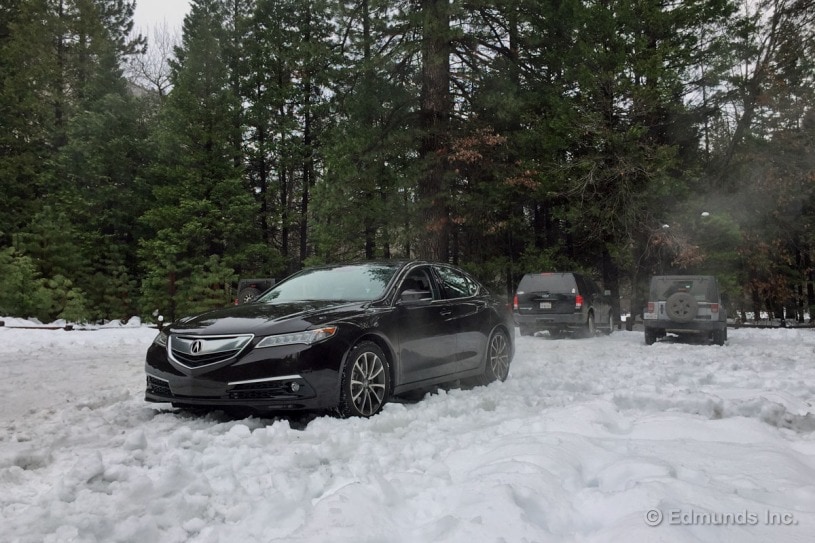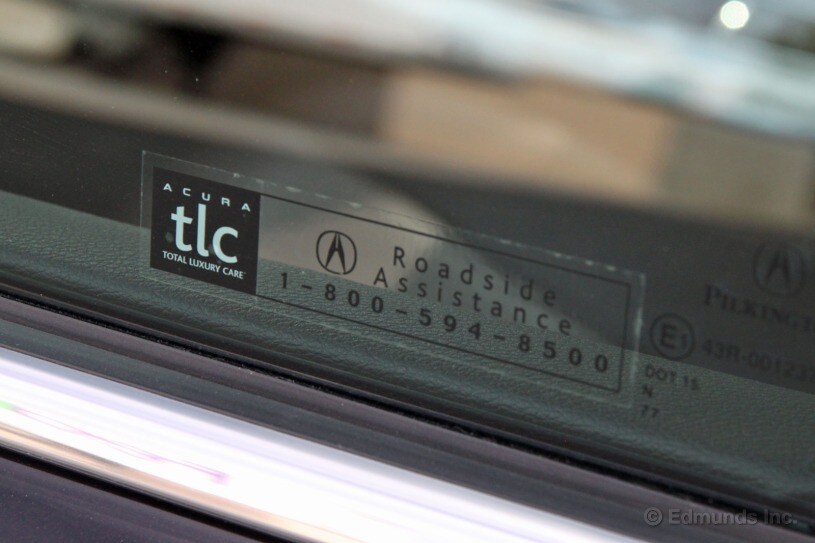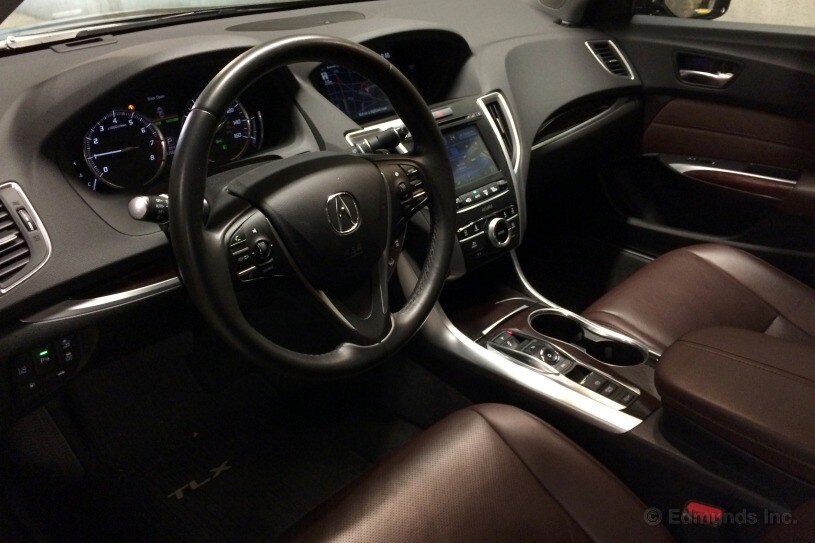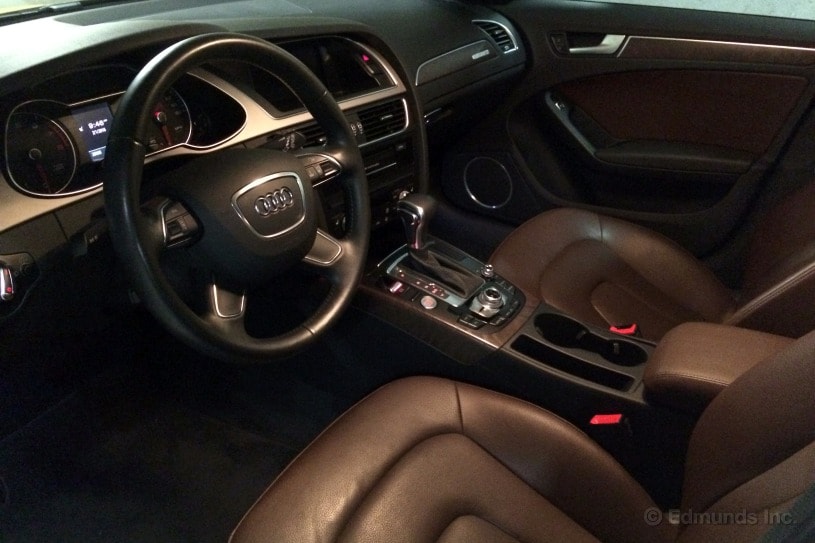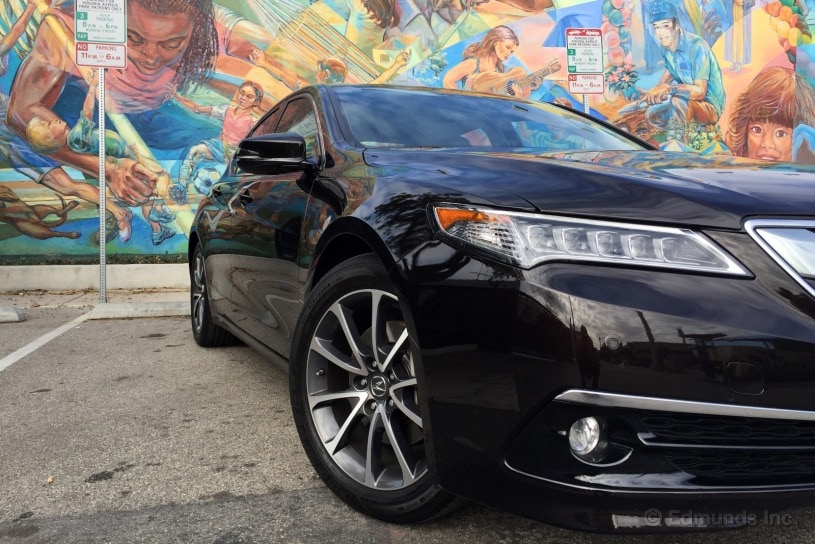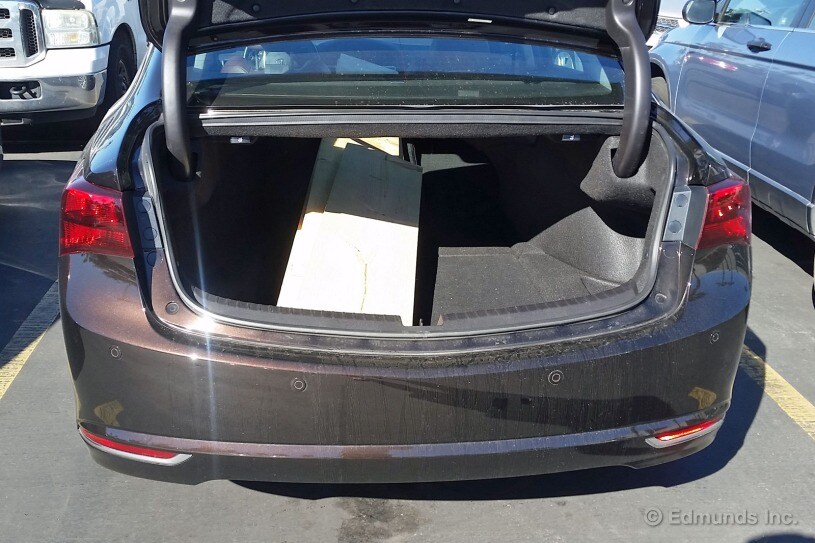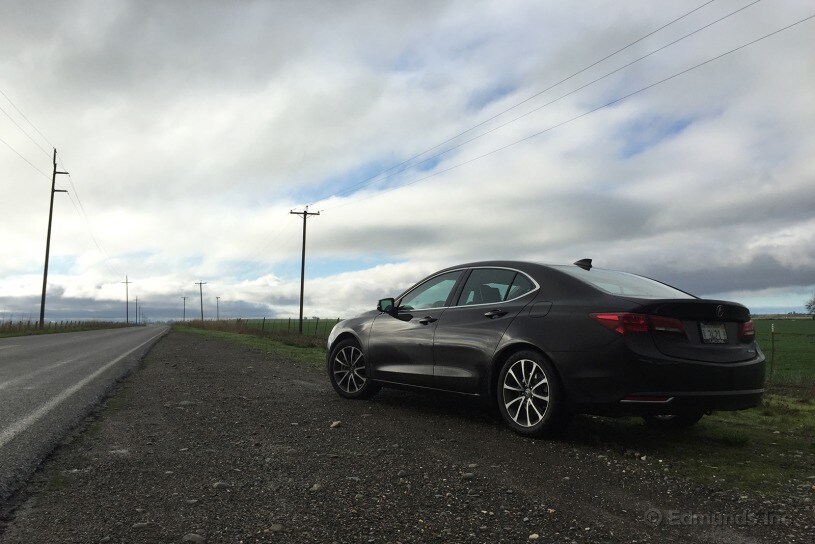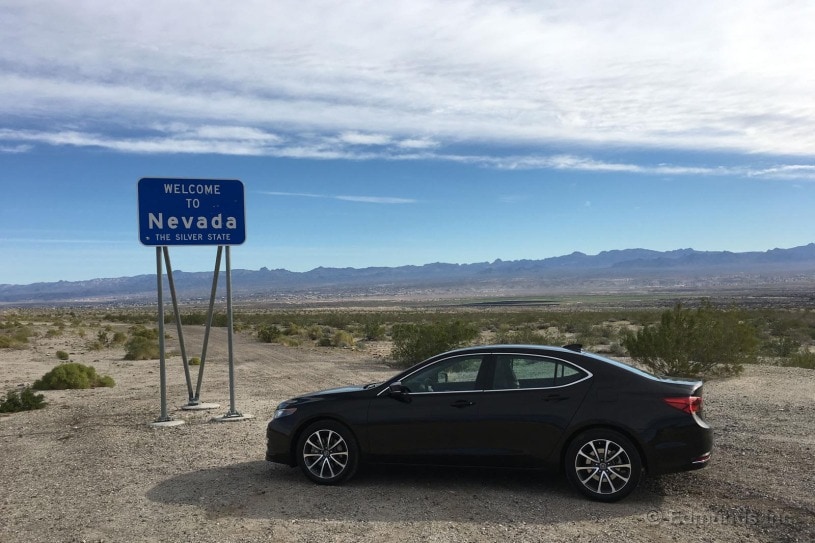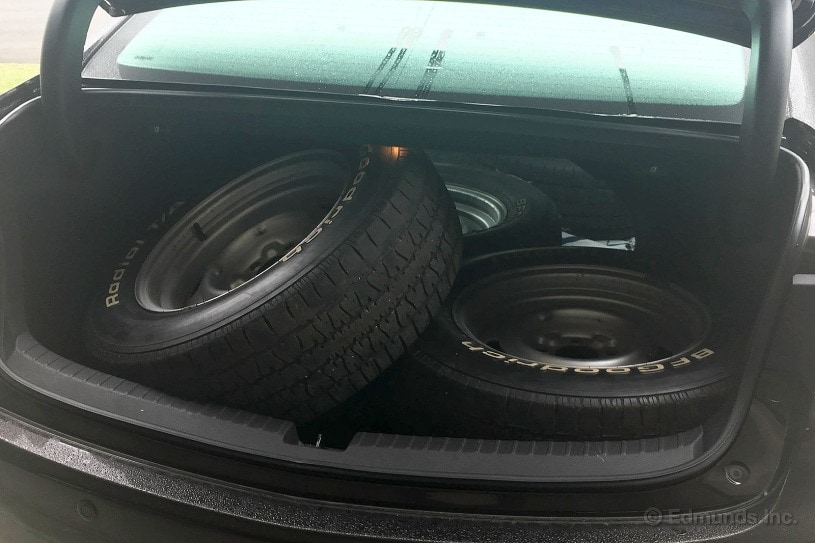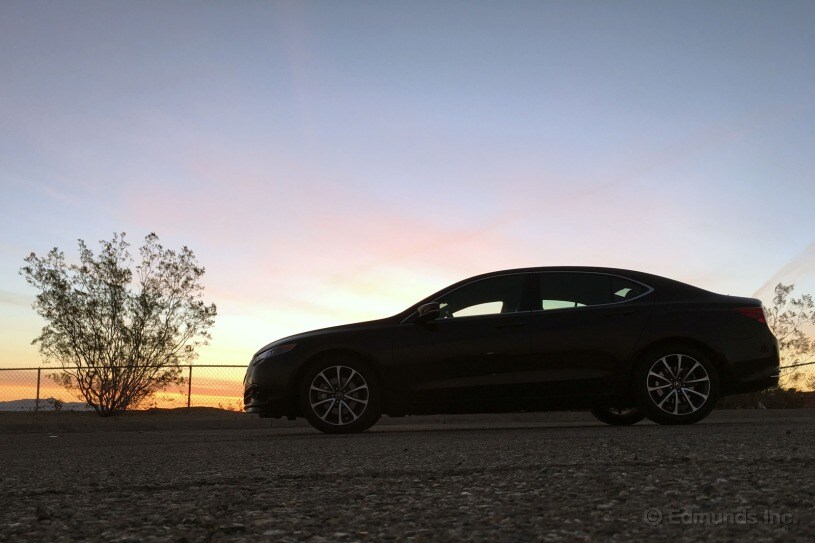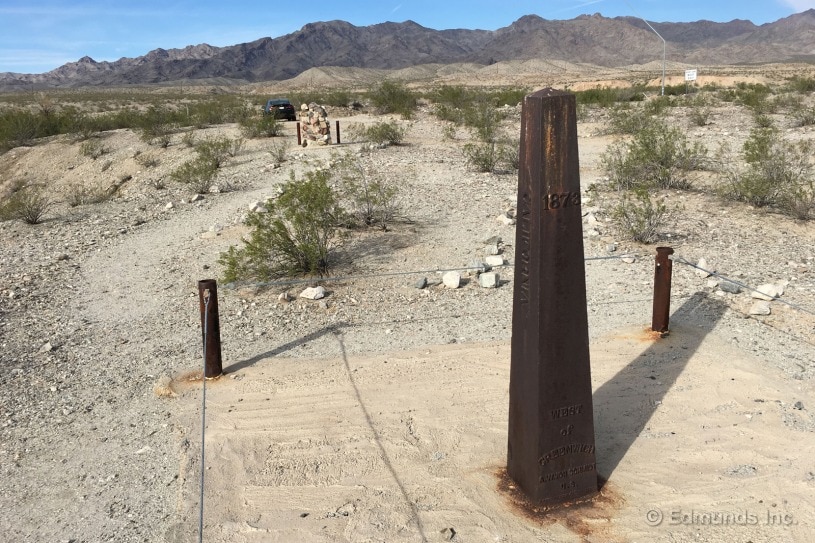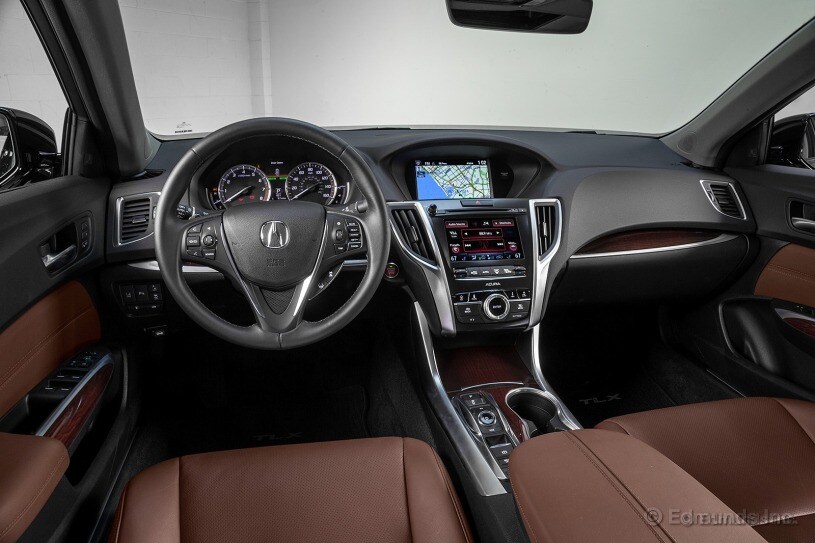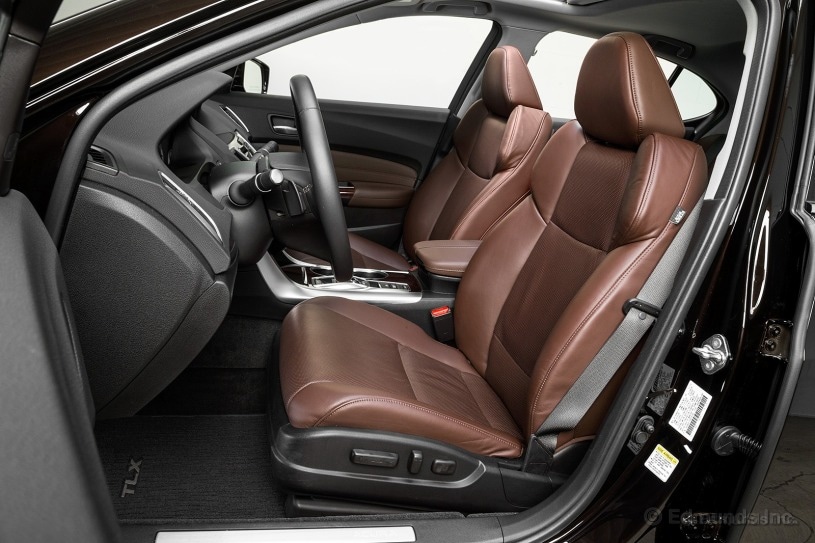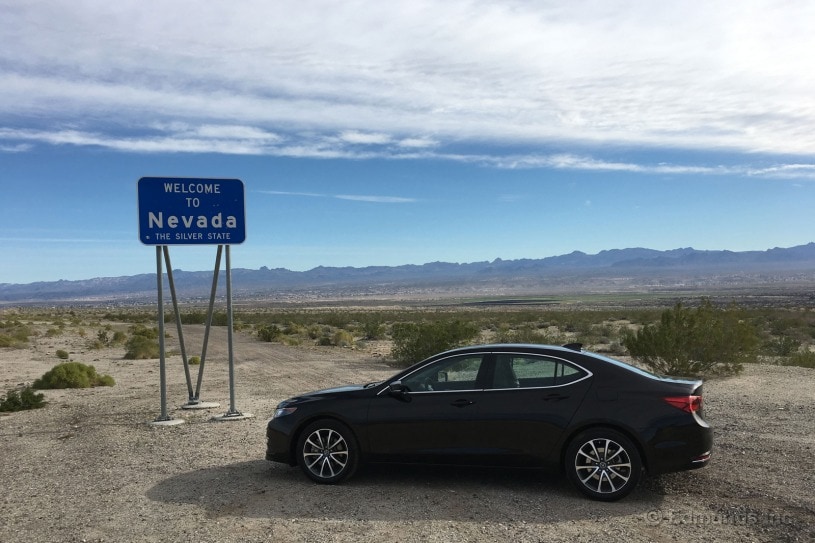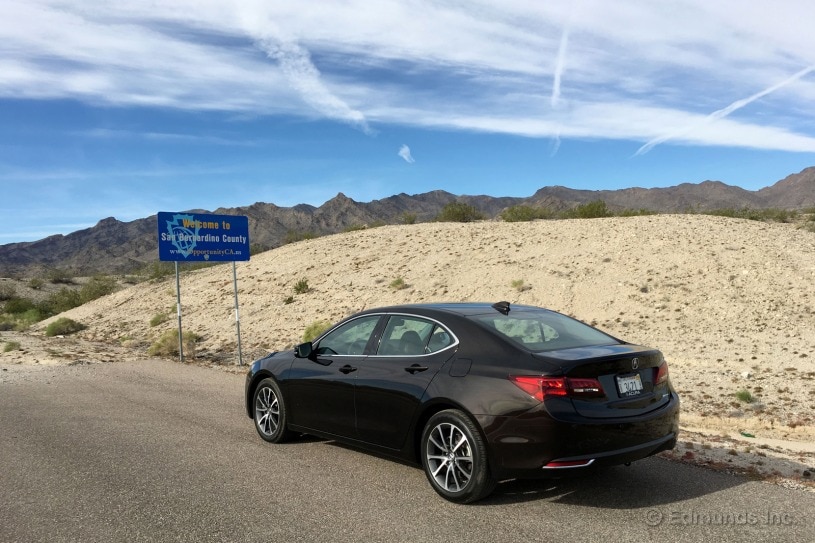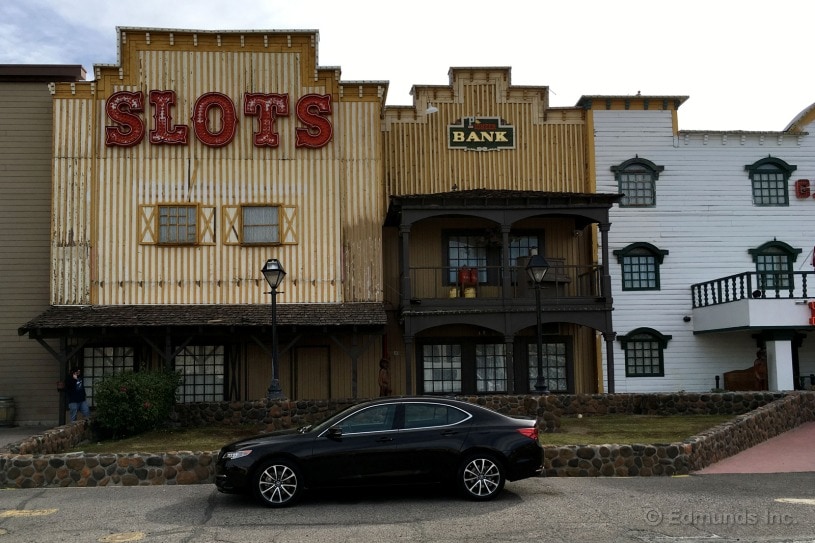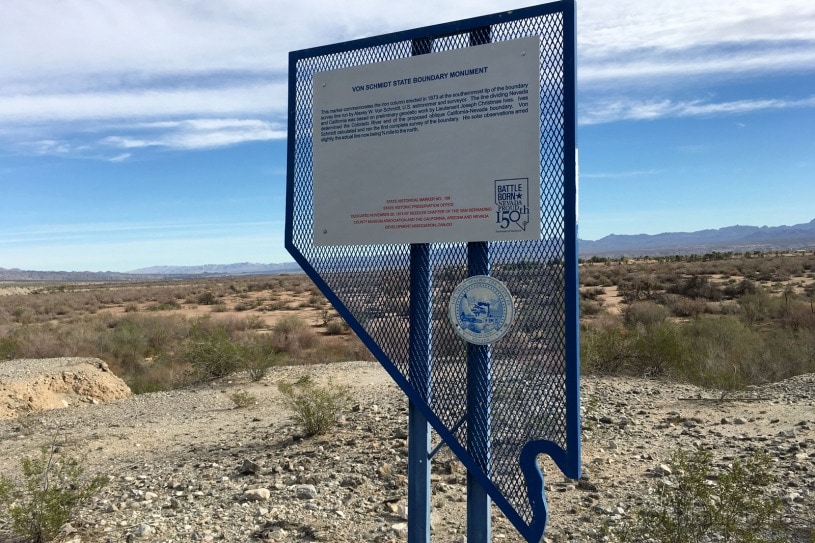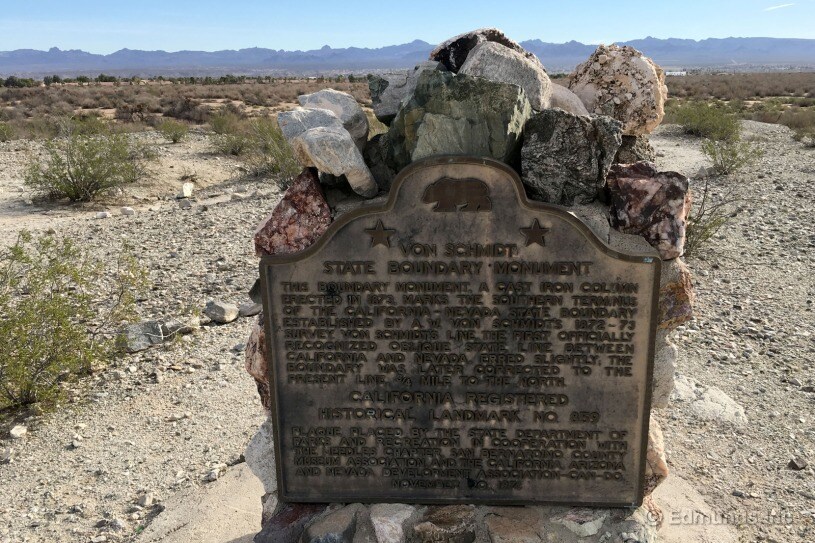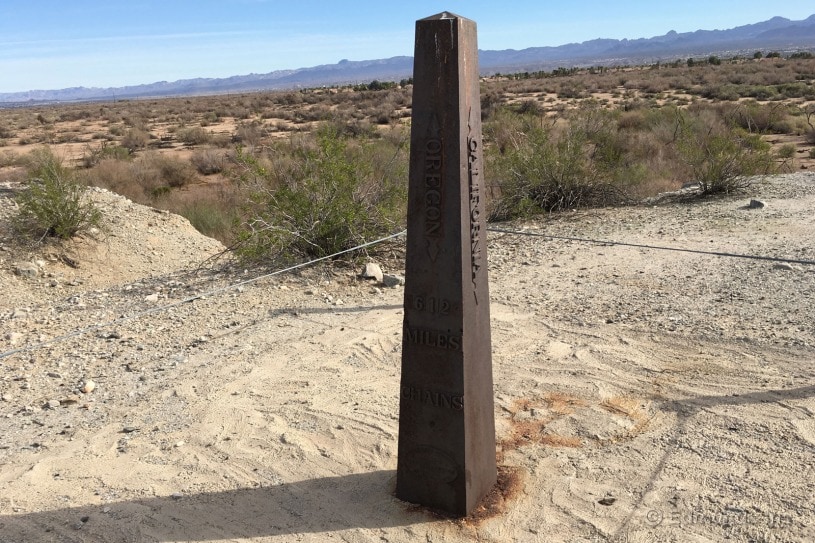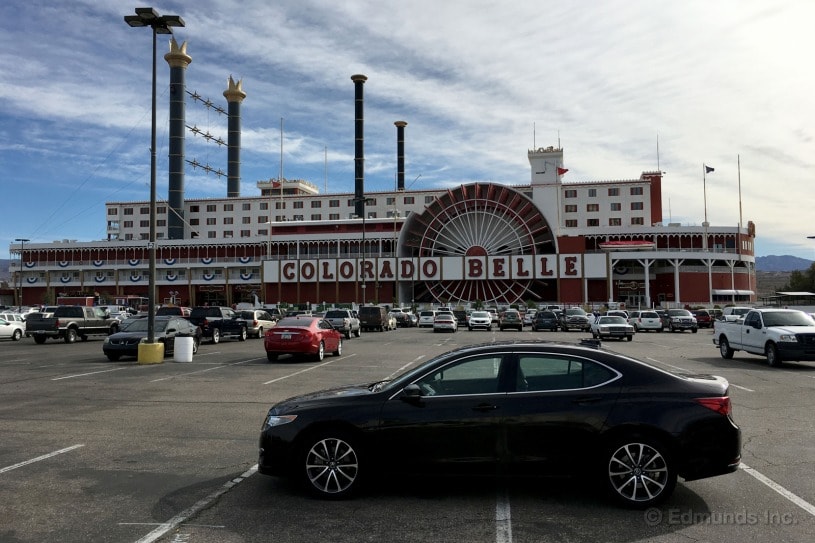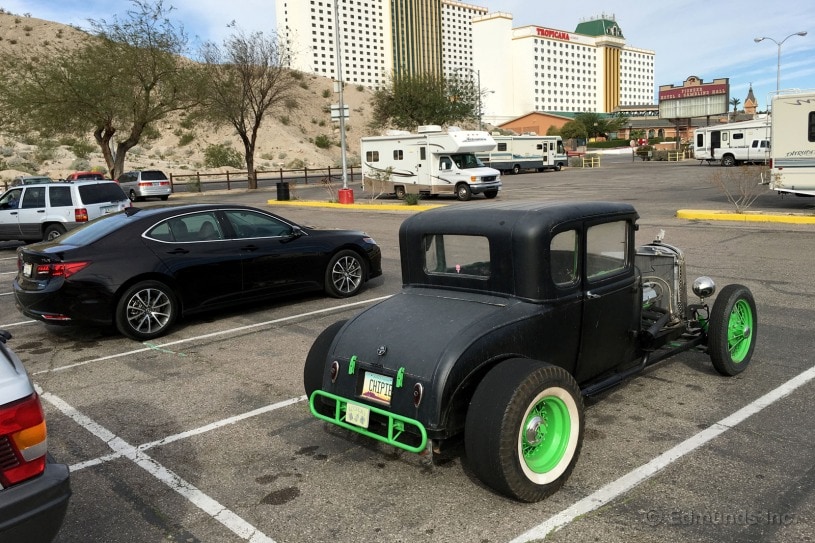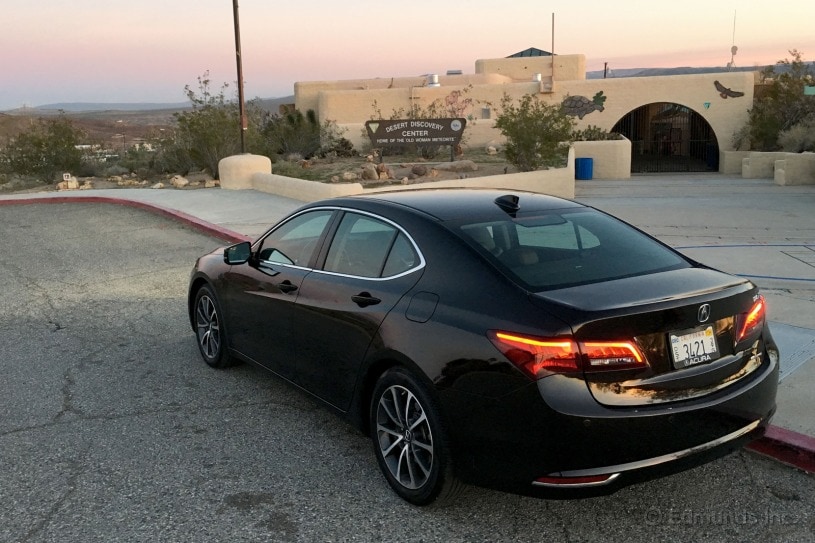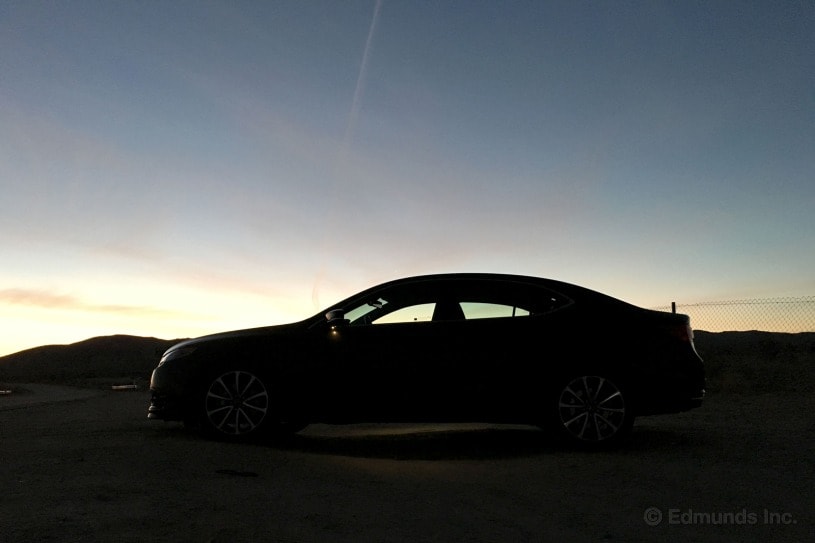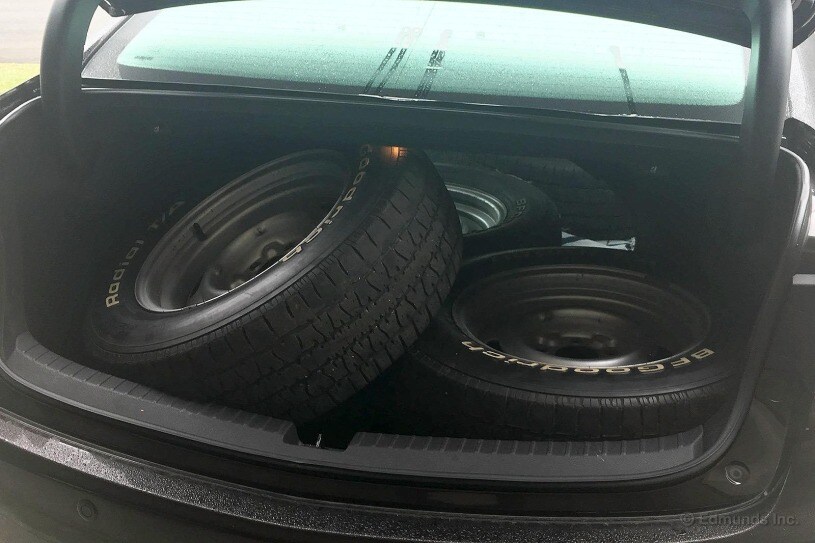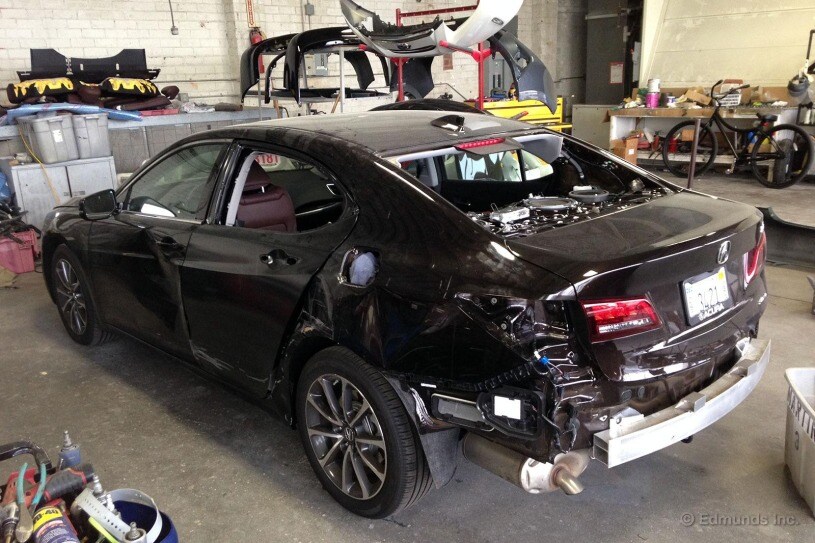2015 Acura TLX SH-AWD: What's It Like to Live With?
Read the latest updates in our long-term road test of the 2015 Acura TLX SH-AWD as our editors live with this sedan for a year.
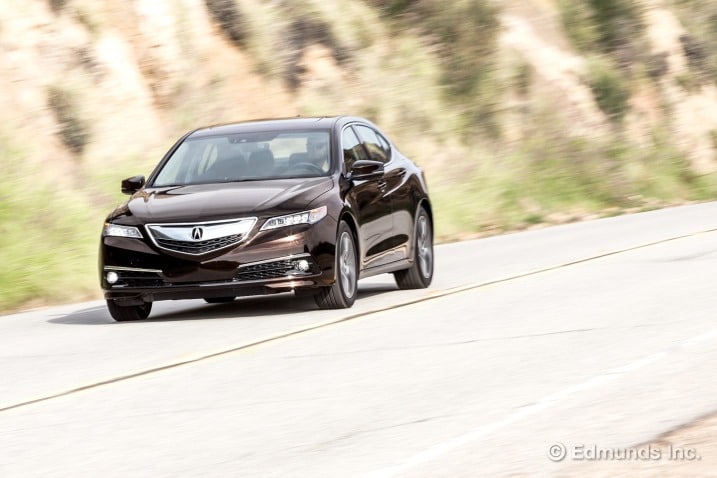
What do you want to know about?
- Introduction
- Push-Button Shifter Works Just Fine
- Nearly Perfect Gauges
- Quiet Ride
- Rough Start-Stop System
- Serious Light With Signature Style
- Slow Reacting User Interface
- A V6 With Brawn and Brains
- Performance-Tested - How Does The V6 Compare to the Four-Cylinder?
- Indecisive Adaptive Cruise Control - How Does The V6 Compare to the Four-Cylinder?
- Crash-Tested
- Behind the Scenes at the Body Shop
- Behind the Scenes at the Body Shop, Part 2
- Cops Like It
- Comes Off the DL, Ready for Summer Miles
- Trying Too Hard
- Impressive Safety, Steering and Fuel Economy on Long Highway Run
- Accidental Trunk Release
- Confirmation Beep Will Not Be Silenced
- Driver's Door Makes Notchy Noise Now
- Fuel Economy Update for July - Squeezing a Tank for Nearly 500 Miles
- Embracing Our Autonomous Future
- Time For Service
- Bringing the Wheels Back in Balance
- Service and a Surprise
- Will Change the Way You Park
- Turns On Its Road Trip Charm
- Transmission Makes Abrupt Upshifts
- Fuel Economy Update for August - Increasing Efficiency
- ELS Sound System Puts You 10 Feet From Stardom
- Top Five Things I Like About It (You Won't Believe #4!)
- Classy and Comfortable for Four Adults
- Packed Full for a Vegas Trip
- Not a Fan of Screen Washout
- Hailing the Glory of Auto-Cooled Seats and Smart Backup Cams
- Critics Agree - ELS Audio is Pretty Darn Good
- Fuel Economy Update for September - Road Trips Increase Lifetime MPG
- Rear Passengers Get Vents Too
- Good Sidewall Helps Make a Smooth Ride
- Seat Wear After 10,000 Miles
- When Feeling Blue Is Good
- Sport Equals Normal
- Trying to Like It
- Fuel Economy Update for October: Settling Into Real-World Numbers
- Ergo Design Makes for Frozen Fingers
- No Heated Steering Wheel or Soup for You
- B16 Bingo for Maintenance
- SH-AWD Is Pretty Cool
- Did You Just Stall?
- Prefer Onboard Navigation to My Phone's
- If 6 Was 4 - Why Less is More
- Fuel Economy Update for November: Incremental Increase
- Awkward Conversations
- Easy Child Seat Installation
- Due for B16 Service
- Pricey Second Service
- I Would Rather Pay for the Gas
- Vegas Road Trip Impressions
- Kicks Yosemite's Big Snowy Butt
- Luxury Car Extras
- What Can Brown Do For You?
- Brake Shake
- Utility When You Need It
- Fuel Economy Update for January - Almost on the Nose With EPA Rating
- Will It Go 500 Miles on a Tank?
- Man, That's a Huge Trunk
- 600 Miles In a Day
- Wrap-Up
Introduction
What Did We Get?
Our latest addition to the long-term fleet is a two-for-one deal. Allow us to explain.
The story starts a few years back when the third-generation Acura TL became an unexpected hit between 2004 and 2008. It was the right size, looked great and offered tremendous value. But then subsequent generations slowly got bigger, less interesting to drive and a bit odd-looking.
Even after some redesign rhinoplasty, the TL never got its groove back, so when the time came for an all-new car, Acura tried something radically different. Instead of merely updating the TL, it would create an all-new car that would take the place of both the TL and the smaller, compact TSX sedan.
The 2015 Acura TLX SH-AWD is that something new, and given its critical role in the company's lineup, we knew it deserved a place in our long-term road test fleet for the next year.
What Options Does It Have?
Like big brother Honda, Acura eschews the à la carte options list, favoring instead a rigid system of options lumped into very specific styles.
The base TLX starts at $32,365 and includes a 206-horsepower 2.4-liter four-cylinder, eight-speed dual-clutch transmission with paddle shifters, all-wheel steering, heated front seats, LED headlights, touchscreen display, Bluetooth, rearview camera, Siri Eyes Free and keyless ignition. That's a heckuva good starting point, but our new long-termer is a few steps up the ladder.
Specifically, it's the 2015 TLX 3.5 V6 9-AT SH-AWD with Advance package. That's a mouthful, so let us break down what its $45,720 price includes.
For starters, this TLX swaps the four-cylinder for a 290-hp 3.5-liter V6 and the eight-speed automatic for a nine-speed gearbox. Instead of front-wheel drive, it gets Acura's Super-Handling all-wheel drive. These changes result in a drop in EPA-estimated fuel economy to 25 mpg combined (21 city/31 highway) from 28 mpg (24 city/35 highway).
The included Tech package adds navigation with voice recognition, AcuraLink real-time traffic, an ELS Studio Premium 10-speaker stereo, perforated leather-trimmed seats, a blind-spot monitor, forward collision warning, lane keeping assist, rain-sensing wipers and a rear cross-traffic monitor. The Advance package further ups the safety with adaptive cruise control, collision mitigation braking, road departure mitigation, front and rear parking sensors, LED foglights and remote engine start. V6 models also have a push-button gear selector that replaces the normal lever-based selector. This is sure to be a talking point.
Why We Got It
Attempting to replace two models with one doesn't happen often. So when Acura decided to do just that by discontinuing its TSX sedan and TL sedans in favor of the all-new TLX, it was a bold move.
With a choice of a base four-cylinder engine or an optional V6, along with either front- or all-wheel drive, the TLX covers a range of price and performance. Regardless of how it's equipped, the TLX is a capable handler that's remarkably comfortable and quiet on long drives, and it offers a truly impressive suite of features for the price.
Its biggest hurdle is the competition. The TLX sits squarely in the heart of the entry-level luxury sport sedan segment. Cars like the Audi A3/A4, BMW 3 Series, Cadillac ATS and Mercedes-Benz C-Class are fighting for the same customers as the TLX, so it has to offer a little bit of everything to compete. On paper, it looks as though it has all the tools it needs, but we'll see if it delivers over the next 12 months. Follow along on our long-term road test blog to see what it's like to live with Acura's newest sport sedan.
Best MPG: 23.5
Worst MPG: 19.2
Average MPG over 1,289 miles: 22.1
The manufacturer provided this vehicle for the purpose of evaluation.
It's easy to look at the push-button transmission shifter in our 2015 Acura TLX and think it's overkill. I'm usually the first person on our staff to take this stance. Why take a perfectly good shift lever and turn it into several buttons?
Turns out such angst isn't necessary. After putting several hundred miles on our Acura TLX I got used to the newfangled setup without much effort. So much so that I can do a three-point turn without even thinking twice about it.
I think it works for two reasons. One, the "drive" button is not only big, it's right in the middle. It doesn't take much fumbling around to find it. Two, instead of a button for reverse, it basically has a rocker switch that you actually pull backwards. Yes, pull backwards to go backwards, ingenious. Park is just a button which is no different than plenty of other cars while rarely used neutral is somewhere you're not like to push unless you mean to.
Maybe I'll get into a situation where this setup becomes annoying, but so far I haven't found one.
Can't tell you how nice it is to see a clear set of analog gauges in our 2015 Acura TLX. I mean, this is a car that oozes technology from every corner. The fact that designers were able to keep at least some of that technology out of the instrument cluster is surprising.
Sure, there's a reconfigurable information screen in the middle, but it's not overly intrusive. Instead you get two large, easily readable dials for the important stuff and a couple auxiliary gauges for the temperature and fuel. It's actually the same setup Acura used in the first-generation Integra, you know, back in the late 1980s. Worked well then, still works well today.
Having spent the past few days driving our long-term 2015 Acura TLX, I'm impressed with how quiet the ride is, even on the freeway, and even with the audio system switched off. Road, wind and engine noise are kept to a minimum, not always the case in a Honda/Acura product. The cabin is peaceful and comfortable.
This is a nice car if you can afford its $45K sticker price. While it's not as sporty as a BMW or as plush as a Mercedes, it is definitely a standout in this size/price segment.
I own a 2015 Acura TLX. I bought my TLX in September, and I test drove both the four- and six-cylinder versions before making a choice. I decided to go with the four-cylinder base model. I have about 6,500 miles on the thing so far and I must say I'm really enjoying it.
As much as I the four-cylinder TLX, I often wonder if I should have gone with the bigger engine. I traded in my beak edition 2011 Acura TL Technology Package for the TLX after becoming accustomed to the extra horsepower and torque from the 3.5-liter V6.
So you can bet I was thrilled when I heard we were adding the TLX V6 SH-AWD with Advance Package to our fleet. Now I'd get chance to spend some time in the bigger engine. As an added bonus, I'd get to see some of the additional smart features in action.
This was my first weekend with one of our newest additions and I'm impressed. Lots of content for the price and an engaging drive. Comparing my previous TL and the new V6 TLX, the drive feels similar, which is a good thing. Over the 350 miles or so I drove this weekend, however, I noticed two big differences. One, I loved. The other, not so much.
First, the TLX's nine-speed automatic is just awesome compared to the five-speed in my old TL. The shifts are a whole lot smoother and quicker. I enjoyed the ride in my TL, but the TLX does an even better job thanks to the new transmission.
The other difference is the TLX's Auto Engine Idle Stop. I don't have this feature in my four-cylinder TLX and didn't have it in my 2011 TL. I've spent a lot of time in cars with auto start-stop. I was first introduced to it back in 2003 when Honda made it a standard feature on the Civic Hybrid.
I've never really liked auto-stop systems and our TLX has done nothing to change that. The restart on the TLX V6 is more jarring that what I remember in the Civic Hybrids I sold for many years. Perhaps because of the hybrid's small engine size, the re-start was easier to ignore. Hard not to notice when the 3.5-liter V6 power plant re-starts, though.
But there are two easy ways to bypass this. One is by pressing the button that turns the system off, located on the shifter about three inches from the drive button. The other way is by not laying into the brake. Make a complete stop without pressing the brake pedal all the way down to the floor and the engine keeps running as usual. Press it all the way and the engine shuts off as intended.
I look forward to my next go round with the TLX V6. So far, it trumps my 2011 TL. I'm curious to see if, by the end of our time with the TLX V6, I regret getting the smaller engine in my personal car or feel even better about my choice.
With the arrival of the 2015 Acura TLX, and the updated 2016 ILX sedan and 2016 RDX SUV, all Acura models now feature what the company calls "Jewel Eye" headlights. They're technically LED headlights surrounded by LED accent lights. The only remaining non-LED lights are the turn signals.
The high-tech setup gives the TLX, and the whole Acura lineup for that matter, a signature look at night. More importantly, the light pattern that the LEDs throw out is not only bright, but has great reach, both directly ahead and to the sides. I'm not sure it's a huge upgrade over the xenon headlights found on most luxury cars now, but there's no doubt that this TLX throws a strong beam of light on a dark road.
The high-beam lights are LEDs, too. They're actually the two innermost bulbs of the row while the low beams use the outside three. I haven't been on a truly pitch-dark highway in awhile, but in the few situations where I did use the high beams, they had excellent coverage. So although these Jewel Eye lights are definitely a styling statement, they do deliver some serious light, even when no one but the driver is around to see them.
There are plenty of pros and cons to discuss when it comes to Acura's driver interface. It uses a large central knob at the base of the center stack to access menus on the screen at the top of the center stack. In between is another screen but that's only for radio and ventilation controls. Got it?
It seems a little wonky at first and remains so until you get used to where everything is located. Once you're accustomed to where the various vehicle functions reside, the setup feels much more logical. Still there's one problem: speed.
Accessing the navigation, phone and information menus with the rotary knob is frustratingly slow. On numerous occasions I've made the wrong selection because I turned the knob, pressed it and then realized that the system was a step behind. It seems like more of a problem in some menus than others, so there are instances where it works just fine, zooming in and out of maps being one example.
I've slowly become more accustomed to how the system works and reacts, but after using tablets and phones that do everything so quickly, this setup feels a little old already.
Opting for the 3.5-liter in the 2015 Acura TLX not only puts 290 horsepower under the hood, it also gives you the chance to get more than 30 mpg on the highway. At least, that's what the EPA says.
Since we're barely past the break in miles, our TLX hasn't had a chance to show what it can do in the efficiency department, but it has all the tools. Matt Jones has already talked about the start/stop system which is a slightly controversial feature. On the flip side, this V6 also has Acura's Variable Cylinder Management (VCM) system, which can shut down half the cylinders under light load.
Unlike the more obtrusive start/stop system, VCM is virtually undetectable. I didn’t even realize this engine had VCM until I read the spec sheet. The technology behind it is quite complex, but its implementation is flawless.
Until I have the chance to stretch this car out on a long highway drive, I'll reserve judgment on its efficiency in the real world. So far it's delivering somewhere in the low 20s in combined driving, but expect that number to increase in the next few months.
Rising from the ashes of the TSX and TL is the new 2015 Acura TLX. It fits between the retired sedans in both size and price, and is powered by tweaked versions of the 4- and 6-cylinder engines from the TSX.
We had a choice to make when we ordered our long-termer. Even with a new eight-speed dual-clutch transmission, we were underwhelmed with the 4-cylinder model's performance. We opted instead for a configuration more suited to our tastes: V6, nine-speed automatic, and all-wheel-drive.
With the car fully broken in, it was time to get numbers for our TLX. Scroll down to see how it compares to a TLX with the 4-cylinder engine and all-wheel steering.
Vehicle: 2015 Acura TLX 3.5 SH-AWD
Odometer: 2,265
Date: 4/14/2015
Driver: Josh Jacquot and Mike Monticello
Price: $45,720
Specifications:
Drive Type: All-wheel drive
Transmission Type: Nine-speed automatic
Engine Type: Naturally aspirated V6
Displacement (cc/cu-in): 3,471 / 212
Redline (rpm): 6,800
Horsepower (hp @ rpm): 290 @ 6,200
Torque (lb-ft @ rpm): 267 @ 4,500
Brake Type (front): One-piece ventilated disc with dual-piston sliding calipers
Brake Type (rear): One-piece solid disc with single-piston sliding calipers
Suspension Type (front): MacPherson strut, antiroll bar
Suspension Type (rear): Independent multilink, antiroll bar
Tire Size (front): 225/50R18 95H M+S
Tire Size (rear): 225/50R18 95H M+S
Tire Brand: Goodyear
Tire Model: Eagle LS2
Tire Type: All-season
As tested Curb Weight (lb): 3,766
Test Results:
Acceleration:
0-30 (sec): 2.3 (w/ TC on 2.4)
0-45 (sec): 3.9 (w/ TC on 4.0)
0-60 (sec): 6.1 (w/TC on 6.1)
0-60 with 1-ft Rollout (sec): 5.8 (w/TC on 5.7)
0-75 (sec): 8.6 (w/TC on 8.6)
1/4-Mile (sec @ mph): 14.3 @ 98.3 (w/TC on 14.2 @ 98.3)
Braking:
30-0 (ft): 30
60-0 (ft): 120
Handling:
Slalom (mph): 64.5 (64.0 w/ESC on)
Skid Pad Lateral acceleration (g): 0.86 (0.87 w/ESC on)
RPM @ 70: 1,500
Acceleration comments: There isn't much the driver can do here to make the TLX go quicker. Pretty much all of the runs were within a tenth of a second of each other, regardless of whether traction control was on (fairly meaningless, since it gets full traction thanks to all-wheel drive), whether we did or didn't use power-braking (overlapping throttle and brake prior to launch to bring the revs up) or whether the transmission was in Normal or Sport Plus.
The V6 is strong and revs hard and quickly. It sounds sporty, too. Upshifts come at the same point every time: 6,800 rpm. They are smooth, but not overly quick. Even in manual mode the transmission auto-upshifts at 6,800 rpm, but it does blip the throttle on downshifts. Manual shifting is via steering wheel paddles only.
Braking comments: Firm pedal initially, got softer on later runs and by the sixth stop we had major pedal fade (lengthening of the pedal travel). By the time we finished our acceleration runs, we were getting noticeable brake judder. The TLX also exhibited some side-to-side squirm with every run, enough that it required correction with the steering wheel.
The first stop was 122 feet, the second stop was the shortest at 120 feet, the fourth stop was the longest at 124 feet and the sixth and final stop was 123 feet. Although we experienced pedal fade, the distances barely changed.
Handling comments:
Slalom: Medium steering weight. Electronic stability control intervenes even when off. Even so, ESC still manages to be fairly effective by managing the throttle only marginally. Obvious body roll. Low-grip rubber. Overall good balance, but still a fairly big, heavy sedan.
Skidpad: Active rear differential very obvious in this test. Makes the car rotate very easily when steering is added. Still, the TLX is hampered by low-grip tires, which really set the limit. Constant adjustments require adaptation from the driver to maximize their effectiveness.
Here are the instrumented results for the V6 all-wheel-drive and inline-4 with all-wheel steer. Both cars wore Goodyear Eagle LS2 all-season tires. Tire size for the V6 was 225/50R18 95H all around, while the I4 had 225/55R17 97H tires.
|
2015 Acura TLX 3.5 SH-AWD |
2015 Acura TLX 2.4 P-AWS |
Curb weight as Tested (lbs.) |
3,766 |
3,474 |
0-30 (sec.): |
2.4 |
3.0 |
0-45 (sec.): |
4.0 |
4.8 |
0-60 (sec.): |
6.1 |
7.4 |
0-60 with 1-ft Rollout (sec.): |
5.7 |
7.1 |
0-75 (sec.): |
8.6 |
10.8 |
¼-mile (sec @ mph): |
14.2 @ 98.3 |
15.4 @ 87.6 |
Skid Pad Lateral Accel (g): |
0.86 (0.87 w/ TC On) |
0.84 (0.82 w/ TC On) |
Slalom: |
64.5 (64.0 w/ TC On) |
65.6 w/ TC On |
Braking 60-0 mph |
120 |
129 |
Braking 30-0 mph |
30 |
32 |
Our 2015 Acura TLX has adaptive cruise control. If I have to be a part of the unpredictable, mindless river of humanity that characterizes LA's terrible freeways, I like adaptive cruise control.
I do not like the adaptive cruise control on our TLX.
For starters, this system is extremely paranoid. It's an orchestra of beeps and warnings, most of which stem from something I can't identify. After 20-ish miles of random panic alerts, even my passenger started asking questions: "What was that for?" and "Why don't you turn that off?"
No idea. Good idea.
But I wasn't going to turn it off before I got these pictures. If you haven't used adaptive cruise control, here's how it works: You turn the thing on, set a speed, pick a following distance, and then leave it alone. The car ahead slows down and your car slows down. They speed up, you speed up until your set max speed. At least, that's the way it normally goes.
Our Acura doesn't seem to agree with this thinking 100 percent of the time. I set the ACC to a speed higher than I could ever hope to achieve in 30-50 mph traffic and was surprised when, about half of the time, it seemed to pick random speeds to stick to while the car in front went five, 10, or 50 car lengths out of our range.
Both cars were still dozens of MPH below the set speed threshold, but the Acura didn't care. The car in front was getting away and the TLX was perfectly happy allowing that.
Both of the pictures here were taken when the car ahead was going roughly the same speed and with ACC set to maintain the same distance. Please note that the distance is not even remotely the same.
When traffic came to a stop, the system responded reasonably correctly, lurching us to a stop far less smoothly than doing it myself, but avoiding a collision by a very safe margin. When speed picked up, I resumed the system and, again, the Prius got away when the TLX decided it was tired of keeping pace.
Adaptive cruise on the TLX is part of the Advance package, which includes must-haves (in my world) like remote engine start, front-and-rear parking sensors, and stuff that should be handy but isn't, like this ACC and road departure mitigation.
On the TLX 3.5, the Advance Package adds about $3,300 to the price of a TLX 3.5 with the Technology pack. I'm just not sure I'd pay that for remote start and parking beeps.
It looks worse than it is.
There I was, driving our long-term 2015 Acura TLX in the second-to-right-most lane of a well-lit, divided boulevard in Culver City at about 10 o'clock on a clear night. The pavement was dry, which is about what you'd expect in the desert during a drought. Two lanes over, a Toyota Camry was traveling in the same direction, the lanes between us empty on this wide street.
I prepared to move into the right lane so that I could turn right at the next intersection. At this point, the TLX and Camry are roughly directly across from one another. In rapid fashion, the Camry shot across the roadway, presumably to make the same upcoming right turn or to reach the fuel station at the corner.
The Camry's passenger front corner collided into the TLX's driver side. The impact lurched the TLX over a few feet, whereupon I eased the Acura alongside the curb and slapped on the hazards. It wasn't a violent hit and there were no injuries or property damage, unless you consider the kissing cars.
In the moment, there wasn't much time to do anything about the land-missile Camry. I spotted its oncoming trajectory in my peripheral vision just before impact.
Again, the damage looks worse than it is. The outer door skins soaked up the brunt of the collision and the TLX's occupants suffered minimal jolt. The front door still opens and latches, there is no obvious damage to the front sill or B-pillar, and the car drove straight and true afterwards. I even drove it to the office the next day.
Still, the car's pretty comprehensively worked over. Both doors are clearly trashed, the rear door doesn't open and the unibody aft of the rear door is crinkled. The rear wheel was lightly kissed, too.
There's not much of a lesson here other than: don't drive into the sides of other cars, kids.
Jay told you in his last blog that the collision damage to our 2015 Acura TLX "looks worse than it is."
Now it looks as bad as it is.
We got into the body shop to document the start of repairs on our TLX and it isn't pretty. If you're wondering, here's what $6,300 worth of broadside collision looks like:
After an unfortunate mishap with a wayward Camry, our 2015 Acura TLX was dispatched to the body shop. We got in to see the scenes of disassembly, and now it's time to start reconstructing the car. Here are the steps leading up to the paint room.
By now, the new rear door and left-side quarter panel are on. All areas to be painted are prepped with color-sanding. Any areas not needing paint are masked off, a prep-job that takes nearly a day itself.
The paint is mixed to match before the TLX finally goes into the big room for its makeover.
If all goes well, the TLX should be back in service by the end of this week.
Our 2015 Acura TLX is back. After several weeks at the body shop waiting on panels and parts, after spending time with Acura's engineers to make sure everything checked out copasetic, after a further delay to fix something with one of the speakers, our Acura mid-sizer is back on the road.
It's wasted no time making impressions, specifically on the police.
"This is a nice car. What is it?" a polite Irvine motorcycle cop asks me at a Saturday night sobriety checkpoint, alternating his flashlight between my license and the TLX interior. I tell him and he asks how I like it.
I run down the good: nice cabin and seats, very comfortable, clean audio system and technology interface. Good power from the V6. "Wow, sounds quiet for a V6," he says."
He leans in the window a bit closer and asks what I don't like about it. Featherweight steering, too many controls wrapped up in this touchscreen ("very distracting, officer, very distracting"), and just a general ho-hum effort for a brand that aspires to compete with the German sedans.
"Oh, so they're trying to be like BMW?" he asks.
I suddenly realize this officer is no longer engaging me to smell my breath or gauge my speech. He's showing some real interest in the car. Well, sure, I say. They've always tried to be the alternative to the German brands and undercut them on price with nice cars that come very close to matching those German standards.
"Hmmm. Well, it looks really nice. Interesting color; what is this?" he asks, stepping back and passing his flashlight over the door and front quarter-panel.
"I don't know the name. It's like a Coca-Cola brown or something. Kinda dull, actually."
I've said too much. He gives me a quizzical look. We've been talking for a couple of minutes at this point and he hasn't asked to see the insurance card. Possibly a combination of cautious praise and unflattering critique has aroused a suspicion that I might not actually be the happy owner of this new car. He could ask me outright if the car is mine and we could start a little tap-dance around a gray area of civil rights, my opinions on the car not quite being a reasonable suspicion for that line of questioning.
But also knowing that these checkpoints are increasingly meant to snare unlicensed or suspended license drivers, and other general criminal activity besides drunk driving, I pre-empt the whole thing and launch into a practiced explanation of what I do for a living and why I don't own the car.
And the same response every time, cop or civilian: "Wow, that sounds like a really cool job." ("Yeah, it definitely has its moments").
And, clarity: "Acura is Honda, right?" (Correct). "I like Honda bikes. Good quality."
And, inevitably: "What's the coolest car you've driven?" ("Maybe the Mercedes SLS AMG." I can see him scan his memory banks for that one, but certainly AMG rings a bell).
And with a final glance over the dash and instrument panel, he taps the windowsill, bids me be safe and good night, and waves me through.
Editor Jay may not have thought the damage to our 2015 Acura TLX was too extensive when he and the Acura were sideswiped by a rogue Camry in early May, but our car ended up spending significant time on the disabled list. All told, it spent more than a month at the body shop, then two more weeks (and some change) at Acura's HQ service center here in south Los Angeles.
This was a thorough rehab assignment.
Well, not really. The longest delay was at the body shop, where the TLX sat idle for some time waiting on a back-ordered left rear door. Nearly six weeks later, the TLX transferred to Acura's internal service department, per company policy for cars in the LA region's press fleet. Service techs identified unusual wear on the tires, so ordered four new tires. Ordering and balancing the tires also took longer than originally expected.
Finally during the final inspection, techs noted rattle from one of the rear speakers, which they believe may have been dislodged in the collision. They re-insulated the speaker and finally gave the all-clear to release it back to us.
Quite some time out of action, but we can't fault Acura for the parts delays nor the thoroughness of its service department. Now we can get back to enjoying and adding some miles to our newest midsizer.
For every action, there is an equal and opposite reaction. So says Newton, and you can see it demonstrated in our 2015 Acura TLX.
Action: owners and writers complain for years about too many tactile buttons for too many esoteric functions in Honda and Acura cars (A-SEL, anyone?)
Reaction: Honda/Acura gives up on buttons altogether, lumps almost everything into center-stack touchscreen. Adjusting fan speed now requires averting eyes from road, aiming finger, and poking the screen twice. The buttons that remain replace less esoteric functions (transmission control) and continue still-esoteric functions (Brake Hold).
Really, please, Acura: it's not that hard. Remember when you built Type Rs? Remember when your manual transmissions were some of the best around (and still are, when you can find them)? Remember when you let engineers and people who enjoyed driving cars build the cars?
I do.
Few of us got a chance to drive our 2015 Acura TLX before it got clobbered by some idiot bent on making a right turn from the left lane. I'd driven it home once, but it was a particularly bad traffic day and I didn't learn much.
That looked set to change early last week. I had business in San Jose and driving seemed like my best option. The TLX had just returned to the fleet and needed miles to make up for its long stint on the disabled list. My route wasn't going to be much more than a freeway cruise, but at least I'd get a better sense of the machine.
At first glance it was hard to tell this car had ever been in an accident, let alone one that would lead to having pretty much the entire driver's side sheetmetal replaced. Same goes for the second glance and the third. The repainted panels blend in perfectly, and the doors shut with the same satisfying solidity they had when new.
Others say they think the doors might be misaligned, but I'm not on that team. If pressed, I could go as far as saying the top edge of the little chrome trim strip at the base of the side glass doesn't match up exactly from one door to the next, but I'm used to seeing a whiff of that on new cars. It all seems within the bounds of build tolerance to me.
More importantly, there's nary a leak, whistle or hoot from the door seals when cruising at speed with the radio off. It's as solid as Sears.
Once in a while I thought I felt a tire imbalance or shudder from the rear. But this was a rare and indistinct event. Most of the miles drifted smoothly past. These are new tires with a fresh balance, so I chalked it up to a quirk of the road surface. There are oodles of road construction zones and temporary lane realignments on Interstate 5 this summer, and I wandered through most of them.
Having said all that, the tires were replaced on account of a technician's observation of "unusual wear," which to me suggests it's possible that something was going on before the accident. We'll have to keep an eye on this.
I had plenty of time to play around with the Lane Keeping Assist feature, which turned out to be more adept at keeping the car centered between the lines than the new Mercedes Benz S-class.
Like the Benz, it's not meant to enable hands-off driving, and if you try to use it that way you'll get the same warning after 15 seconds. Still, if the freeway bends during that 15 seconds, it will follow the curve if the bend is gentle enough compared to your speed.
But this only applies in regular lanes with high-contrast lane markings. It isn't good for anything when the lanes shift around in construction zones. None of this should be disappointing because it's a safety system meant to have your back during a moment's inattention. It's not there to steer the car for you. We're a long ways from that day.
Besides, the TLX's steering feels good. There's a reassuring bit of heft to it, but it doesn't rise to the level of heavy or tiring. And even with LKA switched off, it has a keen sense of straight ahead.
This was a mostly-highway route and I made few side trips. Still, I inherited the first tank with 150 unknowable miles on the trip meter, so I had to fill up in a place called Firebaugh on the way north. Exactly 14.343 gallons went in after 404.1 miles, which worked out to 28.2 mpg.
From there I was able to finish off the last 111 miles to my destination, conclude my business, and drive all the way home on that same tank. When it was all over, the trip odometer read 470.7 miles at my home filling station, and I only had to pump in 13.970 gallons to fill it up.
That boils down to 33.7 mpg, which is well clear of the TLX SH-AWD's highway rating of 31 mpg. And I wasn't poking along, either. The speed limit is 70 mph on I-5 and I wasn't the slowest one on the highway.
In the end, the route wasn't particularly interesting, so I still don't know a lot more than "it goes down the road real nice." But it sure goes down the road real nice. You could do a lot worse for an 800-mile business trip.
I was carrying some beverages in an ice chest this past weekend, stored in the trunk of the long-term 2015 Acura TLX. I had to brake hard to avoid hitting a car that cut me off. This caused the cooler to slide around and make a loud noise. I was worried that it had tipped over and started leaking ice water all over the trunk. I was on the freeway and running late to a party. So rather than pull over, I asked my friend to hop into the rear seats, pull the seat back and check if the cooler had tilted over.
"I can't find the switch," he said. I told him to keep checking, most sedans have 60/40-split seats and there was bound to be a way in. He finally located the keyhole behind a plastic cover, shown in the photo above. "That must be it!" I told him. Lucky for us, the TLX has a smart key, so I could still stay on the road. I passed the key fob to him. Next he pulled out the removable physical key and inserted it in the lock.
Instead of releasing the seatbacks, it actually opened the trunk! At this point I had to pull over. I made my way to the shoulder, turned on my hazard lights and quickly shut the trunk. The cooler had moved, but was still upright.
I later checked to see if my friend might've overlooked the location of the seat release. But as it turns, out the TLX doesn't have one — at least not on the inside. The photo below shows one of the seat release levers, located in the trunk of the vehicle. The TLX has two, one on each side.
Here's what the opening looks like once you release the lever. This is the "60" part of the 60/40 opening.
My last car was a 1992 Honda Prelude and it had a similar keyhole above the rear seats. That one did release the seats, so I figured this would do the same. Boy, was I wrong.
One of the first things anyone does when they buy a new car is go through the owner's manual to acquaint themselves with their new baby and customize all the settings. Our long-term 2015 Acura TLX's owner's manual shows you how to set the clock, pair your phone via Bluetooth, and even how to install a child seat.
That's all well and good, but how about how to turn off that confirmation beep? The one that sounds every time you make a move on the settings screen?
Turns out you can't turn that off. You can't even turn down the beep's volume.
At least not according to the manual or the Internet, you can't. I've scoured the manual's index and even the entire manual itself, the sections relevant to sound, audio, and settings anyway.
When Googling "turn off confirmation beep 2015 Acura TLX" the only thing that really comes up is a forum post from 2010 where one "solution" is "I guess after a while you will get conditioned and won't even notice."
Does anyone know how to turn off that beep? I'm sure there's a whole bunch of Acura owners who would be grateful for any help.
By now everybody knows that our 2015 Acura TLX was involved in a significant collision. We documented the body repair process here and here over the course of its 61-day absence. Some of this time was spent in the body shop and some of it with Acura engineers giving it a post-repair shakedown.
But with extensive damage like our car suffered there is always the scary question, "Will it ever be the same?"
Perhaps this is a fluke, or perhaps we have an answer to that question. But the driver's door on our TLX now sounds like this when opened and shut:
Our 2015 Acura TLX has been out of commission for the majority of its test so far. With 5,150 miles on the odometer, we finally get our first snapshot of fuel economy performance.
The TLX has so far spent its time as a typical commuter. The mix is some city driving with most of its time on the highway, albeit in stop-and-go traffic. We're averaging 23.2 mpg, slightly above the EPA city claims. This figure may be padded a bit by Dan's recent 750-mile round trip to San Jose.
At just 25 percent of the way into our test, plenty can change. If the TLX has shown anything thus far it's that this car has range: Our best single tank exceeded 470 miles.
Worst Fill MPG: 14.6
Best Fill MPG: 33.7
Average Lifetime MPG: 23.2
EPA MPG Rating: 25 Combined (21 City/31 Highway)
Best Range: 470.7 miles
Current Odometer: 5,150 miles
This past weekend, I drove some family members down to San Diego and back in our 2015 Acura TLX. As I pulled into the carpool lane, I activated all the active driving features. Then I realized this is what our impending autonomous future looks like.
The TLX has both adaptive cruise control and lane-keep assist. The former lets the driver choose a target speed and follow distance, and the car follows those targets the best it can. The lane-keep assist system monitors the TLX's path and makes steering corrections to keep it in its lane.
Neither system takes over the driving experience. While I didn't have as bad of an experience as Mike Magrath, I found the cruise control somewhat sluggish in meeting its target speed, so I'd add throttle occasionally to help it. The lane-keep system needs some help, too. In fact, if you remove your hands from the wheel, it flashes a warning and beeps at you.
I don't think these systems take the driving experience away like a light switch. The process is gradual; they eliminate the annoying parts of driving. On the three-hour drive south, I kept my hands on the wheel and my feet ready by the pedals, but I didn't have to concentrate as hard on the surrounding traffic.
With these systems on, I was able to enjoy the conversation in the car while eyeing little more than sudden stops on the freeway. The TLX monitored those too, flashing "BRAKE" on the dash when it thought I wasn't stopping quickly enough.
It's easy to see our autonomous future looking something like this. You'll have a car with more advanced features, and there will be roads or lanes designated for autonomous cars. You'll enter, activate the features, and stop driving. The car will do the rest.
On long, traffic-laden drives like the one I did this weekend, it'll be a blessing.
Our 2015 Acura TLX is back covering miles after having sat on the sidelines nursing injuries sustained from its impromptu crash test. Now it has enough to go back in for its first service.
The TLX's instrument cluster alerts its driver when the service interval is approaching, flashing a "Service Soon" indicator on vehicle start. After that, the notice changes to "Maintenance Due Now".
Acura provides a code that you can reference decoder-ring-style in the owner's manual. In our case, A1 means new oil and a tire rotation.
Sure enough, the digital oil life gauge shows five percent remaining. Good news for the DIY crowd: Not only is there a dipstick under the hood, the owner's manual explains how to reset the digital gauge if you change the oil yourself.
Awhile back Dan wrote of "a tire imbalance or shudder from the rear" while driving our 2015 Acura TLX. Jay drove it a couple of nights later and echoed his impressions. So the next morning we asked Stokes Tire Service to perform a road-force balance on the rears.
A standard balancing machine starts by spinning a tire-mounted wheel to measure vibration outside of a designated specification. Then it recommends locations to place wheel weights to counteract and minimize that vibration. But it isn't always enough to solve the problem.
Road-force balancing is the next step. No wheel or tire is perfectly round, inherently, so this machine addresses that. Rather than simply spin the tire/wheel, it has a roller to apply pressure that simulates the weight of a car. It measures outer tire dimensions and flags the location of imperfections. Flaws in the wheel circumference are also recorded.
With these results, a tech can dismount the tire, match its high spot with the low spot of the wheel and remount it. This, in addition to standard counter-weights, usually remedies the issue.
In the case of our TLX, road-force balancing seems to have corrected our concern. There is a threshold of 20 pounds on the Hunter machine used by Stokes. Our right-rear tire measured outside of spec at 26 pounds and the left-rear at 24 pounds. After indexing, they measured 15 and 13 pounds, respectively. And the shuddering that Dan and Jay felt is gone.
At just more than 6,000 miles, our 2015 Acura TLX requested its first service. Honda/Acura maintenance language calls this an A1 service: "A" for oil change, "1" for a tire rotation.
A surprise recall surfaced when our advisor typed the VIN into his computer.
"I haven't seen this one before," he began. "There is a recall." He raised his voice to read aloud so another service advisor could hear: "Vehicle may shift into neutral without warning and cannot be shifted back to drive until the car is shut off and restarted."
We left the car not knowing how long it might remain, but it was ready relatively quick. The oil change and tire rotation were basic. The recall required a software update. Both were done in about three hours.
Total Cost: $80.64
Total Days out of Service: 0
Some of us like the push-button shifter in our long-term 2015 Acura TLX. Others? Not so much. But isn't a little controversy always the case with innovative ideas?
I'm a fan. And I recently discovered a cool little feature worth calling out which may change your mind if you've been critical of the sedan's unique shifter design.
The feature is so simple: You no longer have to put the car in Park.
Traditionally putting the car in Park and shutting off the engine are mutually exclusive and you, the driver, need to execute each manually and in a particular order. First put the transmission in Park, then turn off the engine.
Not in the TLX.
In the Acura, when the driver shuts down the engine, the transmission is put in Park automatically. One push of the Engine Start Stop button achieves both, simultaneously. You can still do it the old-fashioned way if you want to, but you won't. Trust me, this is a cool touch that will quickly become your norm if you owned this car.
To be fair, I should point out that this one-touch feature is also available to drivers of other modern cars with push-button shifters, such as the Lincoln MKZ and the BMW i3.
I've come around on our long-term 2015 Acura TLX. I've been cold, now I'm sold. This car gets better the more you drive it and the harder you push it.
What turned me around? A road trip.
Last week I drove the TLX from Los Angeles to Carmel Valley and back in three days.
As road trips go, the LA-to-Carmel run is nothing extreme, just a 350-mile dead shot north. But it's a solid test of the machine's comfort, spirit and performance. It's also just enough distance to know exactly how a car makes its driver feel. You walk away with a real bond with a machine or a rabid abhorrence.
This is an extremely comfortable car. Seating position, seat shape and ride are perfect for me. I'm 5'11", 180 pounds, and I would climb from the Acura feeling like I had just driven around the block instead of through an entire tank of fuel.
Better than that, it was fun. First of all, I always drive the TLX in Sport mode. In Sport mode, the Acura strikes an almost perfect balance between a hardened high-performance sports sedan and a mind-numbing, feel-nothing luxobarge. You know you're driving this car. It's responsive and provides real interaction between driver, machine and road. But it never feels harsh or forces the driver to sacrifice in the name of driving a "sport sedan."
And it goes. Acura powertrains are legendary and the 290-horsepower, 3.5-liter V6 is worthy. It's got gobs of low-end power and, of course, the kind of upper rpm snap that VTEC motors practically invented. It works well with the new nine-speed automatic, too. Drop the hammer at 70 mph to get around that slug and the TLX downshifts a stack of gears and you are gone. Holding the pedal down and enjoying the firm, right-on-redline upshifts is pure hedonism, as is the sedan's awesome stability above 100 mph.
That stability is partially due to our Acura's Super Handling All-Wheel Drive system, which works in complete secrecy but provides grip, balance and an athleticism that just wouldn't be there without it.
In normal driving situations, it's easy to forget the Acura's V6 powers all four wheels, but throw this four-door into a corner and you remember immediately. The SH-AWD system, which constantly monitors tire slip and moves power front to back and side to side, makes the TLX's small all-season tires feel far grippier than they really are. I'd like to drive this car with a real set of rubber; it would really be something in the bends.
The TLX averaged 25.8 mpg on this trip, which included about 100 miles of city driving in L.A. and around the Monterey Peninsula. That's a bit above the Acura's 25 mpg combined number, but well below its 31 mpg highway rating.
My colleague Josh Sadlier recently drove our 2015 Acura TLX home for a night. The next day in the office, he remarked that he noticed some odd shifting behavior from the TLX's nine-speed automatic transmission. Now Josh is sort of odd himself (witness his website dedicated to his personal car), but having spent some time with our TLX as well, I have to agree with him: our TLX's tranny exhibits unusual shifting behavior in its lower gears.
What Josh and I have noticed is some overly firm or abrupt transmission upshifts. It can happen with the first-to-second gear upshift, but more often it's the second-to-third gear upshift. I wouldn't call it a rough shift, but it's not nearly as smooth as expected, either.
Sometimes it seems like the transmission holds second gear a split second longer than it should, then realizes it should have shifted and quickly — and abruptly — upshifts to third gear. I have no idea what the actual mechanical situation is, but that's what it seems like to the driver.
This situation is most noticeable when the engine is cold. But I've been paying close attention to our TLX's shifting the past couple days and the two-three upshift is never as smooth as other gear shifts, even when the powertrain is warmed up.
Having searched Edmunds.com consumer reviews for the 2015 TLX and some internet forums, it seems at least a few other TLX owners have also experienced this transmission issue.
I don't know if it's related or not, but I've also noticed that when using the TLX's paddle shifters for manual shifting, there is a significant delay for the two-three upshift. If you're accelerating briskly and click the paddle for the upshift, the V6 can rev almost another 1,000 rpm before third gear engages. It's not a rough shift, but the delay is obvious. No other upshift takes nearly as long.
Neither issue is pressing. But if this were my TLX, I'd probably mention this abrupt upshift to my dealer on the next service just to see what came of it.
Fuel Economy Update for August - Increasing Efficiency
We haven't been able to report much on fuel economy for our 2015 Acura TLX for a variety of reasons. But I've finally got some hard numbers to report from August. Compared to what the EPA estimates we should be getting, our TLX is doing pretty well.
For the month, we averaged 25.6 mpg. That's right at the EPA's combined figure of 25 mpg. Our lowest efficiency for the month never dropped below 23 mpg (EPA city is 21), and we exceeded EPA highway (31 mpg) after driving 342 miles on a tank and averaging 32.9 mpg for it.
We did add a good amount of road trip miles last month, for a monthly total of about 2,500 miles, which likely padded our fuel economy average a bit. But overall our TLX is on an upswing, showing a 1.6 mpg improvement compared to our lifetime average and almost 3.5 mpg better than the first month-and-a-half when we first started our test.
Stay tuned to learn if the trend continues.
Worst Fill MPG: 14.6
Best Fill MPG: 33.7
Average Lifetime MPG: 24.0
EPA MPG Rating: 25 Combined (21 City/31 Highway Combined)
Best Range: 470.7 miles
Current Odometer: 7,827 miles
ELS Sound System Puts You 10 Feet From Stardom
Since our 2015 Acura TLX came with the optional Technology package upgrade, which costs about $4,000, it has a variety of upgrades over a base TLX, such as leather upholstery, added safety features, navigation and a premium Acura ELS Studio sound system.
Of those features, I'd say the sound system is my favorite.
As with other Acura systems, it's developed by Panasonic and tuned by Eliot "ELS" Scheiner, a highly-regarded producer, soundman and audio engineer in the music business.
The system is comprised of 10 speakers and is DTS surround-sound capable. There are two tweeters in the A-pillars, a 3.1-inch driver serving as the center channel speaker, two 3.1-inch drivers in the rear doors, four 6.7-inch midrange speakers (two in the front doors and two in the rear deck) and a rear-deck mounted subwoofer. Listed peak output is 490 watts.
For potential system inputs, there's a CD player, a digital hard drive, radio (regular, HD and satellite), a USB input, an auxiliary input jack, Bluetooth audio, Pandora radio integration and additional streaming possibilities through the AcuraLink (Aha radio) service.
I like the way the system sounds. I'm not going to claim I'm a hardcore audiophile, but in my listening, music played through the ELS system has sounded detailed and accurate. Bass output is modest — it's not capable of any body-panel-shaking feats — but the system on the whole is balanced. Overall, it's a nice step up in quality compared to most in-car audio systems.
Top Five Things I Like About It (You Won't Believe #4!)
Scott Oldham recently wrote that he's "come around" on our 2015 Acura TLX. I'd have to agree with him. The more time I've spent with our TLX, the more I've liked it. This might be because some of the car's drawbacks are immediately obvious, whereas its strengths take a little more time to appreciate. Regardless, I've got my top five things I like about our TLX.
It's a humble list, but to compete with other internet listicles, I've renamed it: "Top Five Epic Crazy Things About the 2015 Acura TLX That the Government Doesn't Want You to Know About."
1: Comfortable and quiet ride. I've spent a couple weeks with our TLX now and the whole time its ride quality has impressed me. It's smooth and comfortable, and big impacts rarely make their way into the cabin. At the same time, the TLX is pretty quiet. As Scott noted, it's great for road trips.
2: Classic Acura/Honda V6. Just about every automaker is going with small displacement and turbocharging these days in hopes of achieving a better mix of performance and fuel economy. But there's something to be said for this gem of an engine. Plant the gas pedal and it rewards you at high rpm with a burst of speed and a snarling engine/exhaust note. It's cool. Revving it out reminds me a little of our old NSX. Fuel economy so far has been respectable, too.
3: Attractive value. If I were buying one, I'd go with a TLX V6 AWD with the Technology package (skipping the top Advance package). When I brought up our pricing pages, Edmunds TMV was $38,678. To me, that's a justified step up from a loaded family sedan but not as dearly priced as some other entry-luxury sedans like the 3 Series or C-Class.
4: Attractive styling. This is another aspect that I've come to like about our TLX. It's an understated look, but there are some design elements, such as the rising character line that flows over the rear quarter panels and meets the taillights, that gives it a sporty, wedge-like shape similar to older TLs. It's not overdone, either. There aren't any exhaust outlets or finishers, for instance. It's Acura best-looking sedan in recent memory.
5: Engine stop/start plus brake hold. This might seem like a minor thing to call out, but it's a combo I've stumbled across and have since enjoyed quite a bit. It's true that the TLX's engine stop/start sounds and feels a bit rough, at least compared to some other cars out there. Our M235i is a lot smoother, for instance. But nonetheless it's a nice feature to have if you like the idea of not burning gas at stop lights. There's also the brake hold feature, which can automatically apply the brakes when you're at a stop light, allowing you to take your foot off the brake pedal. With both engaged, you can come to a stop, take your foot off the brake, relax, and enjoy the silence.
Classy and Comfortable for Four Adults
My wife and I recently went on a couples' date with friends of ours. Rather than taking two cars, we offered to pick them up at their house. I had our long-term 2015 Acura TLX for the weekend, so it seemed like a good opportunity to see how comfortably it could carry four adults.
Total drive time wasn't very long, maybe 20 minutes each way, but our friends said the TLX's back seat was pretty comfortable. They're both of average height (approximately 5-foot 10-inches for one and 5-foot 6-inches for the other). They also liked the TLX well enough, observing that it was "pretty classy."
The next day, I plopped myself in back to check out the TLX for myself. There's a useful amount of legroom, and I like the overall bolstering, armrest padding and seatback angle. Our friends were right; it's a seat that you can relax in.
The only downside for adult passengers back there might be headroom. I'm guessing that a passenger 6-feet or taller will be rubbing his or her head on the headliner. For this class of car though, that's a pretty minor demerit.
Our summer trip to Las Vegas was just a few weeks away and the puzzle pieces had finally fallen into place. Our rooms were booked and the 2015 Kia Sedona had just arrived in our long-term fleet. I even brought it home one night to make sure the third row accommodated two six-footers who would ride along for the four-hour journey.
Headroom was tight, but the third row seats could recline and my passengers would only need to tilt the seats back to get comfortable. Everything was going according to plan.
Then a rogue water bottle ruined everything. The Sedona went into the body shop and missed its date with the Mojave. Time to exercise Plan B: Get a roomy four-seater and split up the party. Due to its own third-party mishap, the 2015 Acura TLX needed some road trip love and I was happy to oblige.
The TLX turned out to have enough trunk space to swallow three medium-size suitcases, two small duffel bags and my laptop case. As we all piled in, it became apparent the TLX was less accommodating of four full-size adults than the 2014 Kia Cadenza we used for the last Vegas run.
The TLX has less front and rear leg room than the Cadenza, the latter exacerbated by the thick front seatbacks. For the sake of my friend in the back, I crammed a little closer to the steering wheel and settled in.
On the drive north with a full load, the 290-horsepower V6 pulled strong up the Cajon Pass. The driver seat was wonderful and not once did I squirm in the throne to readjust my driving position. The TLX exhibited slight rebound after hitting pits in the road, but otherwise the ride was compliant and enjoyable.
The road-force balancing certainly paid off, as the TLX was solid with no rear shudder to speak of. If the driver's door didn't creak a little bit, you'd never know it spent a month at the body shop.
After breakfast at Peggy Sue's, just north of Barstow, I was delighted to see that the abandoned Rock-A-Hoola water park was just a few miles away. I had always seen it on the southbound side of the freeway on the return trip but had never stopped for pictures. This time I took the 15-minute detour to snap a few.
Unfortunately, a fence cordons off the park from a pretty long distance, relegating the park to distant scenery in my TLX photos. The fences don't stop intrepid urban decay photographers from turning this place into a must-stop in the middle of the desert, but it did for me. We left dismayed, rejoining Interstate 15 on the road to Vegas. We arrived in Sin City a few hours later with fuel economy of 26.6 mpg
I parked the TLX for the next day and a half. Despite the 100-degree heat, we opted to hoof it up and down the Strip. We needed to walk off our buffet dinner (and Holstein's, of course). If we'd arrived a week earlier when a heat wave swept through town and sent temperatures north of 110, we would have sang a different tune.
Sunday came too soon, and we left relatively early to beat traffic out of the city. Despite our best efforts, we still got held up at Primm and the agricultural inspection area, and south through the Cajon Pass, which was still jammed due to construction.
Nevertheless, the TLX returned an astounding 32.9 mpg on its return trip, and that included a slog through early morning Los Angeles traffic the next day.
The trip revealed two things about the TLX that really irk me, however. I really don't like the way the touchscreen radio works. It takes too much concentration to set the radio presets, and tuning the radio while moving requires even more. It's best to figure out all radio presets before departing and not even think about straying from your chosen band.
The adaptive cruise control is another source of misery. Even at its most liberal proximity setting, if a car turns into your lane, the TLX slams on the brakes and then jams on the accelerator as it tries to overcorrect. What works so well on crowded city highways becomes a disaster on the open road.
While annoying, these negatives didn't spoil my overall enjoyment of this car. It's a great cruiser with plenty of trunk space and a gutsy engine that delivers unbelievable fuel economy. I can't wait to take it on another trip. Provided I don't have five passengers that want to go with me, of course.
Alright, so our 2015 Acura TLX isn't the first car with a touchscreen that washes out in the sun. It's a general deficiency among these center console displays, although I think screen coatings must differ among suppliers. Some cars just seem more prone to this. I could live with this occasional and temporary condition, but for one thing.
The climate controls, specifically fan speed, are needlessly tucked away in the climate submenu, accessed on the main screen by a virtual button slighter larger than a thumbtip. I recreated the shot above while parked, but this was the amount of sunlight that came streaming into the cabin when I turned south on a recent late afternoon.
What you don't see is that it was hot outside, mid to high-90s. While the A/C kept things nice and cool inside, I needed a little more fan speed. It was damn near impossible, even when leaned over to square up with the display, to poke at the fan speed button (in photo above, the tiny icon between A/C On/Off/Sync and Recirc mode) then poke at another button to increase the airflow, while not being fully driver-distracted.
It's a bogus design, a case of overthink, which goes for most of this multimedia system. Most of the menu structure and even the graphics feel built upon some scrapped Windows mobile project. And this isn't a brightness issue. A brighter screen might've helped in this situation, which of course would've required diving into a submenu or three to adjust.
I've been critical of the TLX of trying too hard on several counts, and this is one of them. Some controls inside the car, for our present time and era, simply need to remain simple and tactile.
And the solution, to the fan speed problem anyway, seems easy enough from this photo: make the A/C "On/Off" button a rocker switch. Press for On/Off, press up/down for fan speed.
Easy, see? I solve problems. It's why I earn the big bucks.
Hailing the Glory of Auto-Cooled Seats and Smart Backup Cams
I'd put the invention of heated and cooled seats up there with the wheel. This probably comes from my college days working at a car dealership, where in the summer I had little to fight against triple-digit car interiors other than a high tolerance for pain. Now, heated and cooled seats can be found in cars at almost every price level.
Our 2015 Acura TLX does one better: It turns them on automatically.
This sounds like a small thing, but it's so forehead-slappingly effective and obvious that I wonder why it isn't available on more than a handful of cars.
Hop in on a hot day and crank up the air conditioning? The seat cooling turns up to match. Ask for more heat and the seats happily deliver. This feature smartly reduces the inputs required from driver and passenger while increasing their comfort.
When I got past the awe of cooled seats, I also learned to appreciate the TLX's wide-angle rear view camera. It only took one tight parking lot to figure out why. While many systems show what's directly behind you, the TLX's near-fisheye lens gives a great view of what's approaching from either side.
While the resolution could be sharper, I appreciate how it almost peeks around the cars next to you. On top of that, the TLX also audibly alerts you when a vehicle is approaching, which is extremely helpful for avoiding the many parking lot grand prix racers out there.
Not too long ago, Brent Romans wrote a great post about the ELS system in our long-term 2015 Acura TLX. I'd like to add my two cents. I have a 2015 TLX myself and I spent some serious time bouncing between the base and Tech Package while deciding which TLX model would work best for my lifestyle.
The choice was tough primarily because of the ELS audio system that comes standard in the Tech Package. This is the same audio system in our long-term TLX. Although I would have enjoyed all the goodies that came with the Tech Package, the difference in price between the Base and Tech is, as Brent noted, about $4000.
No matter how you slice it, $4000 makes a nice-size bump in your car payment.
Now consider this: I'm the type who almost always has music going. From Beastie Boys to Buena Vista Social Club, Phantogram to Phil Collins, my music is never far. Every room in my home has a pretty good stereo set-up, and I even have some decent water-resistant Bluetooth speakers in each bathroom. I've never been sold on the whole "silence is golden" thing.
Being able to get loud isn't exciting to me. When music is going, it has to sound good. Loud is easy to find, sure. But loud isn't always easy on the ears.I can't forgive piercing, over-the-top enhanced highs or obnoxious lows that rumble but don't punch.
Brent said the ELS system sounds "detailed and accurate." It does. What he didn't mention is that the system doesn't fall apart when the volume is cranked like stock systems sometimes do. Headroom — the power amp kind — is important to me.
Because when the need to hear music at irresponsible levels hits me, and it often does, being able to do so without distortion from underpowered amps or overtaxed speakers fills me with a warm, child-like joy. I don't get to blast my audio systems at home. I want to be a good neighbor. So the car is my musical act-a-fool sanctuary.
Anyway, back to the decision between Tech Package or not. Here's the rub: I really wanted to keep costs down when I got my car. So I had that common shopper conflict: Do I pop for the toys or keep the cash?
I needed to decide, hard and fast, which would win out: My desire to save money and be responsible, or my desire to enter into a three-year marriage with an audio system that did more than play my music — one that actually kicks butt.
My college-aged kid asked me what I'd recommend he'd do. Jeez. So I did the responsible thing and bought the base model. And I learned something from this. This little nugget of wisdom only applies if you buy the base model and you're into sound quality like I am. If you're strictly into podcasts or AM radio, this might not be relevant. But if you're into that big sound, keep reading.
Should you decide on the base model like I did, just sign for your deal, hop in your car and drive away. And after you've bought your new wheels, if you ever find yourself in a Tech or higher-trim TLX, do yourself a favor and don't test the ELS system. Ever. Unless you're cool with buyer's remorse, that is.
Don't misunderstand. The audio system in the base model is no slouch. It's pretty solid and holds its own against most stock systems. But it's not touching the ELS.
Another thing I've learned: If you happen to work for a company that allows you to test-drive cars, and if said company has an Acura TLX with the same audio system you declined, under no circumstances should you check out that TLX for the weekend, queue up your favorite Police album, crank up volume and rock out. Because when you get you get home, there's a good chance you'll sit in your parking spot with "Every Little Thing She Does Is Magic" on repeat while you imagine what could have been.
Fuel Economy Update for September - Road Trips Increase Lifetime MPG
We added 2,703 miles to the odometer of our 2015 Acura TLX in September, an impressive number that's just short of the 2,709 miles we added in August. Lengthy commutes and a couple of road trips accounted for most of the TLX's highway-heavy month. And as Dan Edmunds and I have learned, the TLX will beat EPA highway estimates even while moving at a decent clip with several passengers. Two of the nine fill-ups for the month, for example, surpassed the 31 mpg mark.
Here's how September shaped up for the TLX:
Brent and Dan both beat the highway estimate during their travels, earning 32.5 mpg and 31.6 mpg, respectively. The TLX averaged 25.8 mpg for the month, bumping its overall fuel economy from 24.0 mpg to 24.6. The TLX is just a few long stints away from averaging the EPA combined rating of 25 mpg.
Worst Fill MPG: 14.6 mpg
Best Fill MPG: 33.7 mpg
Average Lifetime MPG: 24.6 mpg
EPA MPG Rating: 25 Combined (21 City/31 Highway)
Best Range: 33.7 miles
Current Odometer: 10,327 miles
You might be surprised to learn that not all luxury cars provide auxiliary rear vents for those in the back seat. As you can see, our 2015 Acura TLX does have an extra set of vents and several passengers who sat in back have expressed their relief.
It doesn't go as far as rear vents and rear climate controls, but the TLX isn't that big. Still, having some decent-sized registers for those in back makes a huge difference on a hot day.
This is one of those features that you don't think about until you realize a car doesn't have them. Given that the TLX has just about every other feature you can think of, it would be odd if it didn't have this one. Then again, it doesn't have ventilated seats in back and there are a few less expensive sedans that do. Always room for improvement.
I really like the way our long-term 2015 Acura TLX rides, both on the highway and in the city. Over broken, battered and practically-cobbled surfaces, it feels smooth and generally unfazed. Part of the credit for this gentle ride goes to the TLX's suspension, but I think the tires deserve some credit, too.
The TLX's tires measure 225/50/18, meaning they have 4.43 inches of sidewall. That's not the tallest sidewall in the world but it goes a long way towards soaking up road imperfections and providing a comfortable ride. Acura could've gone with a sportier tire setup and a thinner sidewall, but for comfort's sake, I'm glad they didn't.
The driver's seat in our long-term 2015 Acura TLX is holding up well after six months of steady use in our fleet. Without sporty-side-bolsters to slide over, there isn't much wear on the outside corner and the only place that I can spot any real deformation is the seat bottom.
The spot directly above the ventilated portion of the seat seems to be stretching and wrinkling a bit, but it's a non-issue at this point. We'll keep an eye on it over the next six months.
This is one of the most comfortable seats in our long-term fleet. I'd put it right up there with our Ram 1500. After 120 miles of stop-and-go traffic, I didn't budge, wiggle, or adjust my bum once. It's excellent.
Much has been said lately about the audio system in our 2015 Acura TLX. But features and sound aside, there's one little thing that hits me every time I drive the TLX.
I absolutely love the spectacular blue colors that highlight the TLX's display screens.
These low-light images don't do justice to the powerful pop of color that fills the Acura's cabin, especially at night.
The brilliant lights make you feel warm and cool at the same time.
Ever notice how it takes a while for an LCD TV to power on? I do. Does it bug you when you press a button and there's a noticeable lag before the action takes place? Yeah, me too. I've been noticing this lag on the accelerator pedals of many modern cars.
Our 2015 Acura TLX is no exception, but I've found a way around it.
We're only talking about a couple seconds here, or fractions thereof, but sometimes you need to quickly dart out of an intersection and Normal mode wasn't cutting it for me. Add the rough start-stop system and the TLX's reaction time gets even longer.
In addition to the lag, I also felt a general sluggishness to the pedal, as if there was a force field beneath it. Put the car in Sport mode, however, and this all goes away. The car feels more responsive, shifts at slightly higher RPMs, and feels like you're actually driving a car with 290 horsepower.
I should note that I've no interest in driving this car in any "sporty" fashion. I just want the pedal to react when I step on it, the way pedals used to, before electronic throttles and quick-shifting transmissions were calibrated to deliver increasingly stringent EPA fuel economy numbers.
In some cars, Sport mode makes the transmission hold gears longer, which can feel just too high-strung for street driving. Our TLX's Sport mode isn't like that, though if you wanted something similar, I imagine Sport+ would do the trick. The car is also smart enough to remember what mode it was in when you've parked it. It's ready for you the next time.
Its intelligence fails when it comes to the start-stop system, however. It's the default setting and must be manually turned off every time you drive.
All this Sport mode goodness comes at a cost, of course. I only drove the car about 100 miles last weekend, but the in-car fuel meter was estimating between 19-20 mpg, well under the EPA's estimate of 25 mpg for combined driving.
If you're interested in a car with selectable driving modes, make sure you test out its Sport mode. It may change your mind on how the car drives. Just know that it will likely come at the expense of fuel economy.
I want to like our 2015 Acura TLX, I really do. Some of the time, I do. There's a lot to like here, especially when the V6 is humming at highway speeds. But much of the time I'm in the driver seat, I can't get past grumbling about some feature or other that I probably wouldn't have noticed during a test drive, but which would later bother me for the length of ownership.
Prime example: the Auto Idle On/Off. The car defaults to engagement each time you start it. There is no option in the vehicle settings to turn it off permanently. So if it drives you nuts to press the Off button each time you get in the car, as it does me, you're out of luck.
Inevitably you will get caught out and forget to disable the stupid feature, then try to quickly leave a strip mall driveway. You'll come to a stop, see your break in traffic to get back on the roadway, and — wanh, wanh — the engine dies. You'll mash the pedal, the engine will cough and come back to life, and now you're lurching out into traffic like a possum with a hangover.
You're reduced to doing what some TLX owners have related in forum postings, and trying to track down and pull a fuse to override the feature.
But Auto Idle On/Off is not the most onerous feature here. It's really the transmission that kills any of this car's joy for me. We might obsess over transmissions here, but you know when you've got a good or a bad one. I won't say our TLX's nine-speed auto is bad. But it's not good.
Shifts are low-speed are erratic and lumpy, slow and indecisive. Shifts aren't smooth, and are inconsistent enough that you can't really out-think this transmission with thoughtful stabs at the pedal. If you didn't know better, you'd think you were driving a dual-clutch transmission with very bad software. As it is, it's just a box with too many cogs, clutches and, presumably sleepy software.
Our readers have weighed in on this. See the comments section of Brent's post (linked above). Reader socal_eric offers an elaborate mechanical explanation of this gearbox's behavior, while reader stew4hd details his own experience with this transmission, adding that "to say I have HUGE regrets in this car is an understatement." Ouch.
Can we give Acura a pass on this and shift (har, har) some of the blame to the transmission supplier? Apparently this same ZF transmission has been a problem in other applications. It might even be the same box we loathed so much in our 2014 Jeep Cherokee.
Maybe. But ultimately Acura bears the responsibility of sending this car out into the world with this kind of behavior, and owners like stew4hd aren't sending their grievances to the transmission supplier. Instead, they're sending them to the local Infiniti or BMW dealer when the lease comes due or an attractive trade-in offer comes in the mail.
Fuel Economy Update for October: Settling Into Real-World Numbers
After eight months in our long-term fleet, our 2015 Acura TLX fuel efficiency appears settled in, coming in just below the EPA-combined figure of 25 mpg. Take the jump for some month-to-month highlights of test so far.
March (570 mi): The introduction photo shoot stretched its legs in the local canyons but our Acura was otherwise relegated to city-heavy commuter life.
April (1,910 mi): Another commute-heavy month. A handful of our longer distance drivers kept the car on the highway more frequently than the prior month, raising its lifetime mpg as a result.
May (2,540 mi): We recorded our worst fill, 14.6 mpg, in May. But things got worse when a motorist sideswiped the TLX. It spent most of the month in the body shop.
June (2,540 mi): Still in the shop. The only driving focused on making sure the car was mechanically ready to return to service.
July (3,290 mi): A couple of longer business trips lifted our overall average and included a 750-mile round-tip to San Jose. This month we also established a best single-tank range of 470 miles.
August (5,260 mi): More road trips for the Acura in August. A weekend of cars in Monterey added the most miles in a single shot. Shorter weekend getaways brought the total for the month to 2,000 miles.
September (7,830 mi): We lost time when the TLX was damaged in May, so we volunteered it for any and all road trips to get caught up with our mileage goals. This month it spent time in Fresno, then Las Vegas.
October (10,580 mi): Now we are nearly on pace to reach our annual 20,000-mile goal for this test. We remain a few ticks shy of the EPA combined estimation but close enough to prove it realistic. Fuel economy data follows below.
Worst Fill MPG: 14.6
Best Fill MPG: 33.7
Average Lifetime MPG: 24.2
EPA MPG Rating: 25 Combined (21 City/31 Highway Combined)
Best Range: 470.7 miles
Current Odometer: 12,036 miles
Our 2015 Acura TLX has a similar kind of dopey vent problem that plagued our recently-departed Mini Cooper. It's not quite as fierce as Travis experienced in the Mini, and looking at a photo of the instrument panel in both cars, you can see the silliness of the Mini's setup. I mean, the vent is directly behind your hand on the steering wheel.
The TLX's isn't that bad, but the vertical orientation of the driver's right-side vent, and its location along the same axis as the steering wheel, make it impossible to get a little cool breeze on your torso or upper-body without also freezing your right driving hand, especially when at the sanctioned 3 o'clock position.
It doesn't look dramatic in the photo, but it's an effect that forces you to constantly shift your right hand, first to the bottom of the wheel, then to the 12 o'clock position, dropping your left shoulder into the seatback, diggin the scene with a gangsta lean. That would be cool and all if the TLX carried even a whiff of gangsta.
Not a deal-breaking character flaw and here in Southern California, maybe only an annoyance during a hot summer (we'll see if it's equally annoying with warm airflow as the colder months come on).
No Heated Steering Wheel or Soup for You
Winter is here. You picked your 2015 Acura TLX V6 SH-AWD for its all-wheel-drive capability. Heated front seats come standard. You thought you were ready. But even if you have a fully loaded TLX with the Technology and Advance packages, there's no way to get it with a heated steering wheel.
It's a curious omission for a luxury sedan.
I'm not expecting a standard heated steering wheel on the TLX. Optional is perfectly fine. Our long-term Volvo S60 has one. Heck, our Renegade has a heated steering wheel. You can also get a heated steering wheel on almost all of the TLX's rivals, including the BMW 3 Series, Buick Regal, Cadillac ATS, Infiniti Q50, Lexus ES 350, Lincoln MKZ and Mercedes-Benz C-Class.
In fairness, the Audi A4 doesn't offer one, and neither do the Audi A3 and Mercedes CLA-Class. All the same, it'd be nice to see Acura round out the TLX's repertoire with a heated steering wheel.
Our 2015 Acura TLX is due for a maintenance service, or so says the gauge cluster display. The display also has a Bingo-like code that you'll need to look up in the owner's manual to determine what's required.
In the case of "B16," said manual notes that B is for an oil-and-filter change and a multipoint inspection.
Codes 1 and 6 are for a tire rotation and a rear diff service.
Interestingly, though, the TLX's oil life indicator still shows we've got 15 percent of our hit points left.
Having it come on at 15 percent seems a bit early to me. If this were my TLX, I would be a little miffed about having to either drive around with the service indicator on until oil life dropped to, say, 5 to 10 percent, or take the car in for service knowing there's still a decent amount of oil life left, according to the monitor anyway.
What do you think?
Most luxury sedans these days offer all-wheel drive as an option. The 2015 Acura TLX is one of those cars, of course, but what makes it distinctive is that its all-wheel-drive system actually makes it sportier to drive.
Acura's "Super Handling All-Wheel Drive" system (SH-AWD) has been around for about a decade now. Essentially, it can apply specific engine torque to individual wheels to enhance the car's handling balance. Besides just enhanced wet-weather traction, Acura says SH-AWD can help the TLX feel sportier.
For straight-line acceleration, SH-AWD allows you to make the most of the V6's power. There's no drama. You just mat the gas and go. But you'll really notice it when going around turns.
If you drive with some enthusiasm around a tight turn and then give the TLX some gas, the car responds by making an impressively tidy arc through the turn. Normally a sedan of this size driven only by its front wheels will demonstrate understeer, and/or stability control intervention when reaching or exceeding its handling limits. Ultimate handling grip is pretty modest from the Goodyear Eagle LS2 tires, but to me our TLX feels direct and entertaining.
If I were buying a TLX, I'd definitely try to get the V6 and all-wheel-drive combination.
I've already bemoaned the auto-stop feature in our long term 2015 Acura TLX. But that was a few months back, and although I still don't love the feature, I've kind of made peace with it. Until Saturday evening.
My buddy and I were going out for something to eat in the TLX. I came to a stop at a red light and boom — the car shut off as intended. My buddy, who hasn't come across this feature before, noticed the engine stoppage and was caught off guard.
"Dude, did you just stall?"
I had to explain the system, how it works, and the intended benefit. All of this happened at the same red light. His response?
"That would annoy the (colorful word retracted) out of me."
Never one to mince words, that guy.
As the night progressed, I showed off some of the other cool things this car can do: Adaptive cruise control, paddle shifters, IDS. He was impressed, but not sold. In fact, he told me as much.
It made me think. What would my mom make of an engine that shuts off when you come to a stop at a light? And it was a baked-in feature that you'd have to remember to disengage every time you drive?
I know what my sister would think. She would think the car was busted.
My sister bought a new Kia Soul a few months back which also has auto-stop. Her salesperson, bless his heart, never explained the feature to her. And during the test drive, the car didn't shut down. So she wasn't aware of this newfangled feature (neither her Expedition nor her husband's Mustang have it) even existed. The next day, she was back at the dealership in the service department wondering why new ride was shutting down on the way home.
When a feature makes a shopper think something is wrong with a car, maybe it's time to put that feature to bed.
I know I'm going to lose some of you on this, but I prefer the navigation system in our long-term 2015 Acura TLX to the navigation app on my phone.
Couple of reasons:
I like the voice of the onboard system. Actually, not the voice exactly, but what she says. For example, while driving on I-405 recently, the voice from my smartphone's navigation app trumpeted (and I'm improvising a bit here):
"In half a mile use the second to the right-hand lane to exit 26B Lakewood Blvd South Long Beach Airport Lakewood Blvd North and stay left lane at the fork."
Real chatty.
Whereas the onboard navigation voice simply says "In half-a-mile, take the second exit on your right."
Give me short and concise anytime.
Another reason I like the onboard navigation: the picture above shows my next steps. I know that handy cell phone dash mounts abound, and I could connect one of these bad boys to my dash, plop my iPhone 6 in the cradle, and look at that instead.
But with a get-up like the one built into the TLX, I don't have to.
Would I pay a huge premium to have an onboard navigation system? Nope (when I sold cars, the up-cost of a built-in navigation system was about $2,000). Would I pay a small premium? Yep. And depending on the brand of car, the extra cost of an onboard navigation system can be just a few hundred bucks.
With onboard navigation systems that have live traffic updates, re-routing options and the like, I'm inclined to use the onboard navigation and leave my phone in the cup holder, untouched for the duration of my drive.
In all fairness, setting a destination on the phone is far faster than using the multi-function knob in the TLX. And no, I never use voice commands in the car or Siri on the phone. But still, onboard works best for me.
I took the 2015 Acura TLX down to San Diego to spend Thanksgiving at my sister's house, a round-trip of about 300 miles. Those who know Southern California traffic know that it's a fool's errand trying to predict it, especially on a holiday. Unless you start a drive really early in the morning or late at night, you're at the mercy of the gridlock gods.
So no big surprise that the drive south took four hours. While plodding along, I realized something about the V6 TLX: I think I like the four-cylinder more.
In fact, I'm sure of it. For context, I own four-cylinder TLX with about 15,000 miles on it. And I've now put well over 1,000 miles on our long-term V6 model, and I think that's enough time to make a firm decision between the two.
Don't get me wrong. There's nothing wrong with the V6. It feels good, and digging into that gas pedal is fun, if a bit uneven. When you lay into it, it moves pretty darn well. It even has an understated growl when you get the RPMs up.
But it feels heavy. In traffic, starting and stopping, you start to notice it. And I'm not totally in love with how it feels when climbing the gears. Blame it on the ZF tranny.
To this guy at least, the four-cylinder is just more fun. Lithe. Spirited, even. And since I was after a car that made driving fun, I think I made the right choice. If I was after the luxury experience, I'd be better off with the bigger engine.
In my eyes, the only reason to consider the V6 over the four-cylinder option would be SH-AWD, which isn't available with the four. And that's too bad, because when my lease is up, that's probably what I'd hanker for if I decided to stay with the model: TLX four-cylinder with Tech package and SH-AWD. That would be a pretty cool package indeed.
Fuel Economy Update for November: Incremental Increase
Besides the usual commute duty for the month of November, our long-term 2015 Acura TLX enjoyed an extended stay in Fresno, then a Thanksgiving jaunt to the Bay Area and back.
In total, we logged another 1,560 miles and averaged 24.5 mpg for the month. This increased our lifetime average by only 0.1 mpg. Considering the amount of heavy L.A. traffic we're contending with, we're doing a decent job of homing in on the 25 mpg EPA combined estimate.
Worst Fill MPG: 14.6
Best Fill MPG: 33.7
Average Lifetime MPG: 24.3
EPA MPG Rating: 25 Combined (21 City/31 Highway)
Best Range: 470.7
Current Odometer: 13,500
I had heard considerable grumbling about our 2015 Acura TLX long-term car before I drove it. Cynical me, I figured my colleagues were just being overly critical. The transmission issues couldn't possibly be that big of a deal, right?
Wrong. The problems are real. To the point you question how a respected company like Acura could let this happen. To the point where you wonder if it's our test car in particular that's plagued with these weird driveability issues, or is it all V6 SH-AWD models. Regardless, the nine-speed automatic transmission is buggy.
I liken it to an awkward conversation. You know the kind: No matter how hard you try, you just can't seem to get on the same page with the person you're talking to.
Except in this case, the awkward exchange is between the Acura's gas pedal and the automatic transmission, not two humans.
Here are the oddities: First off, there's the two-three upshift. It's abrupt. Like, about 90 percent of the time (yes, I kept track; it was a slow day). It's rough in a way that lurches the car forward. It's only the two-three shift, not the one-two shift, not the three-four. And it does this at pretty much all throttle levels.
Then there are some awkward, high-revving moments for no apparent reason. Sometimes at light throttle pressure the transmission just decides to rev the engine out pretty high. It sheds some light into just how dysfunctional the relationship is between the throttle and transmission. It reminded me a bit of a 2016 GMC Terrain Denali we had in here recently, in terms of the high revs you didn't ask for.
The defining moment came when Senior Editor Josh Jacquot and I were carpooling into the office (the long-term 2015 Ford F-150 had left him stranded at home; more on that later). I was changing into a higher-speed lane, floored the throttle, and literally nothing happened for about two seconds.
Even though Jacquot was in the passenger seat, he knew exactly what had just happened. In typical understated Jacquot fashion, he simply said: "Oh my word."
Easy Child Seat Installation
Over the weekend I had my first experience installing a child seat in our 2015 Acura TLX. The process is fairly straightforward. Still, there are variables between cars that can make a parent's life considerably easier or not. So I was pleased to see how simple Acura makes things in the TLX. This is why it's so good:
Interior proportions are typically my biggest source of frustration. I can fit the seat into most SUVs without a struggle because I have room to wiggle, while sedan dimensions are almost guaranteed to leave me angry. But the rear doors in the TLX open fully and the shape of the door allows my torso enough room while I negotiate with the seat.
Convenience is important to me when it comes to this topic and little things really make a difference. The headrest is one example. Its removal requires only pushing the button on the right and pulling it out. Easy. Others recess the button so far it pinches my fingertip to depress. Still others require a tool be inserted in the post in addition to pressing a button.
Also, there is a separate compartment beneath the trunk load floor that's a perfect fit for the removed headrests. This beats it flopping around with other trunk junk as well as the tuck-it-in-the seatback-pocket alternative.
The upper LATCH tether is another example of a small touch that matters. Some OEMs opt for a cover that pops off, to be stored (lost) elsewhere. This one is hinged and stays in place.
With the seat installed, legroom for both the rugrat and the front passenger is limited. This is on par with other sedans of the Acura's size.
If there's one area of kid seat-friendliness where the TLX falls short, it's with rear-facing seats. For starters, the hump prevents using the center position at all. And that's considered the safest place for the seat to go.
The lower LATCH tethers look pretty, tucked nicely away behind the leather of the seat. But they are a real challenge to access. Just holding the flap open to take this photo my fingers cramped up. On a scale of good/average/poor , I would rate their accessibility as poor.
The TLX is not alone in offering some of the features I highlighted here but it does a great job of incorporating them together. For that reason, I have to rank it as one of the most forward-facing child-seat friendly sedans we've ever had in the long-term fleet.
This warning greeted me when I got into our 2015 Acura TLX recently. "B16" has a special resonance for Honda nerds, being the prefix engine code for one of Honda's beloved four-cylinders from the 1990's. This particular alphanumeric, however, isn't nearly as special.
In this case, the code denotes a service that includes several standard items. "B" calls for a new oil and oil filter, parking brake adjustment and a list of fluid and safety inspections. "1" requests a tire rotation. And the "6" is for rear differential fluid replacement, the norm for AWDs.
We'll call to schedule the service and report back.
When we last left the action, our long-term 2015 Acura TLX needed service. The dashboard chimed in to let us know that the B16 service was due, so we scheduled a dealer visit and dropped it off locally at Hooman Acura of Santa Monica.
After just a few hours at the dealer, the TLX was ready to go. Our first service cost $80.64 for an oil change and tire rotation, but this service was much more work and cost quite a bit more.
The first part of the service, called the "Symbol B" service, included the following litany of inspections:
Inspect front and rear brakes; Inspect tie rod ends, steering gear box, and boots; Inspect suspension components; Inspect driveshaft boots; Inspect brake hoses and line (including ABS/VSA); Inspect all fluid levels and condition of fluids; Inspect exhaust system; Inspect fuel lines and connections.
Labor for those inspections totaled $104.49. Next item on the list was the oil change and filter which cost $49.35 for parts and labor. The third item was the "Symbol 1" service, which is basically a tire rotation. That cost $29.84 (labor only of course).
The final part of the service was the "Symbol 6" which meant replacement of the rear differential fluid. According to the online service manuals for the SH-AWD TLX, this service interval can range from 7,500 miles to as high as 15,000 miles, depending on driving conditions. We were apparently at the far end of the spectrum. The cost in parts and labor for the diff service ended up being $102.39.
With "hazardous waste" disposal fees and taxes, the total for the service came to $279.24.
Other than a little snafu where the service advisor couldn't find the key to the TLX momentarily (it was in his pocket), the pickup was easy and the service only took about three hours.
After a week's worth of holiday driving in our 2015 Acura TLX, I was constantly reminded of its least appealing feature. I'm talking about the start/stop system which has been covered by Matt Jones and others more than a few times.
Normally these systems don't bother me much. Some are smoother than others, but usually I can stand a little noise or vibration in the name of fuel savings.
With this system, however, there's something about it that makes it more noticeable than others. I'm not sure if it's the feel of it, or the speed with which it reacts to your foot on the pedal. Either way, it's the kind of thing that gets annoying real quick, especially in traffic. The fact that it turns itself back on every time you start the car certainly doesn't help.
Sometimes these systems grow on me after I get more time behind the wheel. With more than 15,000 miles on the odometer, our TLX has had plenty of time to break in, and I've had plenty of time to get used to it. Looks like this is one system that doesn't get better with age.
It was time for me to cover the 2016 Consumer Electronics Show in Las Vegas and I needed a car for the road trip. Rain was in the forecast, the first storm of the "El Niño" season. And like any Los Angeles native, I freaked out and figured I would need an SUV with all-wheel drive to ford any treacherous waters.
Our long-term 2016 Honda Pilot wasn't available, so I dropped the SUV idea and took the 2015 Acura TLX instead. An Edmunds colleague made the trip with me.
It only rained on the way to Vegas, and the TLX's SH-AWD handled it like a champ. On the open road, none of the issues I have with the transmission surfaced. I could drive in "normal" mode without fear of input lag and since the car was constantly moving, I didn't have to worry about the terrible stop/start system.
Inside, the cabin was quiet, the ride was smooth and the dual-zone climate control worked well to keep us warm.
Fuel economy on the way to Vegas worked out to 26 mpg. Another editor had driven about 80 miles before I got the car, so my mileage results aren't reflective of pure highway driving. On the way back however, the TLX averaged 33.2 mpg. This tank was all highway miles and I filled up just after arriving back in town.
For reference, this is 2 mpg better than the EPA's highway rating and just 0.5 mpg shy of our all-time mpg record.
Overall, the TLX was a solid companion for the open road, but not good enough to offset some of its other issues.
If you'd like to read more on what I saw at CES, take a look at this article:
Car Tech Trends at the 2016 Consumer Electronics Show
It was to be my last hurrah in the 2015 Acura TLX and I wanted it to be a good one. A chance for the sedan to redeem itself from having three gears too many and a transmission calibration that makes me want a cup of Dramamine. We were going to Yosemite and I needed a car — not a truck — to tackle the winding roads into the park and all-wheel drive to manage the snow we'd encounter once there.
The TLX was my choice. And it was the right one.
I genuinely dislike the TLX's nine-speed gearbox. It responds too slow, even in Sport mode. It slips too much. It shifts too frequently. It's indecisive. I haven't been vocal about it, but until last weekend, I figured it needed to improve just to suck.
Then I used it like it's supposed to be used.
Turns out, I was doing it wrong. Despite obvious sporting intensions in the car's marketing and legacy, it's not a machine that should ever be driven near its limits. And that's perfectly OK. I'll admit to overdriving almost everything. That's just what I do.
So when I loaded the TLX with my wife and kids and headed up State Route 140 out of Mariposa, California, on a Sunday morning, I was impressed with the car's capabilities. Filling the car with my family set the appropriate stage for the sedan to present its strengths.
This was to be smooth driving, but not slow driving. None of the late braking, heavy throttle stuff that I tend toward, but also not wasting time. I nursed the brakes subtly into each bend, carefully coddling the throttle at corner exit. Sport Plus mode and the shift paddles went into action. And somehow I never upset the precarious balance between my enthusiasm for the throttle and my wife's distaste for scopolamine dosing (look it up).
It would be easy to say I hated all the shifting. It would be easy to say everyone got car sick. It would be easy to belittle the TLX for lack of focus. But that would all be nonsense.
Because it wholly redeemed itself. This is a new era for Acura. One that's marginally less focused, but still involving. This is smooth and quick, but responsible. It's family fast. Perfect, in fact.
Then we hit the snow.
Snow, in California, is such a novelty that most folks prefer to think it doesn't exist. Even when faced with the cold, frozen reality of a parking lot covered in the stuff. After 30 minutes in the park, I'd already climbed out of the TLX twice to dislodge a Prius and Passat from the results of their driver's climate denial.
The TLX, for its part, was utterly indifferent. It drove through frozen ruts, crusty chunk and ankle-deep puddles, occasionally dragging its undercarriage noisily along. At one point, I watched a Jeep Wrangler dig a foot-deep hole with one rear tire while the driver puzzled inside about how to handle the situation. We motored past confident they'd sort it out. Then we did some big, slushy powerslides to celebrate my coming of age, Acura's newfound glory, and the TLX's subtle, but substantial ability.
I've noticed this sticker on our 2015 Acura TLX plenty of times and never given it much thought. Free roadside assistance? Not a bad freebie. Hardly unusual, though. But what does "Total Luxury Care" mean exactly?
Turns out it's a long-standing program that Acura has offered for quite some time. Some of the features we never saw, since this car was loaned to us by Acura instead of purchased at a dealer. Features like a subscription to an Acura owner's magazine, a quick reference guide and invitations to owner events.
Other perks of the program include Acura loaner cars during service, travel interruption benefits and access to an Acura concierge. What can that person do exactly? According to Acura's website, most of it involves helping out if you're travelling and your car breaks down. They'll reroute plane tickets if you can't make it to the airport, call a window company to fix a broken windshield or even arrange to ship personal items to you like a passport or medication.
Not a bad thing to have in your back pocket. I asked an Acura representative what most owners use the service for and was told is was mostly quick questions about a feature on the car or where to find service. Not surprising in the age of the all-knowing smartphone.
Our 2015 Acura TLX is a game changer.
Black. Gray. Beige. When buying a Honda or an Acura, those have been your interior color choices for the better part of two-and-a-half decades. Sure, there have been exceptions since the days when run-of-the-mill cars like my dad's '91 Accord had a blue cabin. Off the top of my head, the S2000 could be had in red, blue or yellow leather, but that's about it. "Camel" or dark beige was as wild as Acura got, apart from the NSX (yellow and red available with that too).
True, most other car companies have sold the bulk of their cars in those same dull shades over the same period of time. Yet, there have usually been a few special choices for those who want something different. Admittedly, these were seen in high-performance or special-order models. Things started to change within the last decade with the addition of browns and muddy reds into the automotive interior color palette.
Our TLX is proof that Acura has finally picked up on this trend. Better late than never, I say. Our TLX's brown leather adds a welcome bit of visual contrast compared to an all-black cabin, but is less prone to discoloration than gray or beige seats. After more than 17,000 miles, our seats are slick, but not visibly dirty or turning blue from jeans wearers.
Not only would this theoretically be the way I'd go, but the way my wife and I literally went when buying her CPO Audi Allroad. Brown leather became one of her must-haves for the very reason above — plus we think it looks especially handsome.
So, what interior color would you prefer? And after brown, what interior color should start infringing upon the dominance of black, gray and beige?
I've driven a lot of Hondas. Let's go down the list, just for giggles.
When I was in college, my parents had a '95 Accord EX sedan, which refused to quit but ultimately got replaced by a '98 Accord LX sedan that my dad drives to this day with 270k-plus miles on the clock.
My own second car (after an '85 300ZX with a broken odometer liberated its timing belt) was a '94 Integra LS, which was too turquoise. I sold it and bought a '93 Prelude Si. That saw me through to grad school, when I manned up and got a '95 Integra GS-R coupe. That one failed smog when I moved to California, so I shipped it home to my mom in Maine (who was still driving it until it rusted out last year) and bought a 2001 Prelude.
I don't have a Honda anymore, but suffice it to say that I know them well.
So when I felt some vibration in our long-term 2015 Acura TLX's brake pedal on my way down a lengthy high-speed grade, a series of traumatic Honda flashbacks ensued.
If there's one thing Honda has done a less than bang-up job with over the years, it's brakes. Folks like to say that Hondas are "good at everything." Almost, but not quite. Let me tell you how many of the above Honda specimens did not develop warped rotors with uncommon frequency: Two.
The '94 Integra, which was in my possession for all of a few weeks (look at that paint; what was I thinking?) and the '01 Prelude. The rest seemed like they had brake shake more often than they didn't. I actually had a Honda mechanic tell me once that it was the pulsing of the antilock brake system. Maybe he'd heard so many complaints over the years that it was easier (and cheaper for the customer) to blame the ABS instead.
I'm not saying our TLX is threatening to shake itself to pieces. It's not nearly that bad. But I submit to you that 17,000 miles and change is rather early for a $45,720 luxury sport sedan's brakes to be palpably degrading, even if it's subtle. I would also draw your attention to our track test of this particular TLX, at 2,265 miles, in which our driver noted that "by the time we finished our acceleration runs, we were getting noticeable brake judder."
Now we're getting it in the real world, too. Is Honda simply up to its old tricks here? I'm hoping there's another explanation.
Before I left to pick up these eight-foot long boards at the local lumber yard, I thought twice about bringing our 2015 Acura TLX. Maybe I should take my wife's Volvo wagon instead; they would surely fit in that car.
Then again, why not give the TLX a shot?
The three boards were eight-feet long, a foot wide and an inch thick. After folding the rear seats down I had a fairly wide opening to slide them in. They extended right up to the middle of the center console before the back end tucked into the corner of the trunk.
The only real constraint was the opening between the front seats. I turned the boards to make them fit, but I could have adjusted the passenger seatback, too, if I really need more room. It was that simple. In fact, a guy who watched me do it from a few cars away even remarked as much, saying he didn't think there was any way I was going to get them in there just looking at it.
Fuel Economy Update for January - Almost on the Nose With EPA Rating
We're coming to the end of our year with the 2015 Acura TLX. In December and January, we added nearly 3,500 miles to the odometer, many of those courtesy Ron's road trip to Vegas and Josh's trip to Yosemite, where he had a chance to put the Acura's "Super-Handling" all-wheel-drive system to the test.
After 14 tank-fills, we averaged 24.8 mpg for the two months, which is almost exactly on-point with the EPA's combined MPG rating. The slight increase in fuel efficiency lifted our overall long-term test average to 24.4, or one-tenth higher since our last report in November.
We have one more month of data (February) to see if we can lift it even higher, but it's unlikely. We've learned that the workaround to our severe dislike of the nine-speed transmission is simply engaging "Sport" mode most of the time, which of course increases revs and our driving enjoyment, but takes a toll on fuel efficiency.
Worst Fill MPG: 14.6
Best Fill MPG: 33.7
Average Lifetime MPG: 24.4
EPA MPG Rating: 25 Combined (21 City/31 Highway)
Best Range: 470.7
Current Odometer: 18,506
February 2016 was scheduled to be our last full month with the 2015 Acura TLX. We figured on one last long distance cruise to see if it had anything to show us that we hadn't seen in the past 11 months.
There was a little something, as it turned out.
We covered 1,800 miles with the TLX in February, which is about average. But 860 of those miles were in the last week of the month, including nearly 600 in one day (road trip details to follow). It was on the long day trip that we set a new single-tank range record.
Previously the Acura traveled 470.7 on one fill-up. Goaded by a distance-to-empty meter that routinely teased upwards of 560 miles, I took the challenge to beat it. I set the cruise to 70 mph, fired up my tunes and set out.
A series of setbacks nearly spoiled my attempt. Road construction shrunk the highway to one lane for a two-mile section. A multi-car accident did the same about an hour later. And it was three hours into the drive before I realized Sport mode was still engaged, left on by the previous driver. Sport mode increases engine rpm and was obviously not what I wanted.
The Sport mode oversight was, I think, the reason I fell short of the mystical 500-mile mark. With Interstate 15's Cajon Pass looming just ahead of me, I chickened out. I settled for 486.1 with 18 miles teasing me from the DTE meter.
My average during this leg was 32.2 mpg, higher than EPA estimates but not our best. Still, it was enough to help raise our overall fuel economy by one-tenth, to 24.5 mpg.
Worst Fill MPG: 14.6
Best Fill MPG: 33.7
Average Lifetime MPG: 24.5
EPA MPG Rating: 25 Combined (21 City/31 Highway)
Best Range: 486.1
Current Odometer: 19,361
This morning our long-term 2015 Acura TLX played pickup truck. And it played it well.
The luxury sedan swallowed four mounted 15-inch wheels and tires (which my '69 Camaro once wore) so easily I almost couldn't believe it myself.
I did fold the rear seat, which is split 60/40. That was a snap because Acura put the release handles in the trunk where they should be. One yank per side and the seat is down.
Then I started loading the trunk. I expected to get one wheel and tire in the trunk, maybe two. And the other two would have to go in the back seat. But three fit in the trunk. Three! And the trunk closed. No problem.
After making a note of the TLX's low trunk lift-over height and its flat trunk floor, both of which made this job that much easier, I threw the fourth in the backseat and met Frank, my Craigslist buyer, at our designated location.
The deal was done by 9:30. While I'm sad to see them go, I'm glad to have them out of the garage, and I'm very glad to pocket the $250. Thanks Frank.
I enjoy driving. So it didn't take much to convince myself it was a good idea to take our 2015 Acura TLX on a 10-hour, 600-mile road trip last Tuesday. My motivation was to break the single-tank fuel economy and range records before the Acura left our garage for good.
The only real question on my mind was which direction to travel. If I planned things right, an obscure roadside landmark would act as a turnaround point and supply me with some secondary sense of accomplishment.
I found the spot. It fit my stringent criteria of being near the road and of mild historical significance. And it was spelled the same as mine. I set my sights on the Von Schmidt marker located at the California-Nevada-Arizona border. Along the way I gathered plenty of long-range TLX driving impressions.
A quick history lesson first. In 1872, Congress authorized a survey of the shared border between California and Nevada. It hired astronomer and surveyor Alexey W. Von Schmidt to do the field work. His team plotted a course that is still accepted as the standard, despite conflicting with surveyors before him and satellite technology after him. Markers like the one pictured chart the physical border.
Now back to the TLX.
The Drive
We've harped on the nine-speed automatic transmission for its mannerisms around town. It tends to be indecisive between first and second gears in stop-and-go situations, creating a generally awkward experience. On the highway, the TLX shifted through its higher gears without issue. And it was so smooth that oftentimes I couldn't even feel the gear changes.
When curves in the road asked for more, the Acura stepped up. So adept was the TLX and its SH-AWD at managing turns on the two-lane sections of Needles Highway that it left me wanting more winding road. That short stretch was the only fun I had on the yawner of a route I chose.
There was one con in regard to how the TLX drove. I used adaptive cruise control for a good part of the trip, mostly without fail. At one point along Interstate 40, with the system engaged at 65 mph, I changed lanes to pass an 18-wheeler. When I reached its shadow the Acura jammed on the brakes hard enough to spook me. I instantly cancelled cruise and took over the controls. That wasn't fun. But it only happened once.
Seat Comfort
If there is one thing I took away from this drive it was that the driver seat of the TLX is an excellent fit for my body. Seat adjustability paired with a tilt and telescoping steering wheel allowed me to find the perfect driving position.
I watched the clock. At six hours and fifteen minutes, my right glute succumbed to hours of sitting and fell asleep. I got out and walked around for 20 minutes and that did the trick. The remaining four hours passed with minimal seat-shifting.
Ride Quality
Ride quality was rather good over most road surfaces. Even across the dilapidated lengths of River Road north of Needles, California, the TLX held its own. I straddled most of the potholes and washed-out chunks, but the Acura impressively absorbed the handful that I could not avoid. None felt as dramatic as I anticipated.
Noise
Wind was persistent during this drive. Some gusts moved the car noticeably, especially when passing big rigs. But none of this was out of the ordinary. What was unexpected, and pleasantly so, was the minimal amount of wind noise reaching the cabin. Wind wreaked havoc on the foliage outside, yet only a moderate amount found my eardrums. Road noise was a bit more evident by comparison, though still acceptably quiet.
MPG
I started this drive on a mission to crush fuel records. The benchmarks were 33.7 mpg and 470.7 miles on a single tank. Topped with fuel, the distance-to-empty (DTE) meter read 560 miles. I set cruise control to 70 mph and was prepared to drop that to 65 mph if the numbers weren't adding up. My confidence was high.
Then the world conspired against me.
As I noted in a prior blog, there were hiccups in my perfect plan. Road construction and a four-car accident slowed traffic to a crawl for miles. And just about three hours in, I realized I was sabotaging myself. Sport mode was on. This increased engine rpm, the enemy on an mpg run. The previous driver must've left it on and I completely overlooked it. I shut it off, but it was probably too late.
In my opinion, the Sport mode oversight cost me the game. I set a new range record at 486.1 miles with 18 miles haunting me on the DTE meter. I wanted 500. My average was 32.2 mpg, which was higher than the EPA's 31 mpg estimate, but short of our 33.7 mpg best. Dang.
More photos from the trip.
Wrap-Up
What We Got
When the 2015 Acura TLX was added to the brand's lineup, it had a difficult mission. It was designed to replace both the compact TSX sedan and the midsize TL sedan. That meant it had to offer the sharp handling of the TSX without giving up the comfort of the larger TL.
Not an easy goal to achieve but one that would put the TLX in a better position to compete with its established rivals. In order to get a better idea of just how well it fulfilled its mission, we decided to add one to our long-term fleet.
We chose the TLX with the 290-horsepower 3.5-liter V6. It not only provided more power than the standard four-cylinder, it came standard with a new nine-speed automatic transmission with a unique push-button shifter. We also opted for the high-tech all-wheel-drive system instead of the standard front-wheel-drive setup.
Our car included the Tech package, which added navigation with voice recognition, AcuraLink real-time traffic, a 10-speaker audio system, perforated leather seats, a blind-spot warning system, forward collision warning, lane keeping assist, rear cross-traffic monitor and rain-sensing wipers.
We also added the Advance package: adaptive cruise control, automatic emergency braking (a.k.a. "collision mitigation"), road departure mitigation, front and rear parking sensors, LED foglights and remote engine start.
In other words, our TLX was loaded with everything Acura offered in the new sedan, so its final sticker price rang in at $45,720. That put it right in line with stiff competition like the BMW 3 Series and Audi A4. After more than 20,000 miles here's what we learned.
Performance
"In Sport mode, the Acura strikes an almost perfect balance between a hardened high-performance sport sedan and a mind-numbing, feel-nothing luxobarge. You know you're driving this car. It's responsive and provides real interaction between driver, machine and road. But it never feels harsh or forces the driver to sacrifice in the name of driving a 'sport sedan.'" — Scott Oldham
"The nine-speed automatic transmission is buggy. I liken it to an awkward conversation between the gas pedal and the automatic transmission. The 2-3 upshift is rough in a way that lurches the car forward. It does this at pretty much all throttle levels. Then there are some awkward, high-revving moments for no apparent reason." — Mike Monticello
"When I felt some vibration in the brake pedal on my way down a lengthy high-speed grade, a series of traumatic Honda flashbacks ensued. If there's one thing Honda has done a less than bang-up job with over the years, it's brakes. I'm not saying our TLX is threatening to shake itself to pieces. It's not nearly that bad. But I submit to you that 17,000 miles is rather early for a $45,720 luxury sport sedan's brakes to be palpably degrading, even if it's subtle." — Josh Sadlier
MPG
"As Dan Edmunds and I have learned, the TLX will beat EPA highway estimates even while moving at a decent clip with several passengers. Two of the nine fill-ups for (September), for example, surpassed the 31 mpg mark." — Cameron Rogers
"The Sport mode oversight cost me the game. I set a new range record at 486.1 miles with 18 miles haunting me on the DTE meter. I wanted 500. My average was 32.2 mpg, which was higher than the EPA's 31 mpg estimate, but short of our 33.7 mpg best. Dang." — Mike Schmidt
Comfort
"Over broken, battered and practically cobbled surfaces, the TLX feels smooth and generally unfazed. Part of the credit for this gentle ride goes to the suspension, but I think the tires deserve some credit, too. The TLX's tires have 4.43 inches of sidewall. That's not the tallest sidewall in the world, but it goes a long way toward soaking up road imperfections and providing a comfortable ride." — Travis Langness
"If there is one thing I took away from this drive it was that the driver seat of the TLX is an excellent fit for my body. Seat adjustability paired with a tilt-and-telescoping steering wheel allowed me to find the perfect driving position." — Mike Schmidt
Cargo Space
"The luxury sedan swallowed four mounted 15-inch wheels and tires (which my '69 Camaro once wore) so easily I almost couldn't believe it myself. I expected to get one wheel and tire in the trunk, maybe two. And the other two would have to go in the backseat. But three fit in the trunk. Three! And the trunk closed. No problem." — Scott Oldham
"The three boards were 8 feet long, a foot wide and an inch thick. After folding the rear seats down I had a fairly wide opening to slide them in. They extended right up to the middle of the center console before the back end tucked into the corner of the trunk. The only real constraint was the opening between the front seats. I turned the boards to make them fit, but I could have adjusted the passenger seatback, too, if I really need more room. It was that simple." — Ed Hellwig
Interior
"I think (the push-button shifter) works for two reasons. One, the "Drive" button is not only big, it's right in the middle. It doesn't take much fumbling around to find it. Two, instead of a button for reverse, it basically has a rocker switch that you actually pull backward. Yes, pull backward to go backward, ingenious. Maybe I'll get into a situation where this setup becomes annoying, but so far I haven't found one." — Ed Hellwig
"Our TLX's brown leather adds a welcome bit of visual contrast compared to an all-black cabin, but is less prone to discoloration than gray or beige seats. After more than 17,000 miles, our seats are slick, but not visibly dirty or turning blue from jeans wearers." — James Riswick
Audio and Technology
"I like the way the (audio) system sounds. I'm not going to claim I'm a hard-core audiophile, but in my listening, music played through the ELS system has sounded detailed and accurate. Bass output is modest (it's not capable of any body-panel-shaking feats), but the system on the whole is balanced." — Brent Romans
"Another reason I like the onboard navigation: The picture above shows my next steps. I could plop my iPhone 6 into a cradle and look at that instead, but with a get-up like the one built into the TLX, I don't have to. Would I pay a huge premium to have an onboard navigation system? Nope (when I sold cars, the up-cost of a built-in navigation system was about $2,000). Would I pay a small premium? Yep. And depending on the brand of car, the extra cost can be just a few hundred bucks." — Matt Jones
Maintenance
"Jay told you in his last blog that the collision damage to our 2015 Acura TLX 'looks worse than it is.' Now it looks as bad as it is. We got into the body shop to document the start of repairs on our TLX and it isn't pretty. Here's what $6,300 worth of broadside collision looks like." — Mike Schmidt
"Our first service cost $80.64 for an oil change and tire rotation, but this service was much more work and cost quite a bit more. With fees and taxes, the total for the service came to $279.24. The pickup was easy and the service only took about three hours." — Travis Langness
Miscellaneous
"If I were buying one, I'd go with a TLX V6 AWD with the Technology package (skipping the top Advance package). When I brought up our pricing pages, Edmunds TMV was $38,678. To me, that's a justified step up from a loaded family sedan but not as dearly priced as some other entry-luxury sedans like the 3 Series or C-Class." — Brent Romans
"If I have to be a part of the unpredictable, mindless river of humanity that characterizes L.A.'s terrible freeways, I like adaptive cruise control. I do not like the adaptive cruise control on our TLX. For starters, this system is extremely paranoid. It's an orchestra of beeps and warnings, most of which stem from something I can't identify. And about half of the time, it seemed to pick random speeds to stick to while the car in front went five, 10, or 50 car lengths out of our range." — Mike Magrath
Maintenance & Repairs
Regular Maintenance:
Our TLX requested its first service at around 6,000 miles. This was basically just an oil/filter change and tire rotation, and it cost about $81. Our next service was just before 15,000 miles and was more involved, including an oil/filter change, a rear differential drain and refill, and a full battery of inspections. That one cost us nearly $280.
Service Campaigns:
A recall was issued for our TLX for a not-insignificant issue that could shift the car into neutral without warning, and prevent the transmission from shifting back into Drive until the car was shut off and restarted. It was fixed with a software update.
Fuel Economy and Resale Value
Observed Fuel Economy:
EPA fuel economy estimates for the TLX were 25 mpg combined (21 city/31 highway). We averaged 24.5 mpg during our test. Even though that's 0.5 mpg shy of the EPA estimate, we think it's pretty impressive given that many of us drove the TLX in its Sport mode setting (faster acceleration, snappier gearchanges). Our best single tank got up to 33.7 mpg and our best single tank of range covered 486.1 miles.
Resale and Depreciation:
Our Acura TLX had an as-tested MSRP of $45,720. After one year and 19,809 miles, Edmunds' TMV® Calculator valued the sedan at $34,471, based on a private-party sale. That reflected 25 percent depreciation. For comparison, our 2013 Lexus GS 350 depreciated 30 percent.
Summing Up
Pros: V6 engine delivers strong acceleration; refined suspension makes for a smooth ride on any surface; spacious cabin has plenty of room for four adults; high-quality materials used throughout the interior; long list of high-tech features.
Cons: Transmission doesn't always pick the right gear quickly enough; high-tech driver aids like adaptive cruise control and lane keeping assist didn't always react fast enough.
Bottom Line:
If you're looking for a well-appointed luxury sedan that offers excellent value, the Acura TLX is a strong contender. From its smooth and powerful V6 to its long list of high-tech features, this sedan offers everything you could ask for in a well-built package that looks and feels refined from top to bottom.
| Total Body Repair Costs: | $6,389 |
| Total Routine Maintenance Costs: | $359.88 (over 12 months) |
| Additional Maintenance Costs: | $50 |
| Warranty Repairs: | Software update for recall notice |
| Non-Warranty Repairs: | Extensive collision repair |
| Scheduled Dealer Visits: | 2 |
| Unscheduled Dealer Visits: | 0 |
| Days Out of Service: | 61 |
| Breakdowns Stranding Driver: | None |
| Best Fuel Economy: | 33.7 mpg |
| Worst Fuel Economy: | 14.6 mpg |
| Average Fuel Economy: | 24.5 mpg |
| True Market Value at service end: | $34,471 (private-party sale) |
| Depreciation: | $11,249 (or 25% of paid price or original MSRP) |
| Final Odometer Reading: | 19,809 miles |
The manufacturer provided Edmunds this vehicle for the purposes of evaluation.
